
| JAPANESE | TOP PAGE | |
|---|---|---|
| 0 | 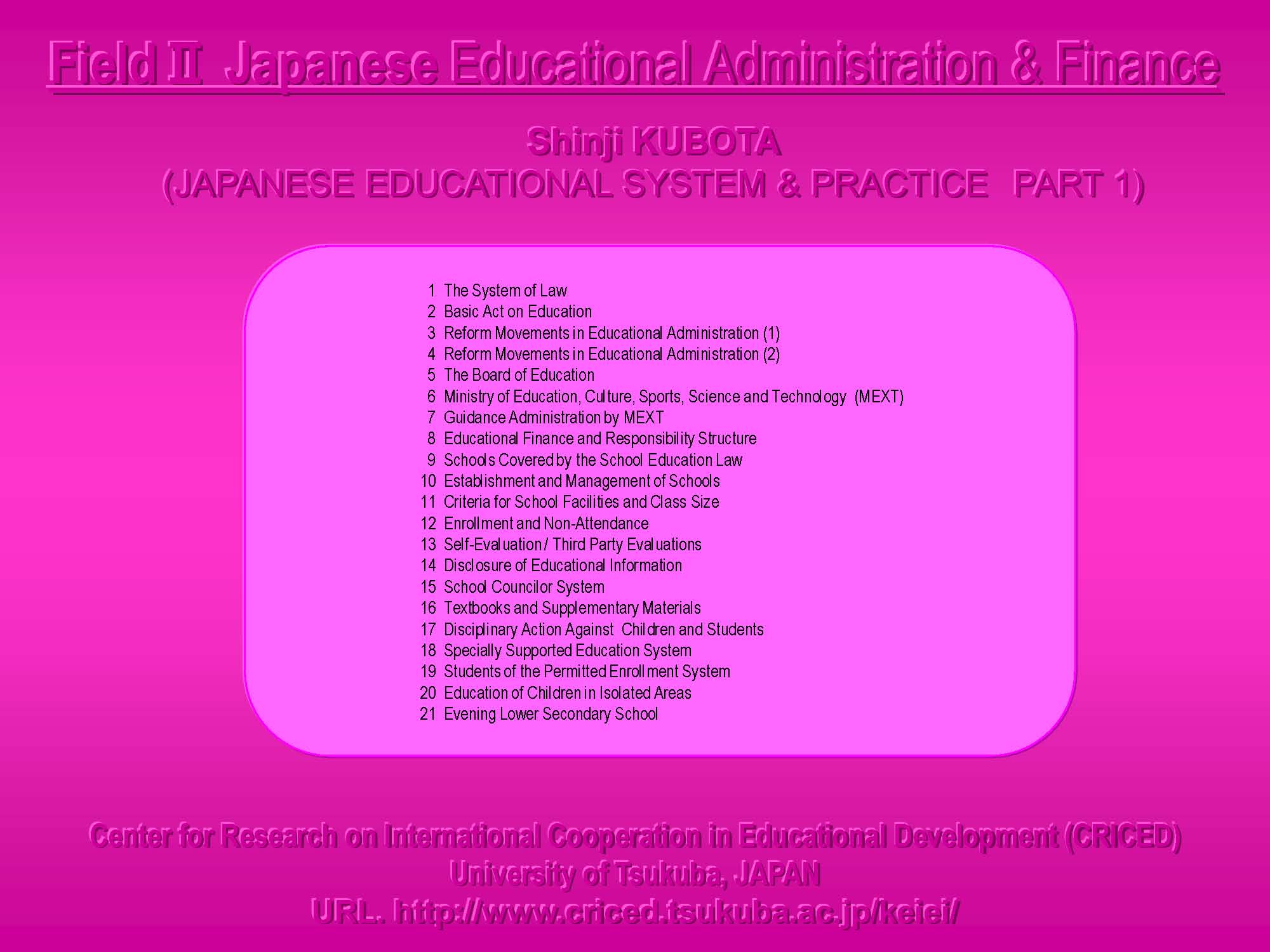 |
Download : II Japanese Educational Administration and Finance |
| 1 | 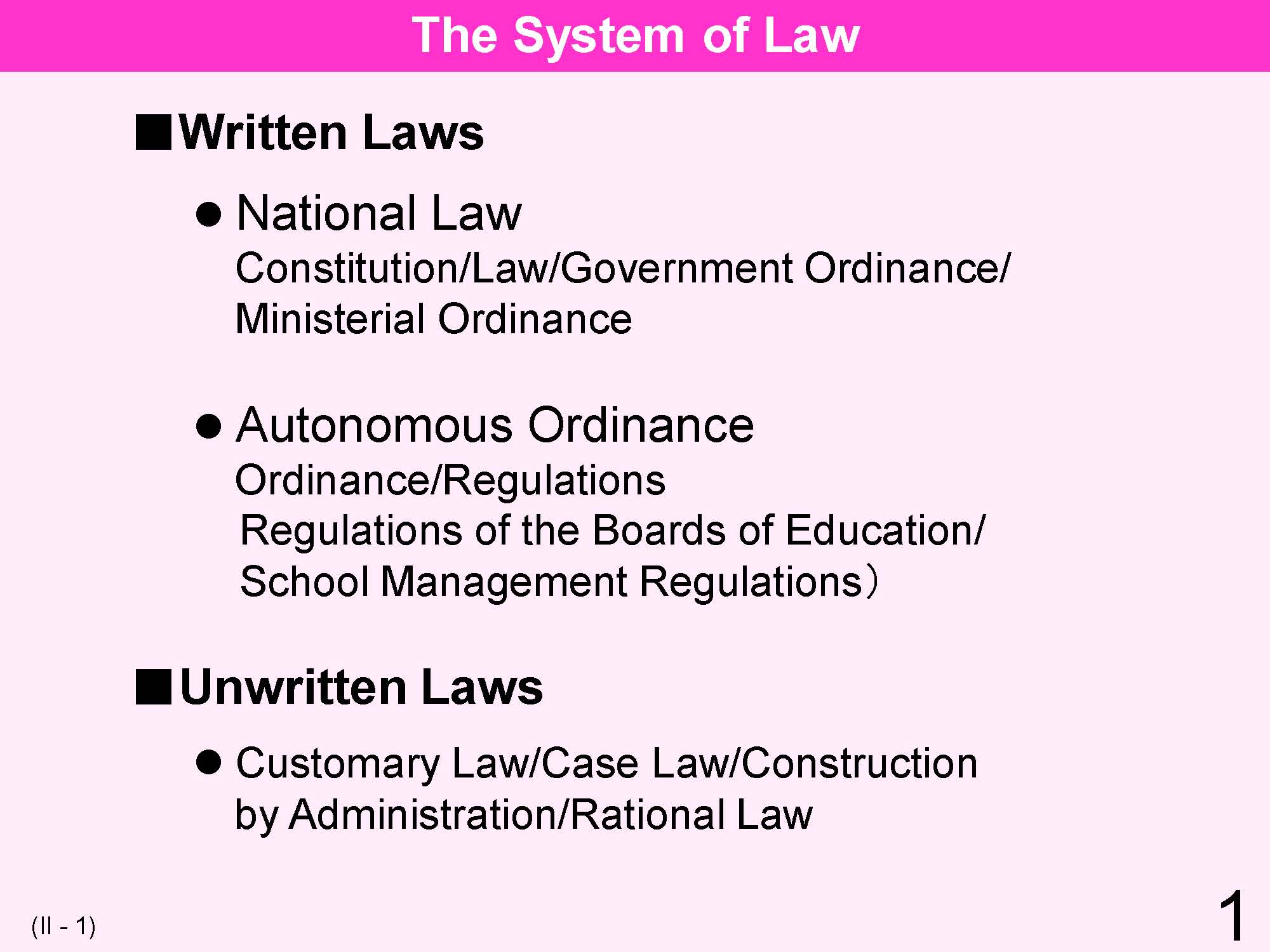 |
Japanese laws are composed of written laws and unwritten laws. Written laws in which the supreme statute is the Constitution of Japan, are divided into two types of law: one is national laws that are enacted by the Diet, the Cabinet and Ministries, while the other is autonomous ordinances provided by autonomous regional entities and other organizations. The kinds of unwritten laws are customary laws, case laws, construction by administration and rational laws. In Japan, construction by administration such as through notification and reply on provisions by the responsible Civil Service authorities has substantial function as law formulation. |
| 2 | 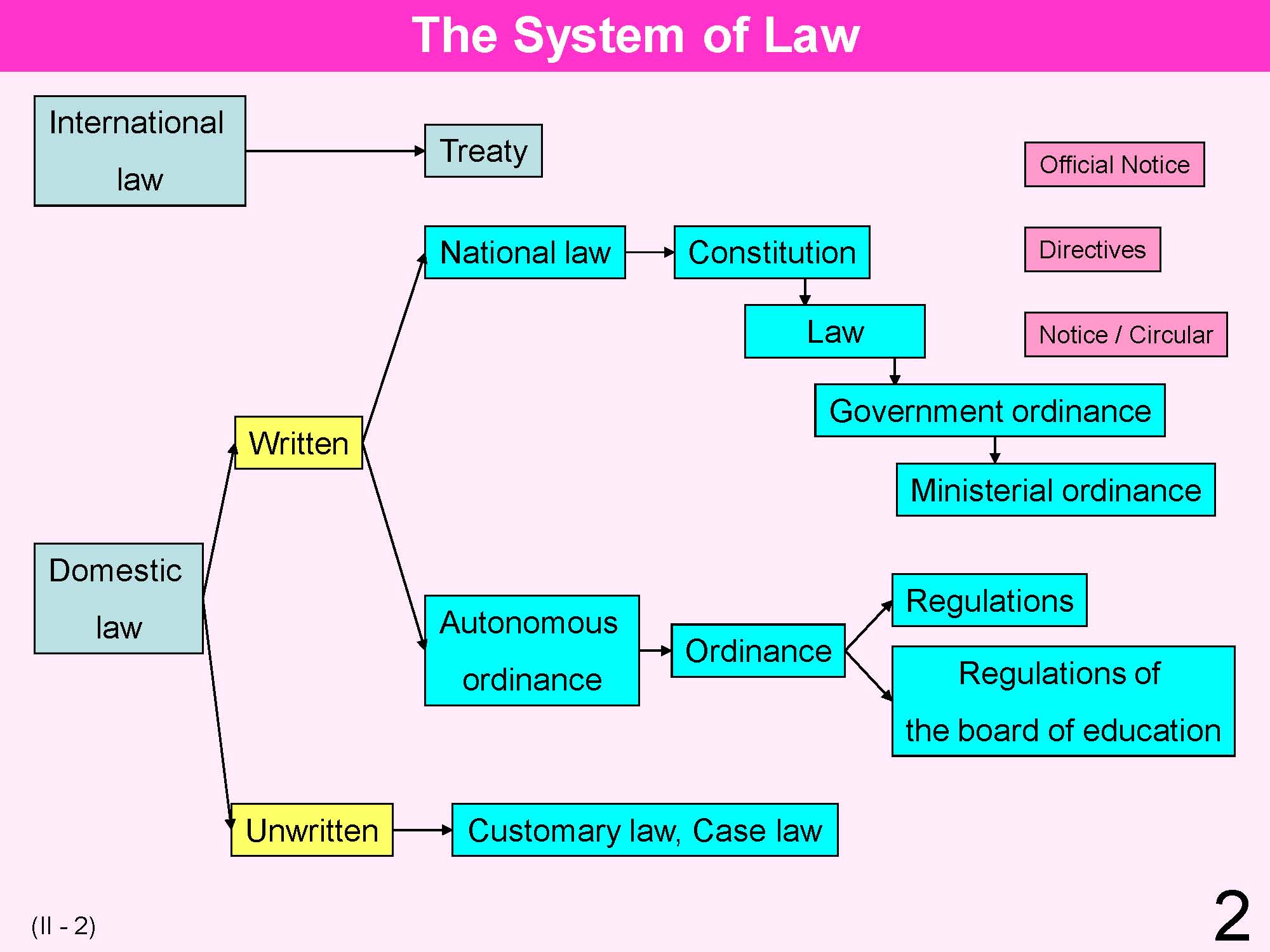 |
In this slide, the genealogy of the national law in statute form is briefly explained. Japan’s supreme law is the Constitution. The government ordinance is issued by the cabinet to utilize laws that are formed through concrete deliberations of the Congress, The ministerial ordinance is an order from the Ministers of State of each ministry or government office. For instance, in the School Education Act, the enforcement regulations of the School Education Act consist of ministerial ordinances. In the ministerial ordinance, the criteria for establishment of schools and textbook authorization are included. The official notice, directive, and the notice/ circular on the top right corner of the figure are issued by Ministers of State. However, when compared to ministerial ordinances which have legislative restraints, these alternatives carry legislative restraints. Therefore, penalties or sanctions aren’t applied if they are violated. Though the Course of Study is the directive, the administrators of curriculums who don’t follow the Course of Study are likely to be punished for violations of the enforcement regulations of the School Education Act, which provide that a curriculum has to be in line with the Course of Study. |
| 3 | 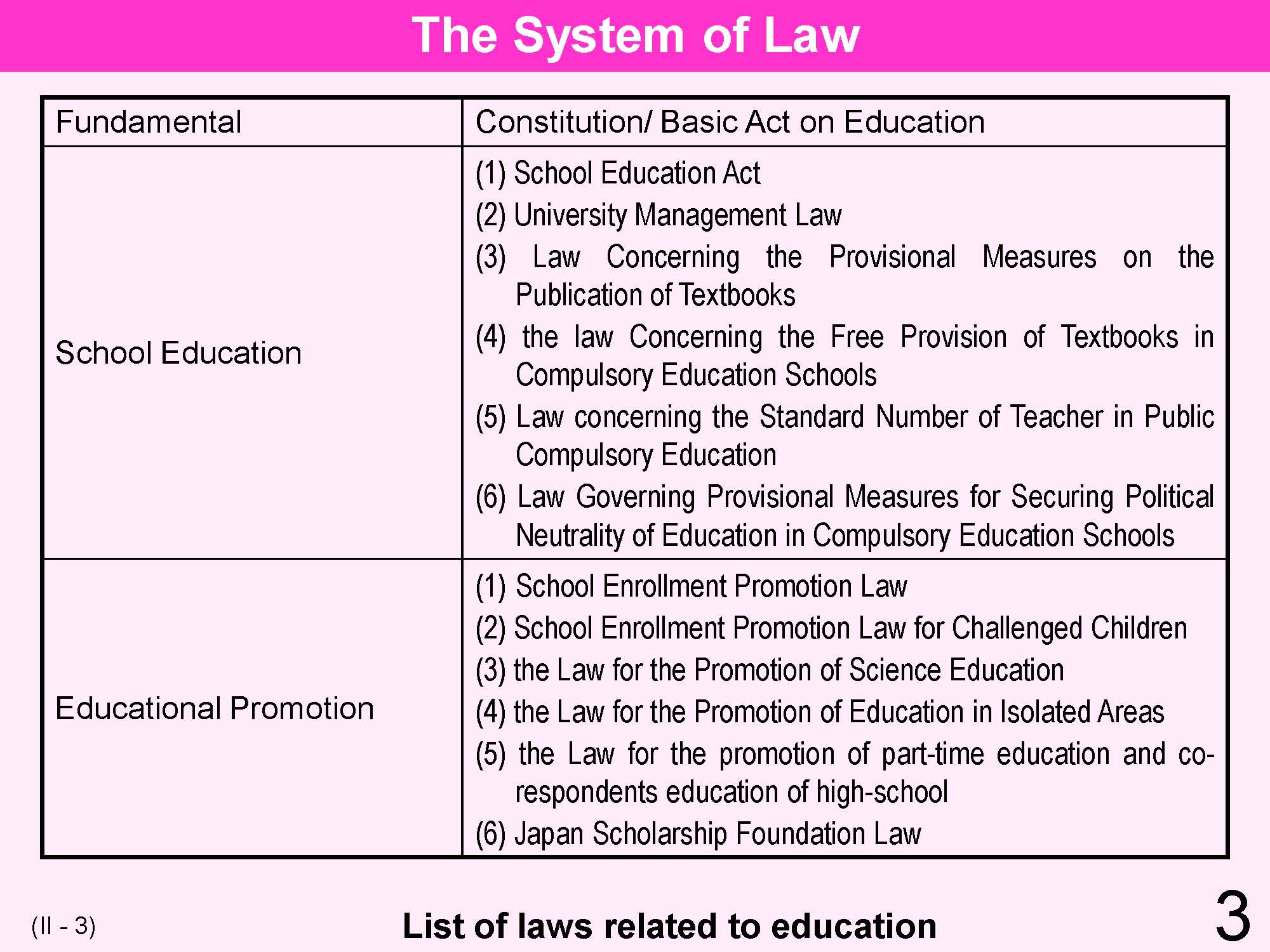 |
Various educational laws of Japan are based on Article 11 of the Basic Act on Education and were laid down as necessary laws for enforcement. In terms of their form as a law, the Basic Act on Education and other laws related to education have the same characteristics. However, because of its special features, the Basic Act on Education is treated in correspondence with the Constitution. ●Private schooling: ●Social education: ●Educational Laws: Law for the Special Regulations Concerning Educational Public Service / Law concerning Local Public Servants / National Public Services Personnel Law / Law on Share of Allowance / Law of Securing of Capable Educational Personnel / Special Measures Law for the Payment of Salary etc. to Educational Personnel / Educational Personnel Certification Law ●Educational Administration and Finance: Law concerning Local Administration and Finance / Autonomous Law / Ministry of Education Establishment Law / Local Financial Law / Law concerning Tax Grants of Local Government / Law concerning the National Treasury‘s Share of Compulsory Education Expenses / Law on Share of Allowance / Law concerning the National Treasury’s Share of Facilities Expenses / Law concerning Relief of Natural Disaster Expenditure / Extraordinary Treatment Law concerning Rebuilding of Dangerous Facilities of Public Senior High School / Law Governing Special Measures for the Establishment of Special Schools for the Challenged |
| 4 | 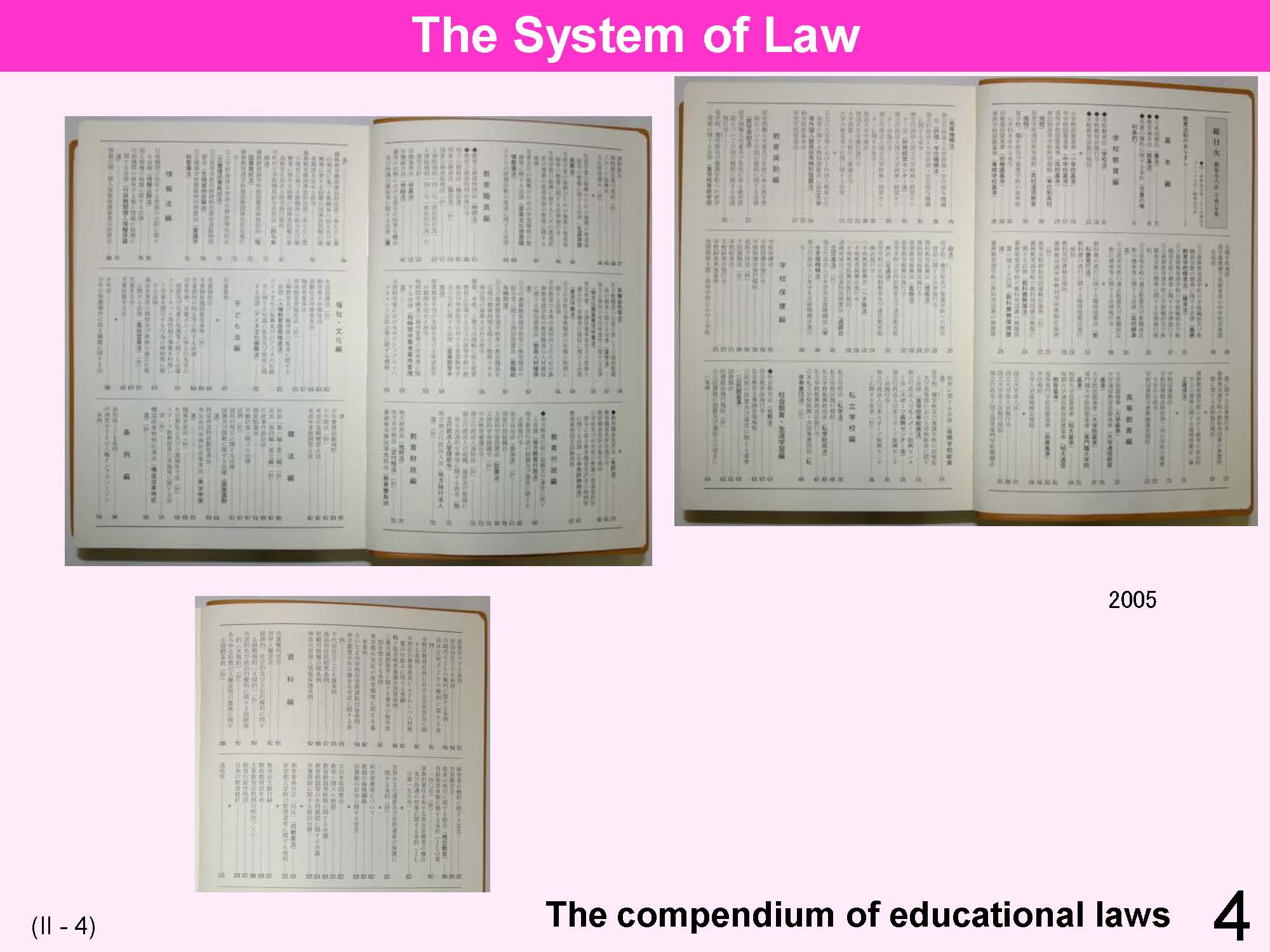 |
Every year, publishing companies publish a revised edition of the statute book related to education. This updated statute corresponds to changes in the field of education because of revisions of educational laws in sequence. Recently, educational institutions have been required to learn diverse laws even though such laws don’t directly relate to education, such as the Copyright Law. As a result, the volume of statute books has been increasing yearly. There is an indication that deregulation has helped to cause such increases in the revisions in laws. |
| 5 | 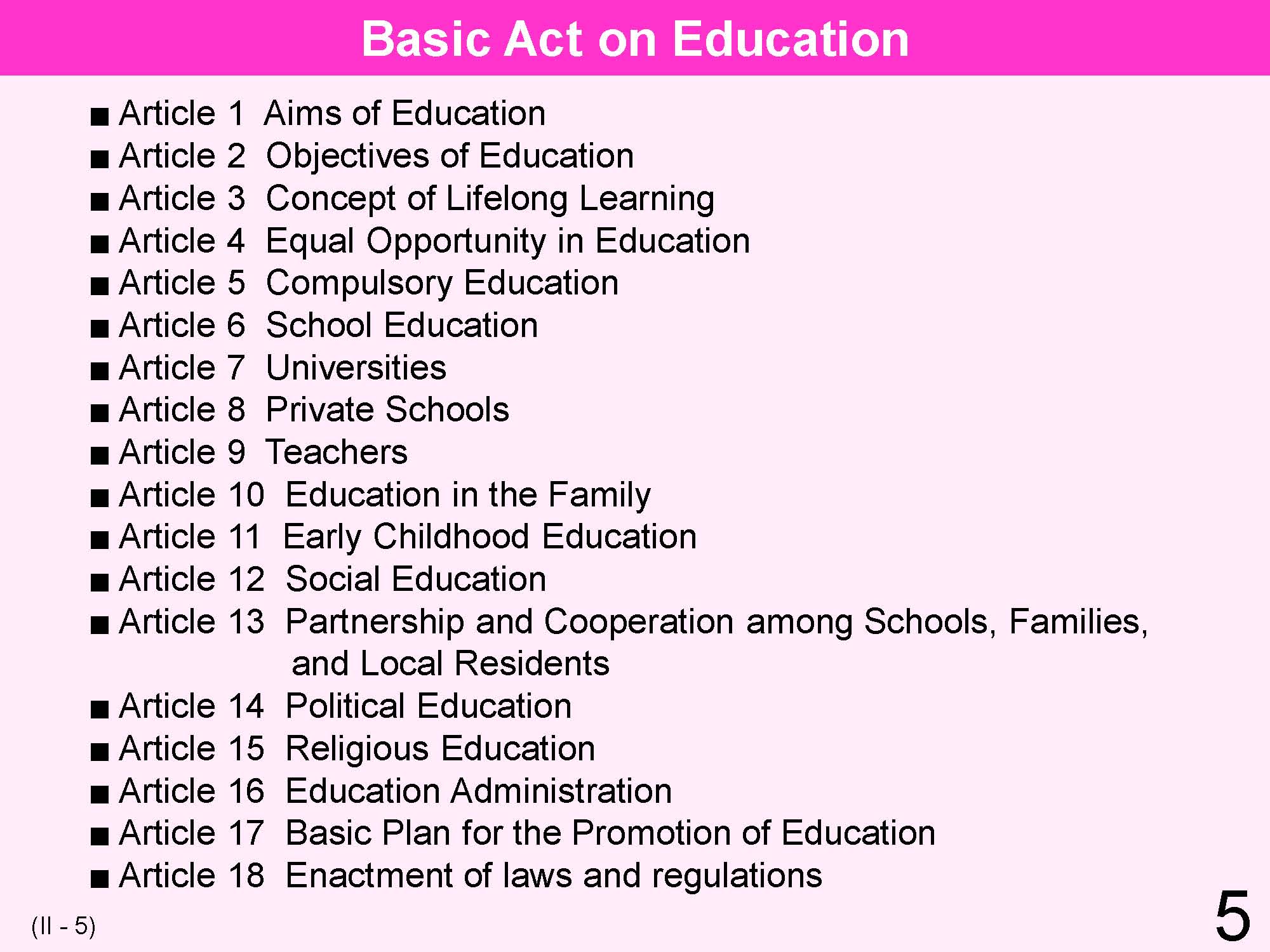 |
Chapter 1. Aims and Principles of Education (Aims of Education) Article 1 Education shall aim for the full development of personality and strive to nurture the citizens, sound in mind and body, who are imbued with the qualities necessary for those who form a peaceful and democratic state and society. (Objectives of Education) Article 2 To realize the aforementioned aims, education shall be carried out in such a way as to achieve the following objectives, while respecting academic freedom: (1) to foster an attitude to acquire wide-ranging knowledge and culture, and to seek the truth, cultivate a rich sensibility and sense of morality, while developing a healthy body. (2) to develop the abilities of individuals while respecting their value; cultivate their creativity; foster a spirit of autonomy and independence; and foster an attitude to value labor while emphasizing the connections with career and practical life. (3) to foster an attitude to value justice, responsibility, equality between men and women, mutual respect and cooperation, and actively contribute, in the public spirit, to the building and development of society. (4) to foster an attitude to respect life, care for nature, and contribute to the protection of the environment. (5) to foster an attitude to respect our traditions and culture, love the country and region that nurtured them, together with respect for other countries and a desire to contribute to world peace and the development of the international community. (Concept of Lifelong Learning) Article 3 Society shall be made to allow all citizens to continue to learn throughout their lives, on all occasions and in all places, and apply the outcomes of lifelong learning appropriately to refine themselves and lead a fulfilling life. (Equal Opportunity in Education) Article 4 Citizens shall all be given equal opportunities to receive education according to their abilities, and shall not be subject to discrimination in education on account of race, creed, sex, social status, economic position, or family origin. (2) The national and local governments shall provide support in education to persons with disabilities, to ensure that they are given adequate education in accordance with their condition. (3) The national and local governments shall take measures to provide financial assistance to those who, in spite of their ability, encounter difficulties in receiving education for economic reasons. Chapter2. Basics of Education Provision (Compulsory Education) Article 5 Citizens shall be obligated to have children under their protection receive a general education pursuant to the provisions of other acts. (2) The objectives of general education, given in the form of compulsory education, shall be to cultivate the foundations for an independent life within society while developing the abilities of each individual, and to foster the basic qualities necessary for those who form our state and society. (3) In order to guarantee the opportunity for compulsory education and ensure adequate standards, the national and local governments shall assume responsibility for the implementation of compulsory education through appropriate role sharing and mutual cooperation. (4) No tuition fee shall be charged for compulsory education in schools established by the national and local governments. (School Education) Article 6 The schools prescribed by law shall be of a public nature, and only the national government, local governments, and juridical persons prescribed by law shall be entitled to establish them. (2) The schools set forth in the preceding paragraph shall, in order to fulfill the objectives of education, provide a structured education in an organized way suited to the mental and physical development of the recipients. It shall be carried out in a way that emphasizes instilling the recipients with respect for the discipline necessary to conduct school life, and strengthening their own motivation to learn. (Universities) Article 7 Universities, as the core of scholarship activities, shall cultivate advanced knowledge and specialized skills, inquire deeply into the truth and create new knowledge, while contributing to the development of society by broadly disseminating the results of their activities. (2) University autonomy, independence, and other unique characteristics of university education and research shall be respected. (Private Schools) Article 8 Taking into account the public nature of privately established schools and their important role in school education, the national and local governments shall endeavor to promote private school education through subsidies and other appropriate means, while respecting school autonomy. (Teachers) Article 9 Teachers of the schools prescribed by law shall endeavor to fulfill their duties, while being deeply conscious of their noble mission and continuously devoting themselves to research and self-cultivation. (2) Considering the importance of the mission and duties of the teachers set forth in the preceding paragraph, the status of teachers shall be respected, their fair and appropriate treatment ensured, and measures shall be taken to improve their education and training. (Education in the Family) Article 10 Mothers, fathers, and other guardians, having the primary responsibility for their children’s education, shall endeavor to teach them the habits necessary for life, encourage a spirit of independence, and nurture the balanced development of their bodies and minds. (2) The national and local governments shall endeavor to take necessary measures supporting education in the family, by providing guardians with opportunities to learn, relevant information, and other means, while respecting family autonomy in education. (Early Childhood Education) Article 11 Considering the importance of early childhood education as a basis for the lifelong formation of one’s personality, the national and local governments shall endeavor to promote such education by providing an environment favorable to the healthy growth of young children, and other appropriate measures. (Social Education) Article 12 The national and local governments shall encourage education carried out among society, in response to the demands of individuals and the community as a whole. (2) The national and local governments shall endeavor to promote social education by establishing libraries, museums, community halls and other social education facilities, opening the usage of school facilities, providing opportunities to learn, relevant information, and other appropriate means. (Partnership and Cooperation among Schools, Families, and Local Residents) Article 13 Schools, families, local residents, and other relevant persons shall be aware of their respective roles and responsibilities regarding education, and endeavor to develop partnership and cooperation. (Political Education) Article 14 The political literacy necessary for sensible citizenship shall be valued in education. (2) The schools prescribed by law shall refrain from political education or other political activities for or against any specific political party. (Religious Education) Article 15 The attitude of religious tolerance, general knowledge regarding religion, and the position of religion in social life shall be valued in education. (2) The schools established by the national and local governments shall refrain from religious education or other activities for a specific religion. Chapter 3. Education Administration (Education Administration) Article 16 Education shall not be subject to improper control and shall be carried out in accordance with this and other acts; education administration shall be carried out in a fair and proper manner through appropriate role sharing and cooperation between the national and local governments. (2) The national government shall comprehensively formulate and implement education measures in order to provide for equal opportunities in education and to maintain and raise education standards throughout the country. (3) The local governments shall formulate and implement education measures corresponding to regional circumstances in order to promote education in their respective regions. (4) The national and local governments shall take necessary financial measures to ensure the smooth and continuous provision of education. (Basic Plan for the Promotion of Education) Article 17 In order to facilitate the comprehensive and systematic implementation of measures for the promotion of education, the government shall formulate a basic plan covering basic principles, required measures, and other necessary items in relation to the promotion of education. It shall report this plan to the Diet and make it public. (2) Local governments, referring to the plan set forth in preceding paragraph, shall endeavor to formulate a basic plan on measures to promote education corresponding to regional circumstances Chapter 4. Enactment of Laws and Regulations Article 18 Laws and regulations necessary to implement the provisions stipulated in this Act shall be enacted. |
| 6 | 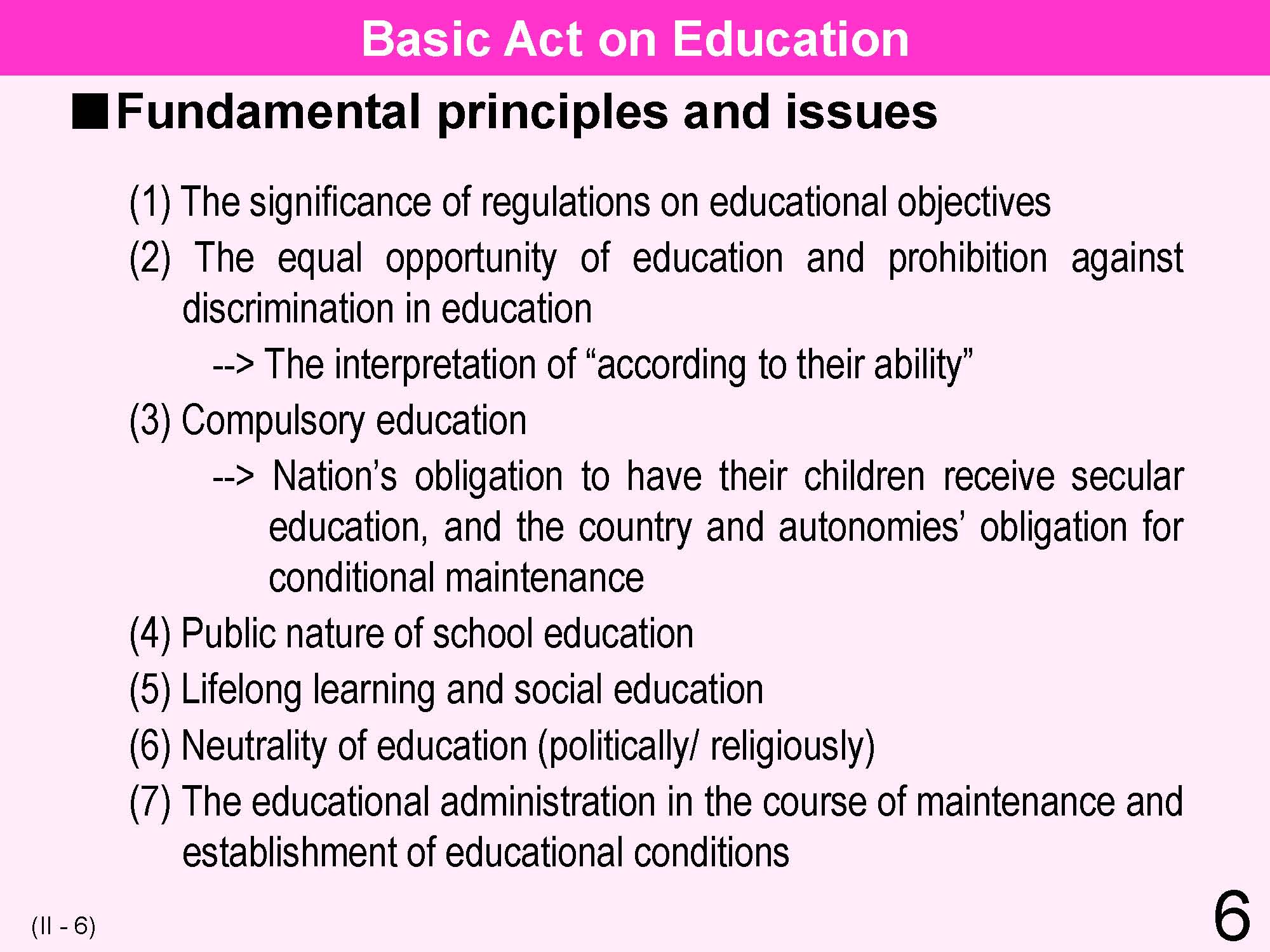 |
(1) Japan’s Basic Act on Education has regulations on educational objectives, and it was designed to eradicate the super-national education of the pre-World War II period. (2) Breaking economic barriers to receive education was a major objective of the Basic Act on Education system. The interpretation of education “according to ability” is unequivocal. (3) There is a discussion on the meaning of compulsory education, that is whether it means to enroll formally in schools as provided by the law or should it be understood in a broader sense. (4) There is a discussion on the public nature of education. (5) It includes the idea of lifelong learning and the relationship between lifelong learning and Social Education. (6) There is a sense of avoidance of politics and religion among teachers because of the strong demand for the political and religious neutrality in education. (7) There has been a discussion on the bounds of the state, that is how far it can participate in the stipulation and maintenance of appropriate educational conditions. |
| 7 | 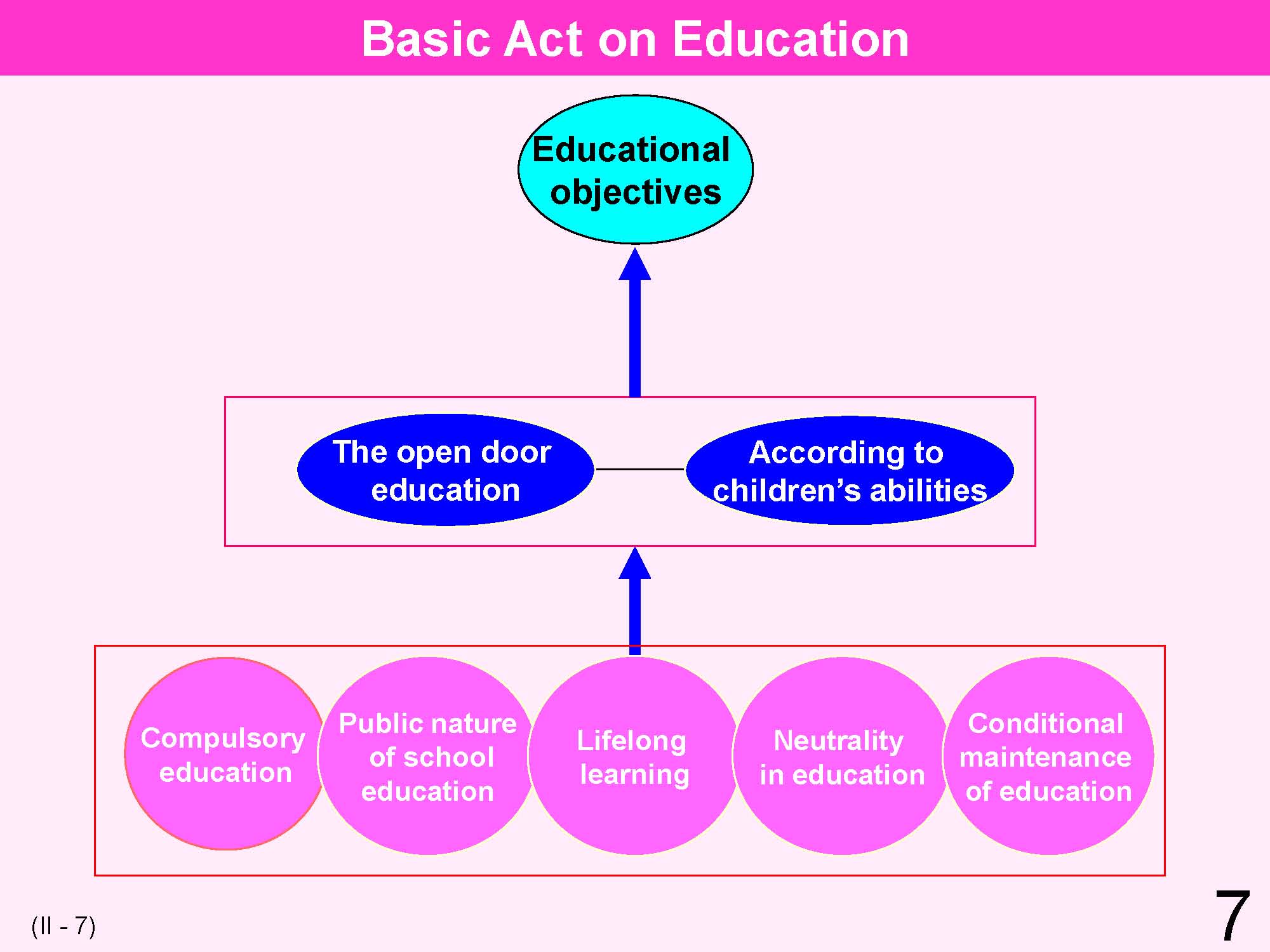 |
The basic principles of achieving educational objectives and goals are provision of equal opportunities for education and realization of education based on student abilities. To take specific measures, the following are necessary: development of compulsory education, assurance of public nature of education, provision of lifelong learning, maintenance of political neutrality of education (including religious neutrality, excluding private schools), and development of educational conditions such as human resources, equipment and facilities, educational contents, etc. |
| 8 | 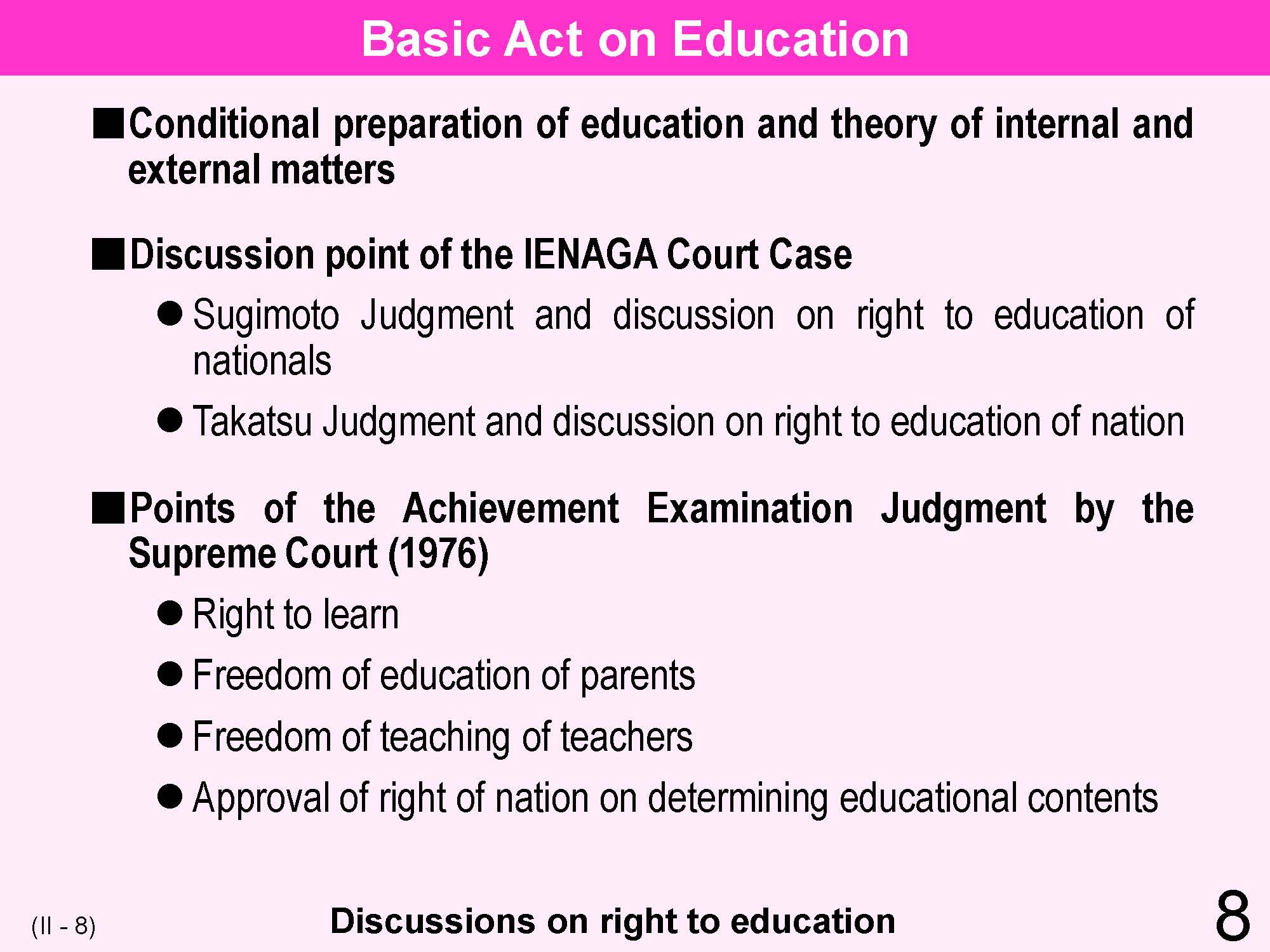 |
The review below mentions two key court cases and illustrates various arguments that were made concerning participation by the state in education, and that had a large influence on reforms of educational administration in Japan after World War II. Specifically, the Court Case on Textbooks, and the Court Case on the Achievement Examination dealt with the issues of citizens’ right to learn and on who in Japan has the right to education. It is clear that discussions on how much a nation should be involved in the education of Japanese nationals was one element that raised awareness of educational issues after the World War II. Namely, what type of educational administration is required and desirable? It was clear that initiatives for restructuring educational administration fell behind actual needs, such as mechanisms that could representative parents and promote community involvement, as well as to nurture school autonomy. These days, cooperation between the state (Ministry of Education, Culture, Sports, Science and Technology) and teachers (Association of Teachers in Japan) has increased substantially, thereby encouraging reforms on educational administration. |
| 9 | 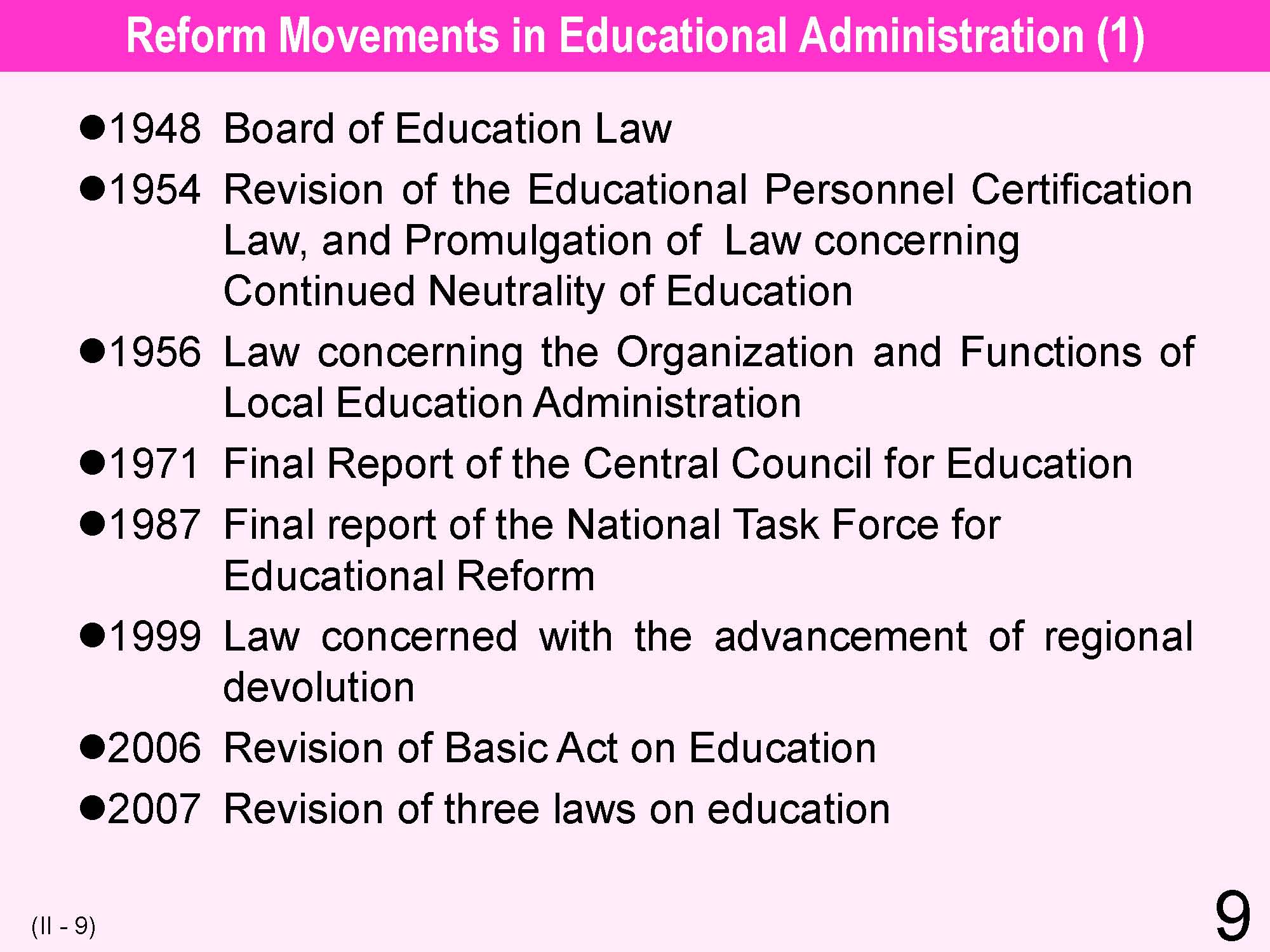 |
The adjacent flow chart shows that until the 1960s, post-World War II reforms focused mostly on educational administration. After the 1970s, reforms shifted from centralization to decentralization. The Board of Education Law in 1948 enabled Japanese educational administration to start over based on the principle of democratization. During the 1950s, when the key policy concern was to secure political neutrality in education, the Board of Education Law was revised and the Law concerning the Organization and Functions of Local Educational Administration was enacted. These reforms promoted centralization of educational administration. We can see the prototype of the educational reform steps taken since the 1980s in the Report of the Central Council for Education based on the three principles (respect for the individual, transition to a lifelong learning system, accommodation to the changes in society such as internationalization and information exchange). |
| 10 | 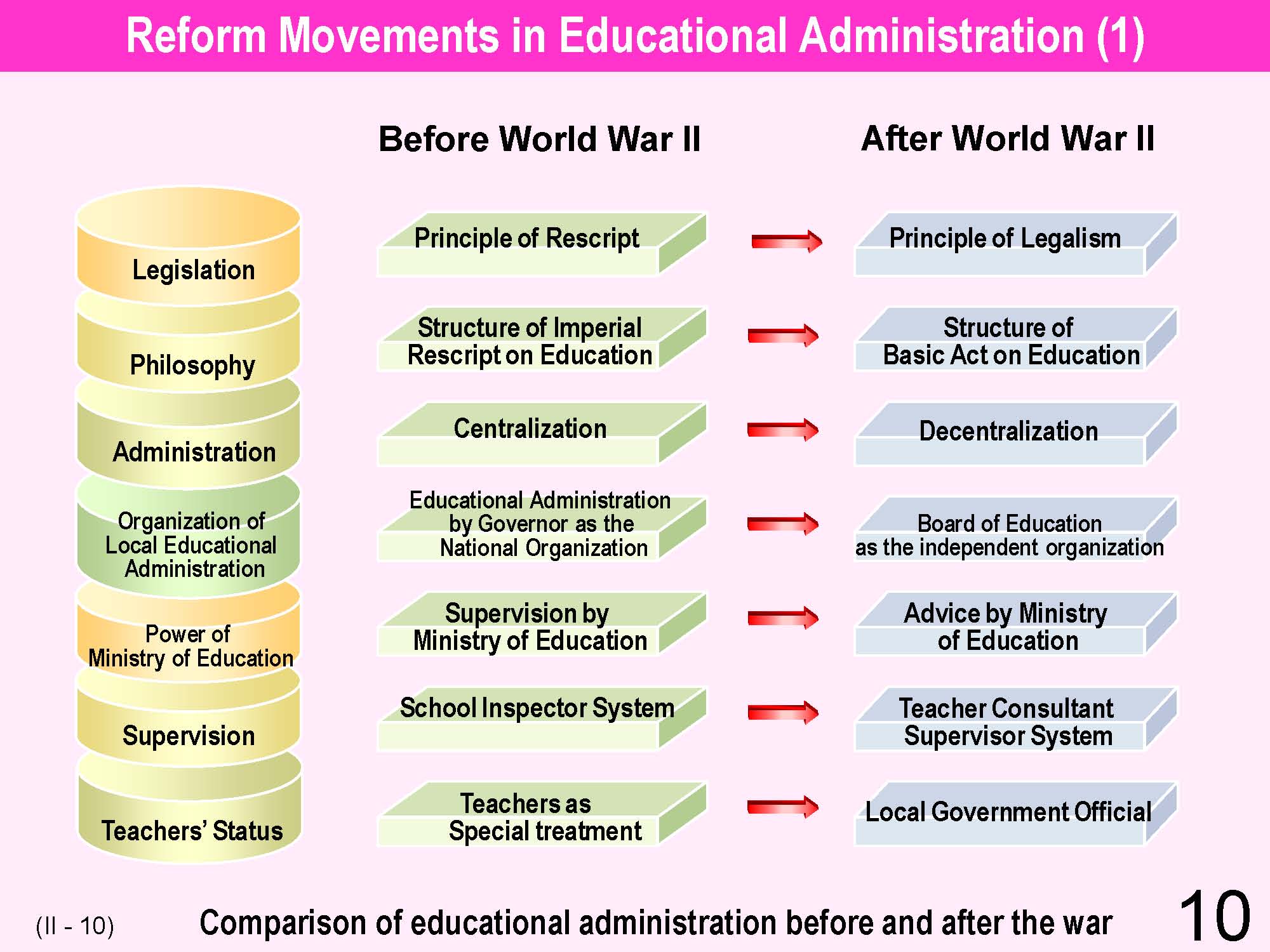 |
When comparing the pre-war and the post-war Japanese educational philosophy and responsibility there are three prominent features. First, before World War II, legislation re educational laws was based on the principle of Imperial Ordinance. After the war, it switched to the principle of legislative enactment embodied in the Constitution of Japan and the Basic Act on Education. Second, before the war, education was a national affair, not autonomous. While the Government was responsible for administration of schools and personnel management, regional entities were responsible for maintenance of school plan and the pay for teachers. After the war, whereas regions have responsibilities for education based on the principle of decentralization, the national government retains the functions to provide guidance and advice to the regional bodies. Third, before the war, educational authority in Japan was based on a top-down mechanism centered in the School Inspector System: Minister of Education (School Inspector) - Governor (Prefecture School Inspector and County School Inspector) - Mayor (Education Affairs Committee) - Principal and Teacher. After the war, however, the basic principle was adopted that the Ministry of Education and the Boards of Education are legally equivalent. |
| 11 | 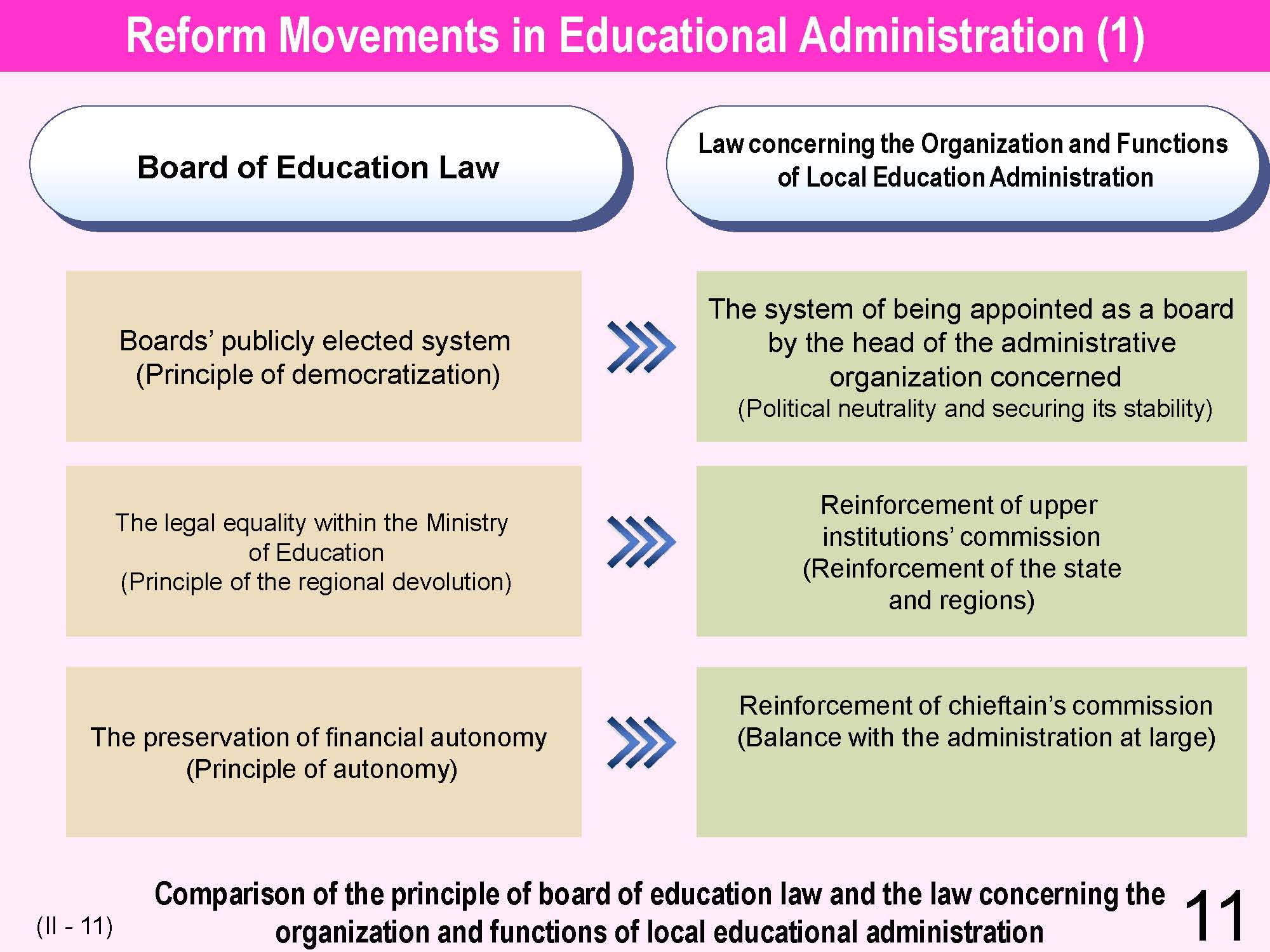 |
The adjacent Figure shows the meanings of the principle of democratization, regional devolution, and autonomy enacted by the Board of Education in 1948 as well as alterations under the Law concerning the Organization and Functions of Local Educational Administration. The revisions associated with recent decentralization are also mentioned. The Law concerning the Organization and Functions of Local Educational Administration distanced itself from the legislative substance of the Board of Education Law, with methods for activating Boards of Education remaining an issue. The Law concerning the Organization and Functions of Local Education Administration in 1999 restructured educational administration under general administration, involving repeals of aspects of decentralization such as the superintendent appointment system and the institution of commission affairs. |
| 12 | 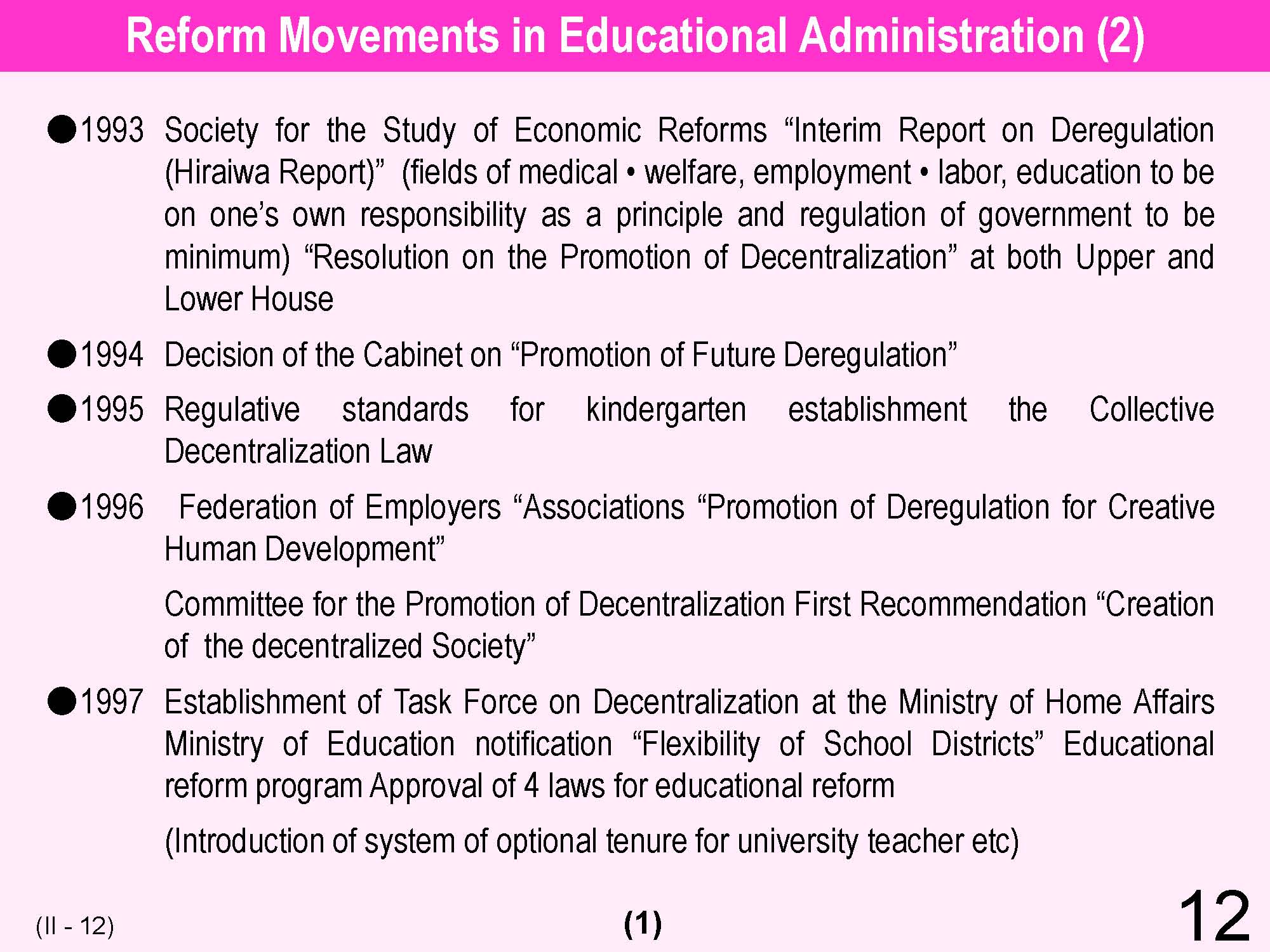 |
In a contemporary welfare state, where educational administration is required to actively provide education, the role of the central educational administration is strengthened and the financial burden on the state increases. As a result, reforms were needed in various aspects of educational administration and accompanying financial systems. These include i) the administration participation system, ii) implementation of educational plans, iii) preparation of an educational research system. A common problem of contemporary welfare states is that tax revenue levels are inversely proportional to the provision of welfare. A major feature of social reforms regarding education in developed countries during the 1980’s was deregulation. Deregulating countries entrusted their private sectors with public works projects or privatized nationalized industries, and promoted “small government, trying to activate their economic activities based on the principle of competition. Educational administration under a deregulation policy involves shifting the role of educational administration from a pre-regulated type to post-check-type, performing the important task of trying to maintain the public nature of services. While the educational administration of a welfare state attempts to control educational plans in order to carry out efficient educational undertakings with limited educational resources, the educational administrational approach under deregulation attempts to mobilize the energy of the private sector in order to maximize the value of money rather than educational plans, and to make effective use of competitive educational resources. |
| 13 | 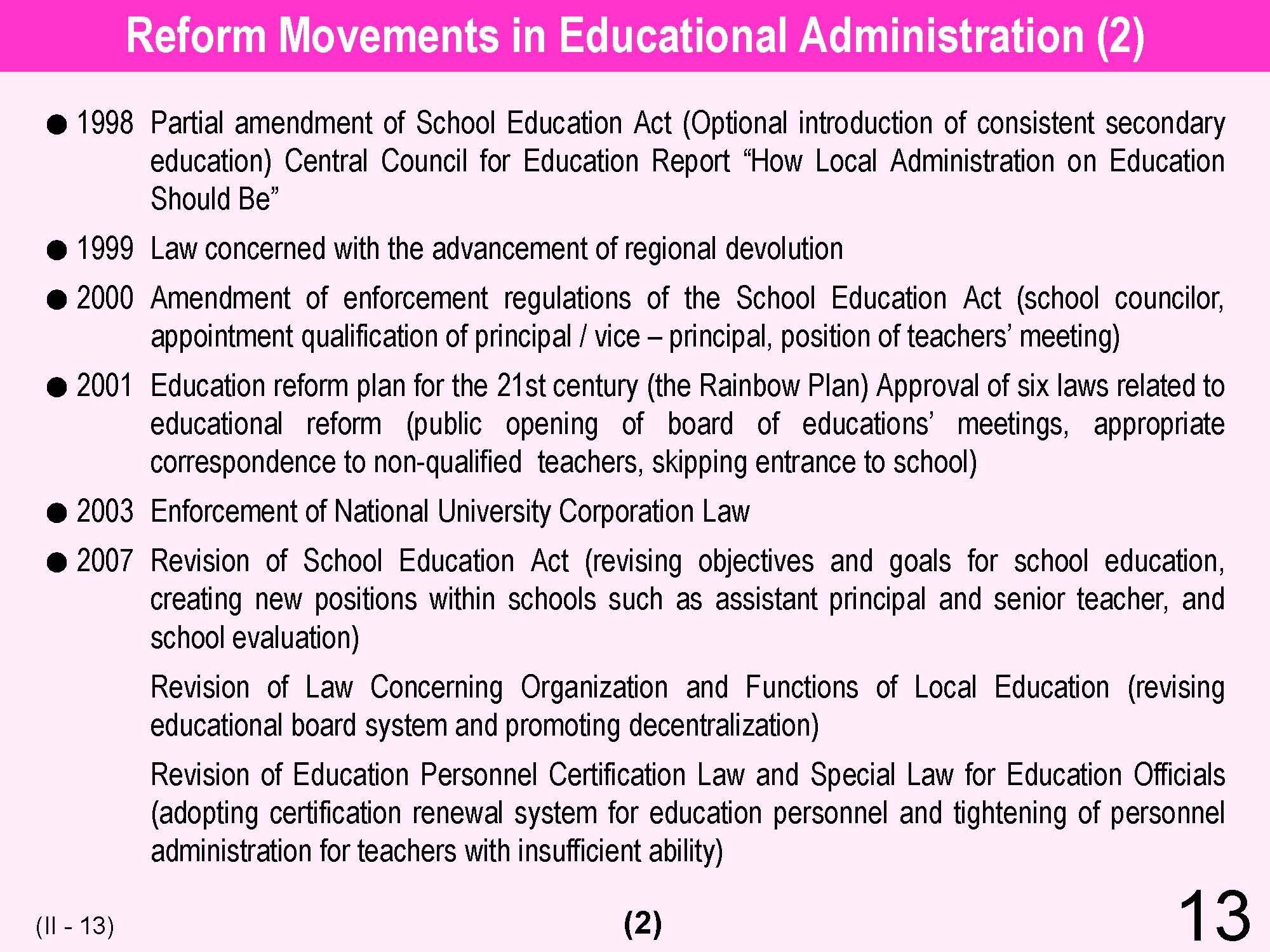 |
Based on the law concerned with the advancement of regional devolution (Omnibus Decentralization Act) of 1999, 475 laws concerning not only educational administration but other fields as well were amended to achieve decentralization in Japan. Among them, 21 education-related laws and government ordinances were revised. Besides that, the Enforcement Regulations of the School Education Act were revised in 2000. Due to the revision this time, the introduction of school councilor system, the relaxation of appointment qualification of principal and vice-principal, and the clarification of the position of teacher’s meetings were carried out. With the Educational Reform Program shown in the next slide as a basis, the Education Reform Plan for the 21st Century: the Rainbow Plan was established in 2001 and underwent several revisions to be the present basic policy for educational reform. |
| 14 | 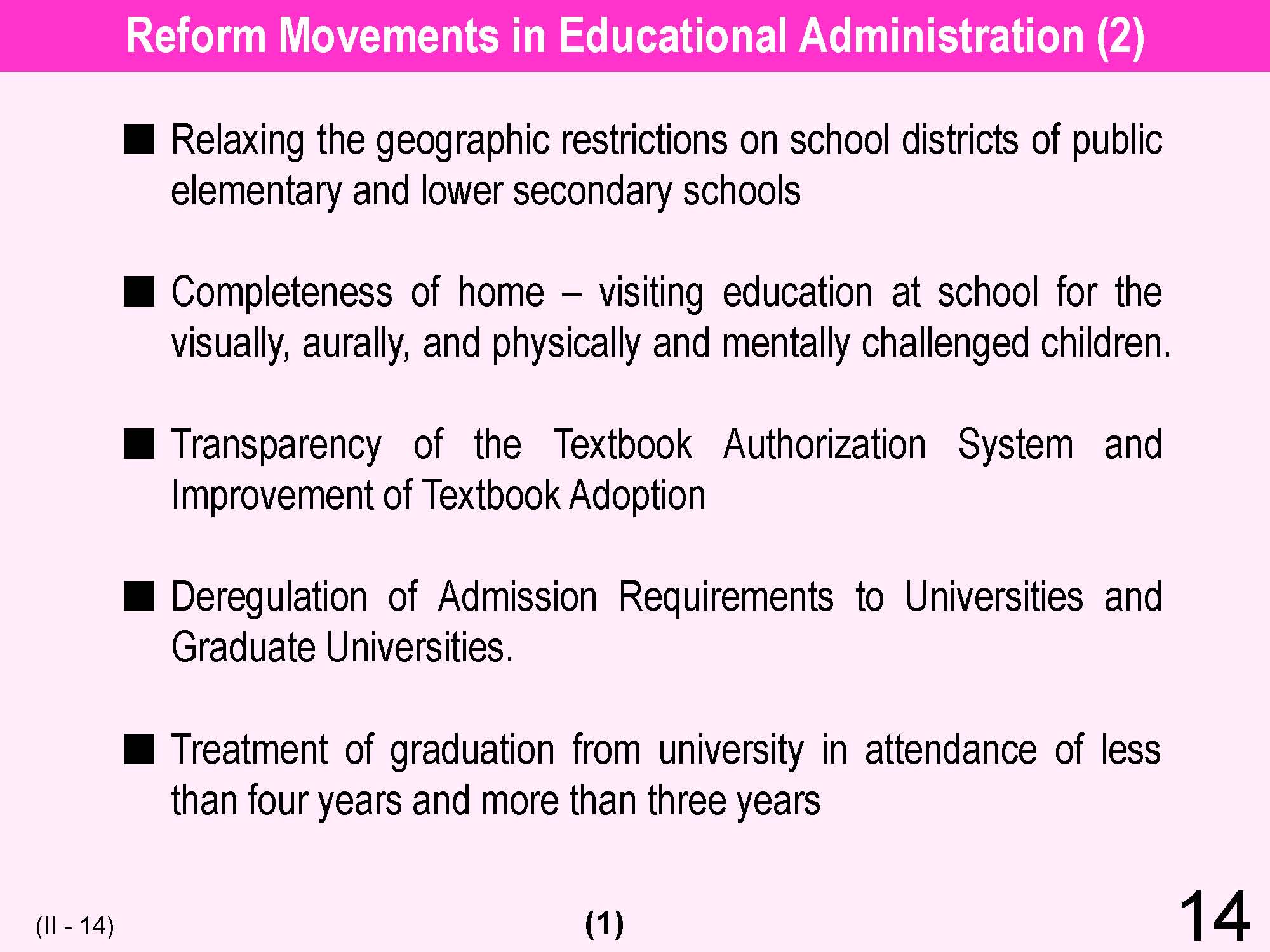 |
The Educational Reform Program is one of the six structural reforms carried out by the Hashimoto cabinet. After the announcement of the program in January, 1997, it was revised several times and finally the program was completed in September, 1999 (the sub-title “to forge an educational nation.”) The reform items on the program are steadily becoming institutions over time. |
| 15 | 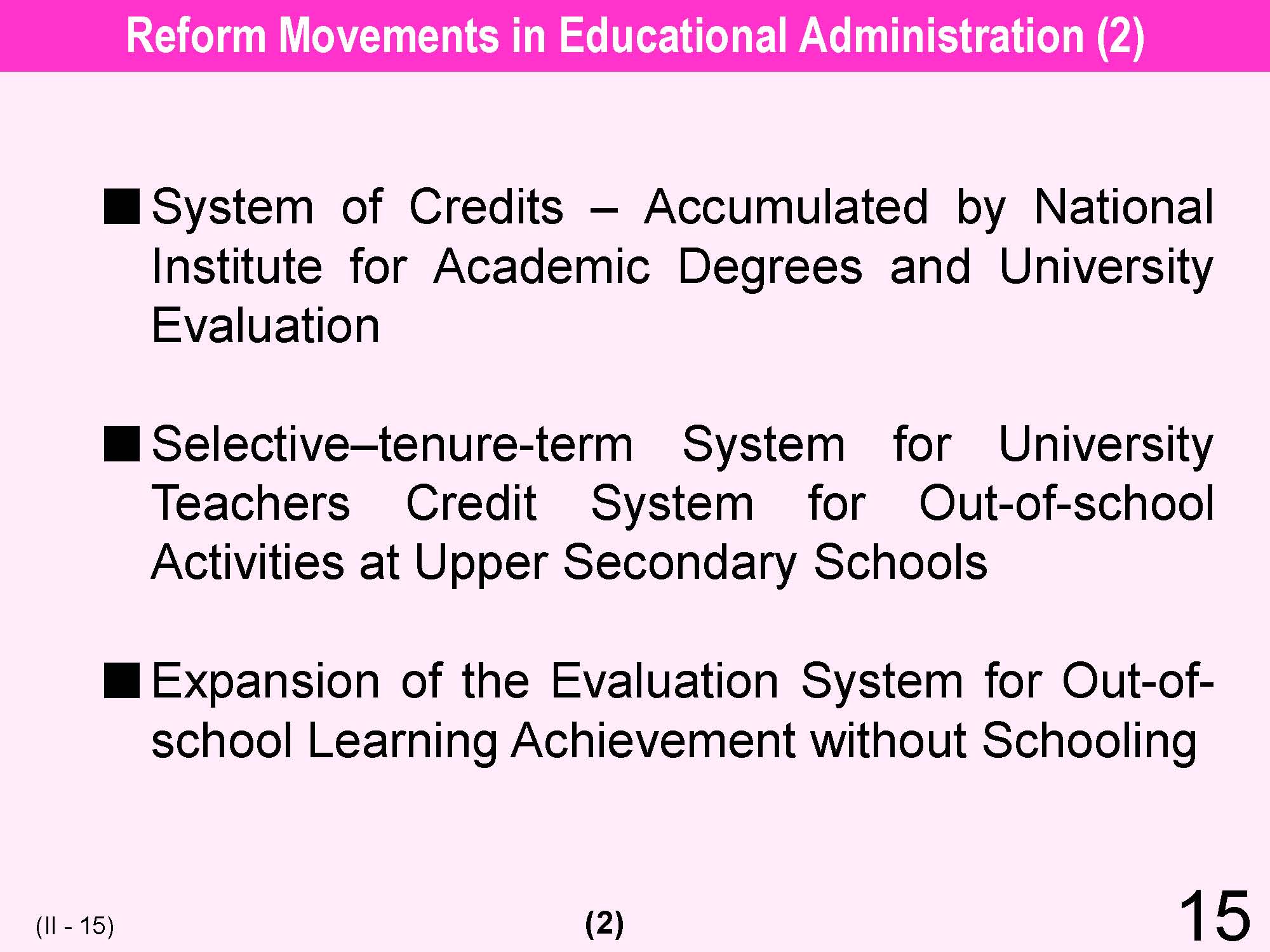 |
The Educational Reform Program is one of the six structural reforms carried out by the Hashimoto cabinet. After the announcement of the program in January, 1997, it was revised several times and finally the program was completed in September, 1999 (the sub-title “to forge an educational nation.”) The reform items on the program are steadily becoming institutions over time. |
| 16 | 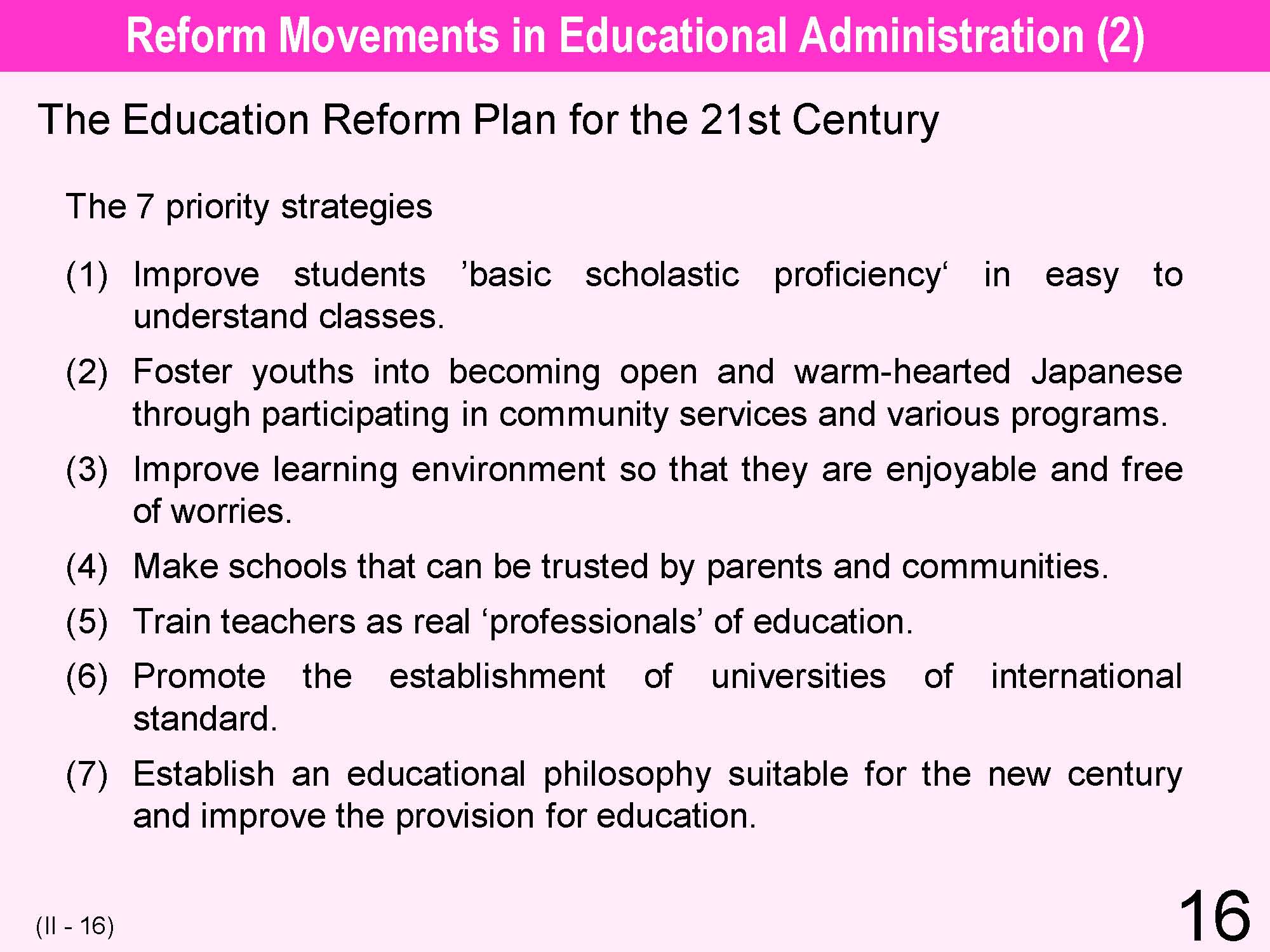 |
The progress of the seven priority strategies and their position in the overall Japanese educational policy are under discussion and review. Key aspects are as follows: (1)Increase in the number of teachers capable of providing small-group guidance, such as the 20 students per class system for fundamental subjects in public elementary schools and lower secondary schools. (2)Undertake decisions by the prefectural boards of education to set up exceptional standards regarding class size which fall below that of the average determined by the state. (40 students per class) =>Improve students’ basic scholastic proficiency ‘in easy to understand classes’. (3) Establish the ‘Children’s Dream Fund’ and implement programs (a) for children to experience nature, to conduct hands-on activities such as volunteer work (b) of subsidizing children’s book-reading activities such as book clubs => Enhance various hands-on and reading activities in the community. (4) Diversify the composition of members of the boards of education and recruitment of parents. Open meetings of the boards of education to the public. Provide greater discretion for principals to transfer school personnel. => activate boards of education. Transfer incompetent teachers to a different job. => Take appropriate measures on incompetent teachers The figure on http://www.mext.go.jp/a_menu/shougai/21plan/main_b2.htm or http://www.mext.go.jp/a_menu/shougai/21plan/p5.htm, http://www.mext.go.jp/b_menu/soshiki2/07.htm |
| 17 | 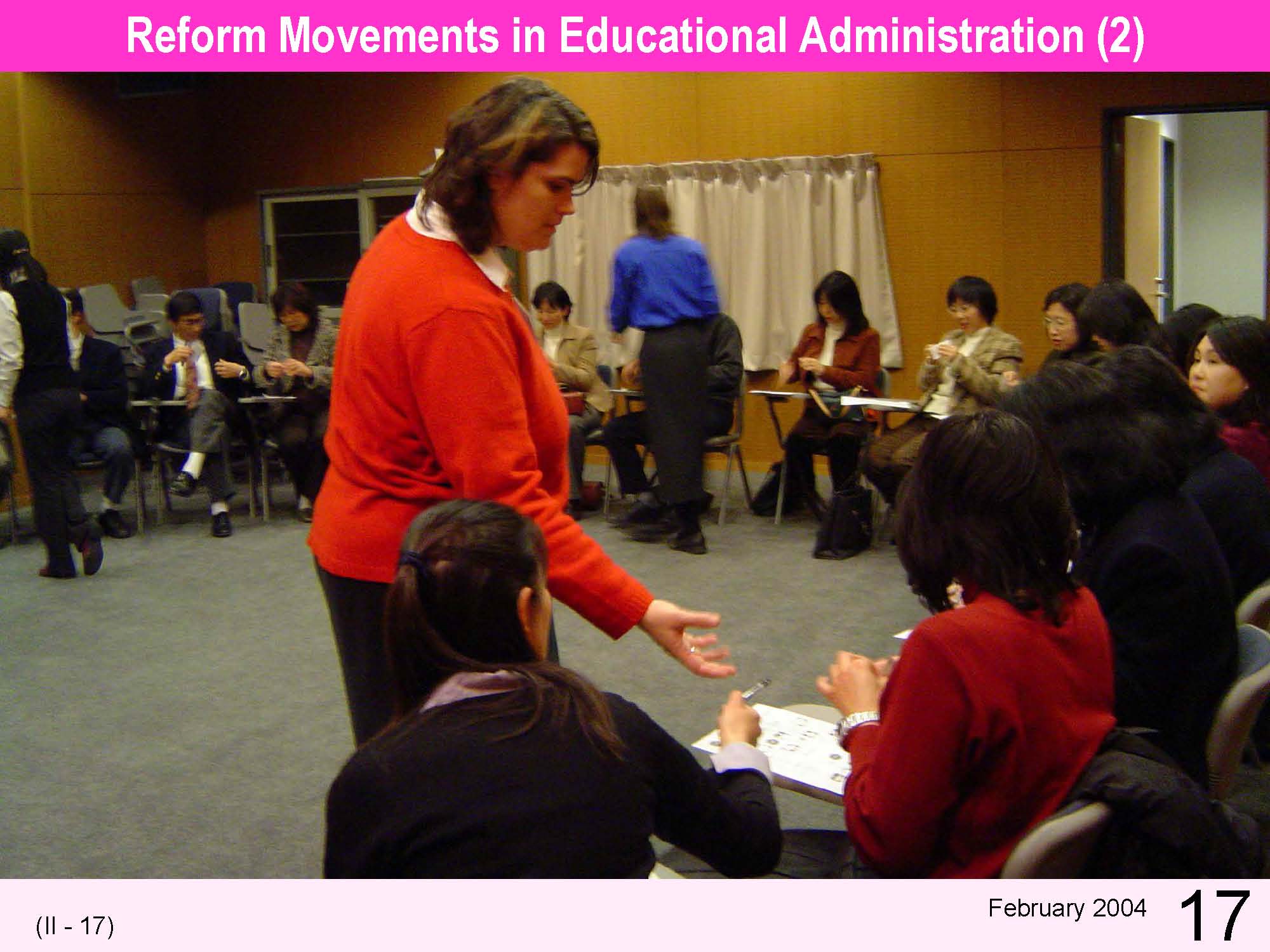 |
English Training for in-service teachers (from Kindergarten, elementary and lower secondary schools in an English education special zone in Mito, Ibaraki). Mito city will start English education in elementary school from next year as a special educational plan. |
| 18 | 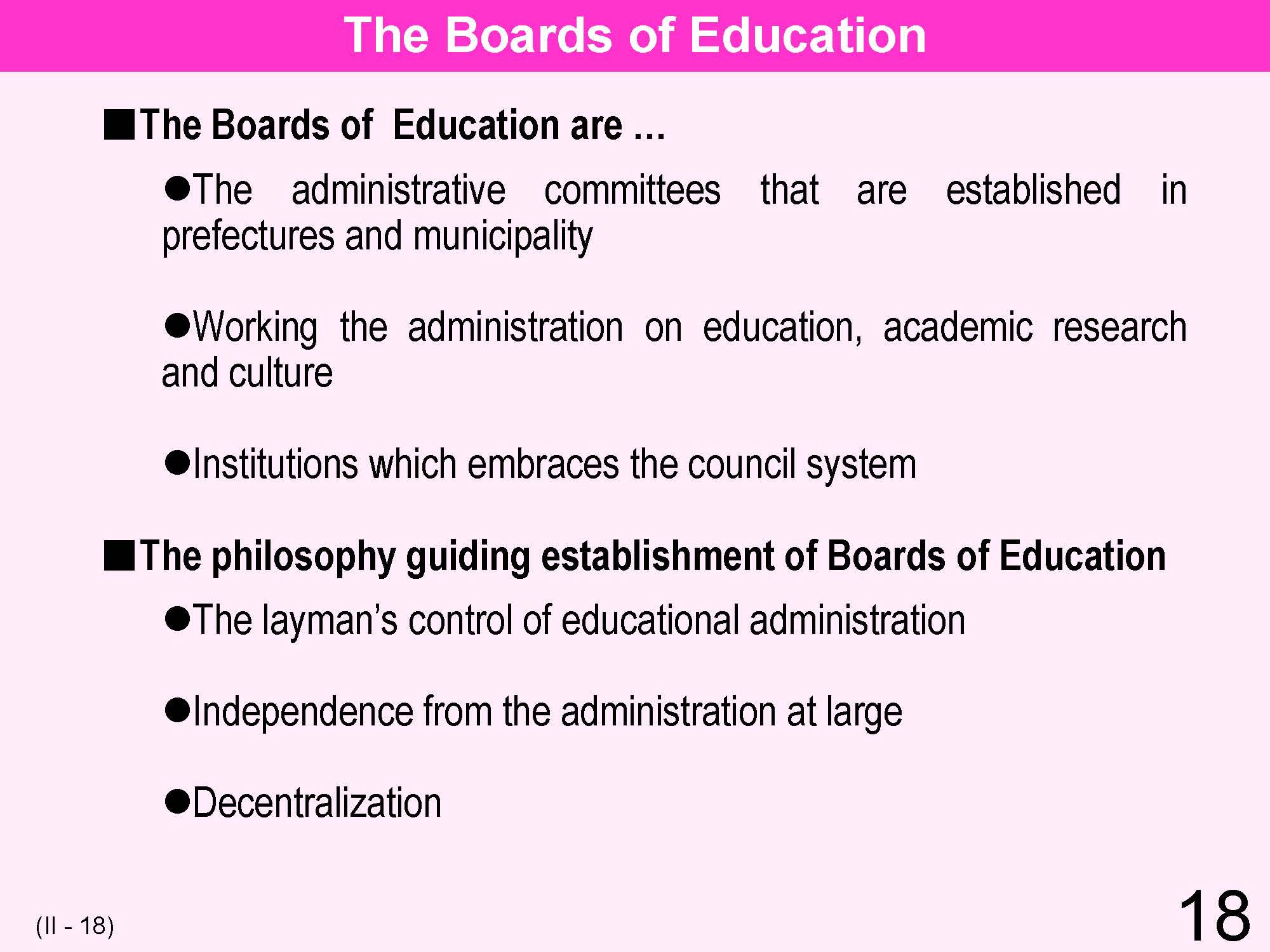 |
The Japanese Board of Education system was made by drawing from the example of America’s educational administrative system after World War II. While the latter system did not address Japan’s actual conditions, the concepts and philosophy of the Japanese system clearly reflect America’s Board of Education system. Aspects of the Japanese system are shown in the next slide. We will cover the philosophy, actual conditions, and issues re the Board of Education system that are central to educational administration in Japan. The Municipal Boards of Education which establish public elementary schools and lower secondary schools need to cooperate with the heads of municipalities regarding financing of general education because the boards don’t have authority over budgeting. Also, they need to explain the meaning and contents of the philosophy of independent general administration because municipality heads are concerned with educational administration. In addition, the distinction between the theoretical philosophical level and actual practice is needs clarification under decentralization policies, since these are directly linked to the recent revisions of the Law concerning the Organization and Functions of Local Education Administration. |
| 19 | 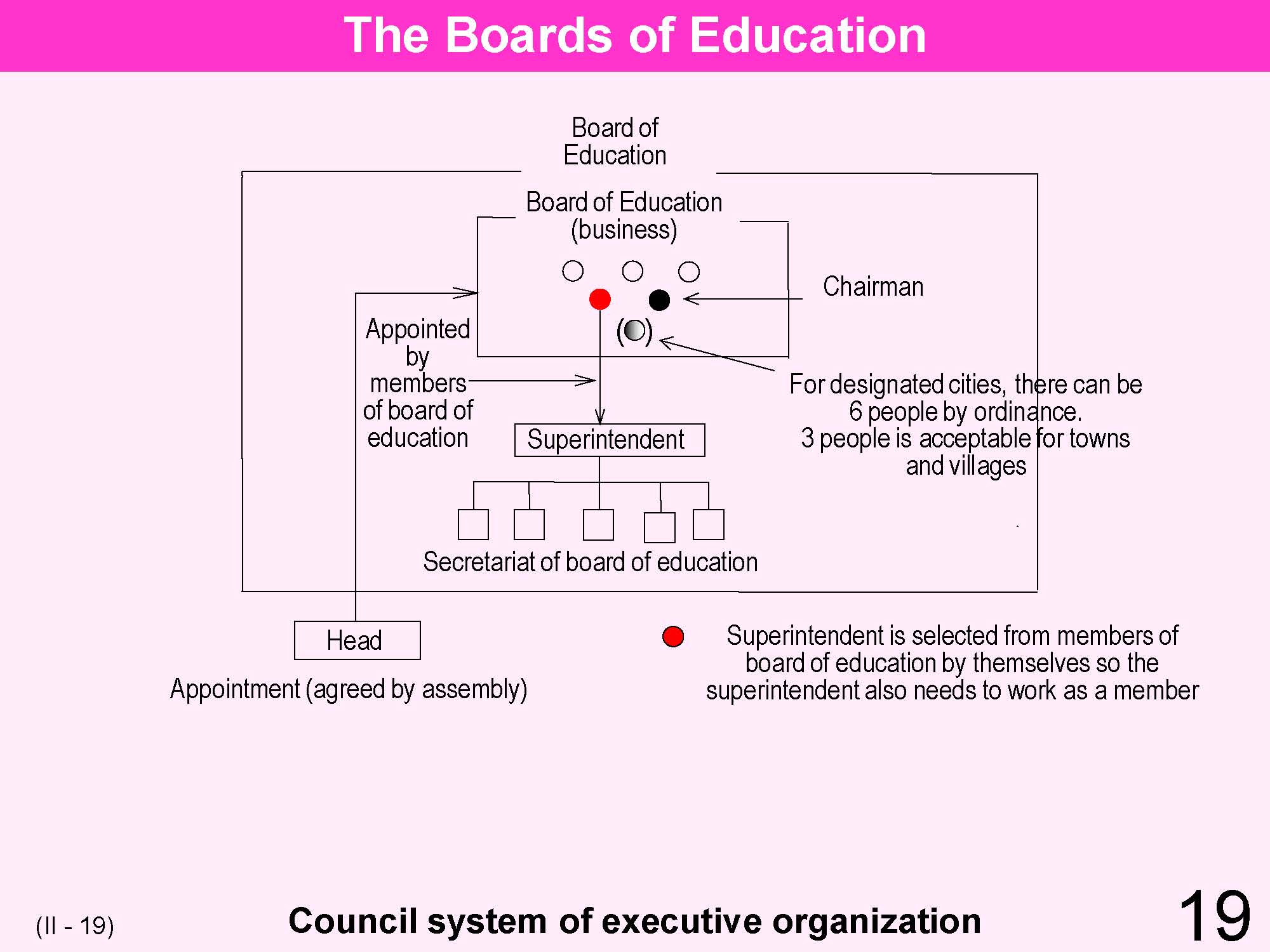 |
The board of education is a council system of organization that usually consists of five members. While the board of education has the right to decide policies about the management and enforcement of educational / academic / cultural administration from a broad point of view, a major duty of the superintendent of the board of education as an expert on educational administration is the actual execution of policies. The superintendent is required to attend all meetings of the board and to give advice on proceedings. The secretariat is also set up to deal with office work that is under the authority of the board’s scope of duties. The secretariat includes teacher consultant supervisors, clerical staff and technical staff. In this diagram, the sixth member of the board is listed in parenthesis. This indicates that the board of education “can consist of six people.” As indicated above, the secretariat is under the authority of the superintendent and is viewed as comprising a part of the board of education in a broad sense. |
| 20 | 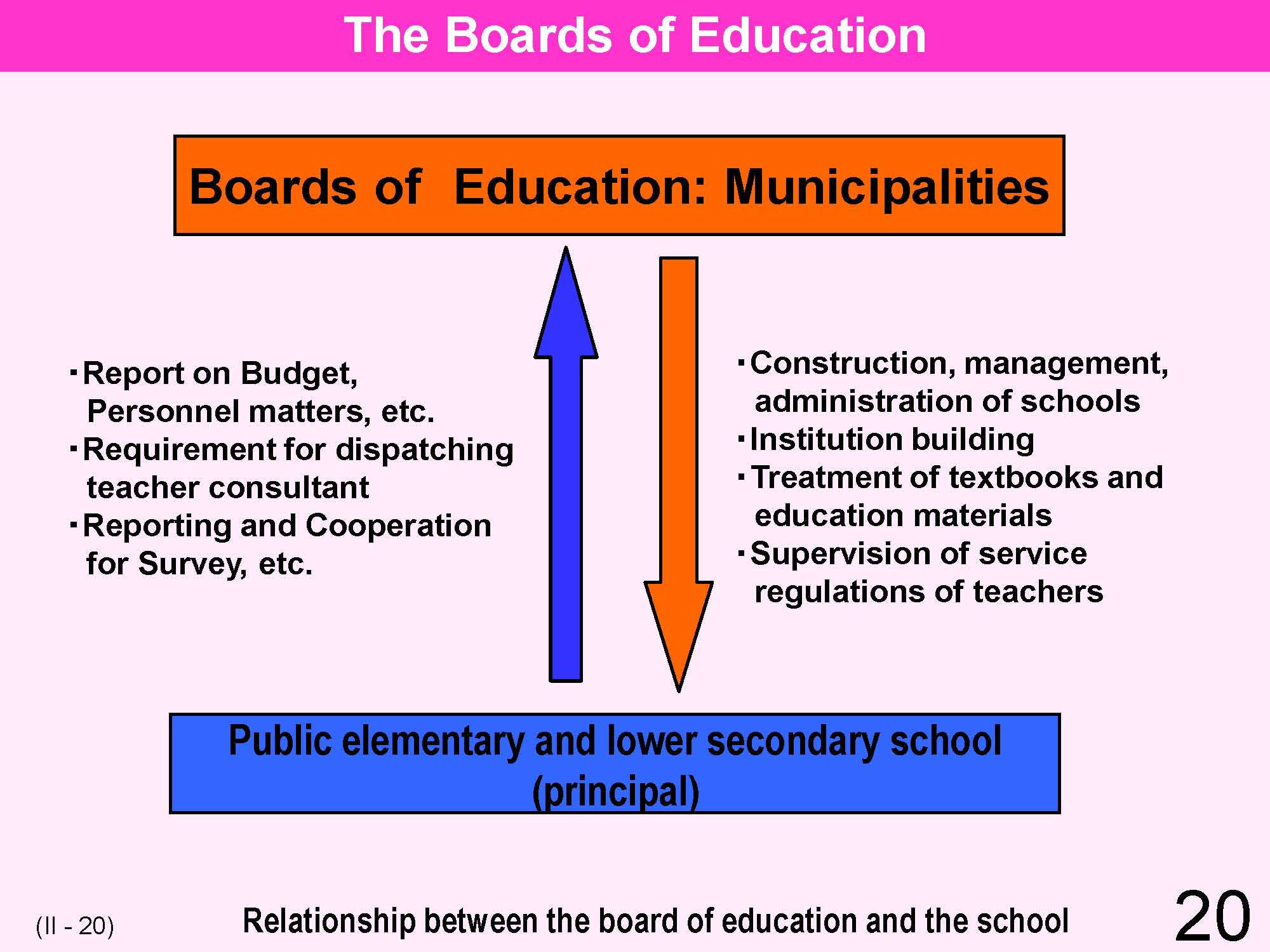 |
The above chart shows school related functions of general educational administration, academic research and cultural aspects, that are functions of the Boards of Education. This chart shows the relationship between the municipal boards of education and the founders of public elementary and lower secondary schools. The relationship between the prefectural board of education and private schools are omitted from the chart. Also, the items indicated by the arrow show the main features of the roles of the Boards of Education and public elementary and lower secondary schools and do not cover all the relationships between them. Typically, the relationship between the Boards of Education and schools was conflictual involving opposition. Recently, through educational administration reforms, such relationships have become more cooperative and collaborative. Local autonomous bodies have been set up that delegate additional rights to principals, such as budget implementation and school management that under the stronger authority delegated to principals has improved the rate educational progress. (Legal regulations of principal’s duty -->VI-15) |
| 21 | 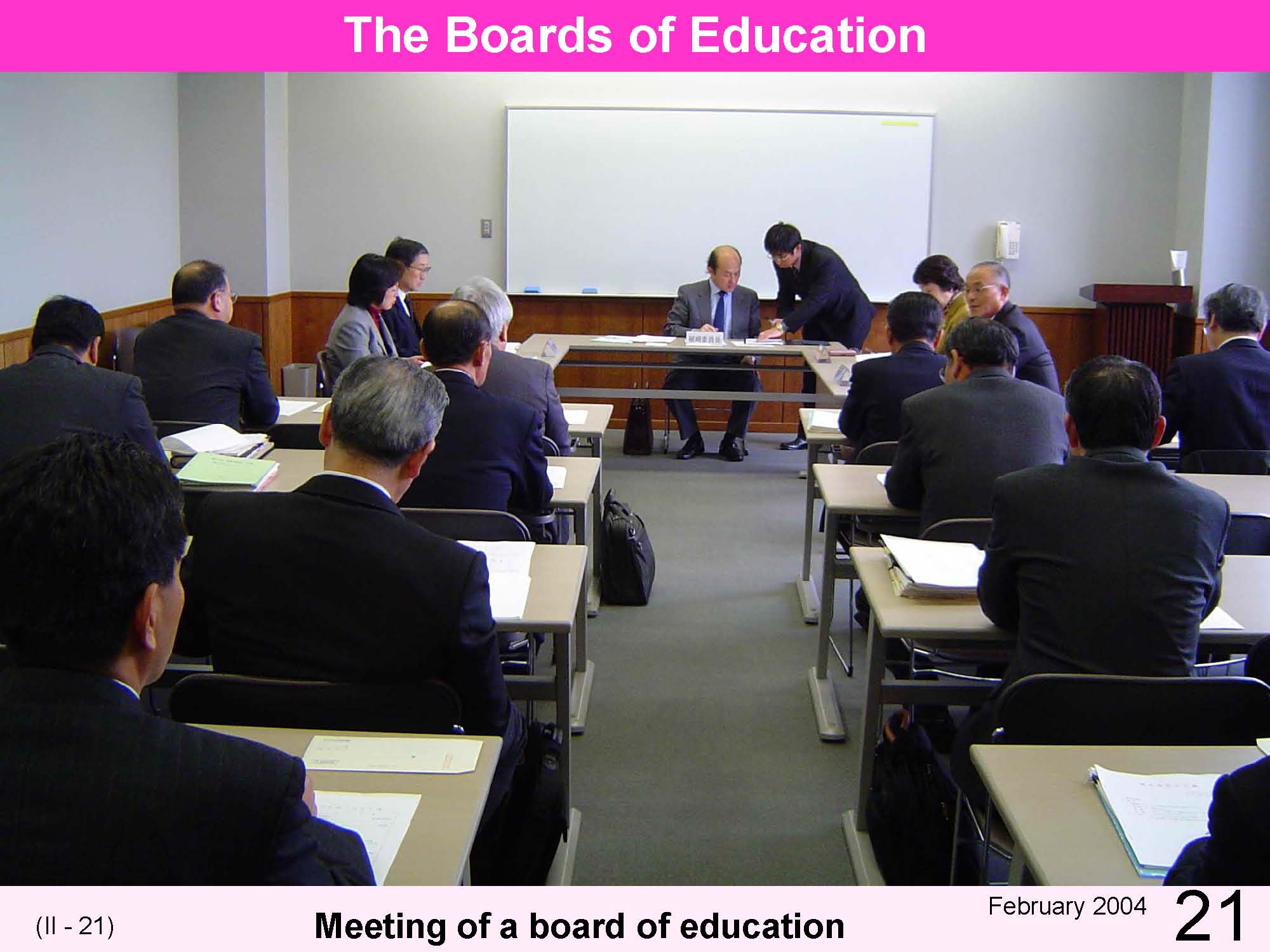 |
The decision-making of Boards of Education is done at meetings that are convened and presided by the superintendents of the boards of education who represent and act on behalf of the boards. The attendance of the chairpersons of individual boards of education and more than half of the committee members is needed to stage an official meeting and vote. The order of business is decided by the majority of committee in attendance, but if the pros and cons are equal, final decisions are referred to the chairpersons of the boards of education. Provided that decisions are viewed as fair, the committee will not discuss any aspects related to personal and business affairs of individual committee members. The meetings are basically open to the public as indicated by the presence of observers in the above picture. |
| 22 | 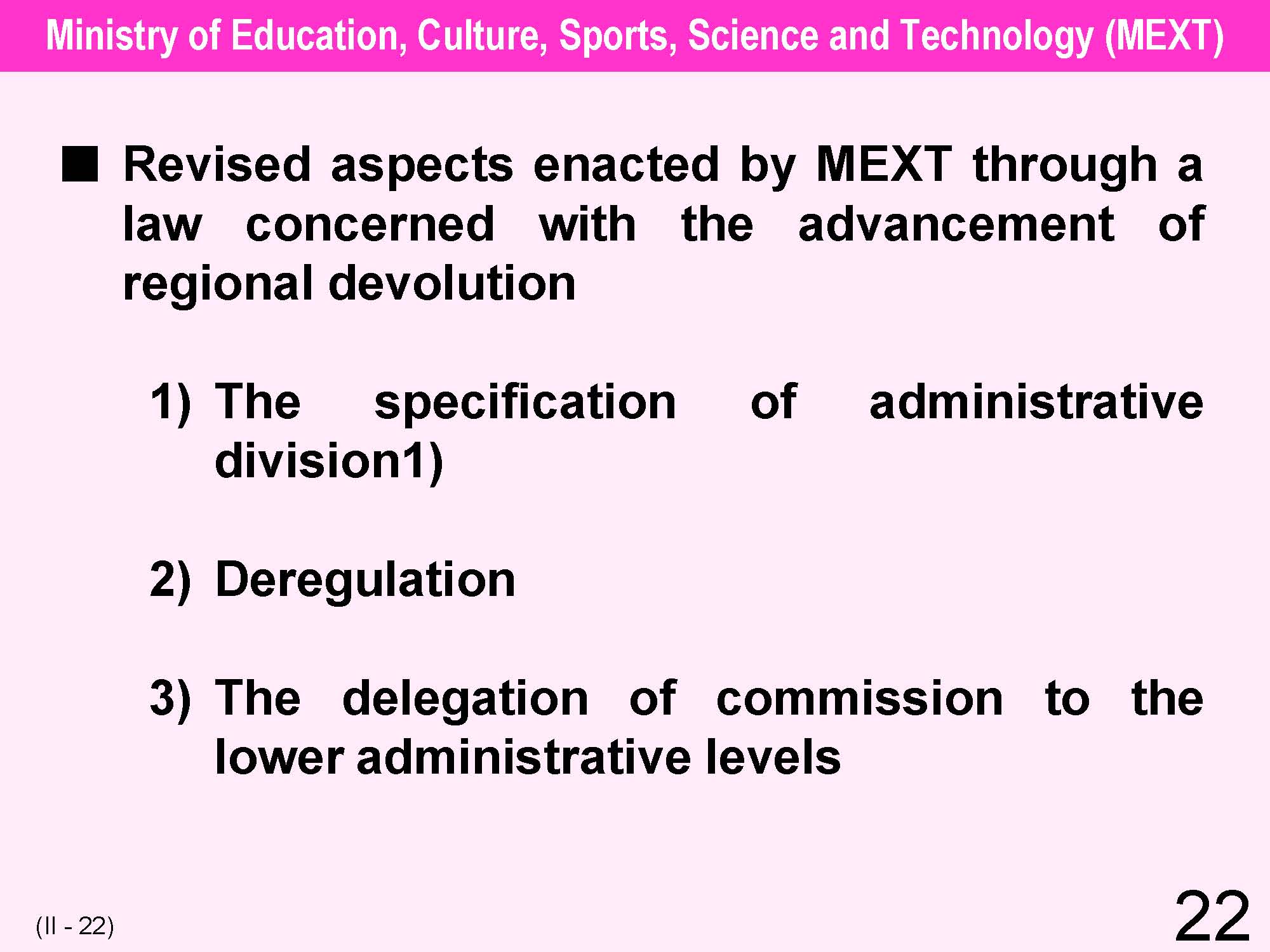 |
This slide shows aspects of revised functions of the government and local regional entities as a result of the establishment of Law concerning the Advancement of Regional Devolution and the Law concerning the Organization and Functions of Local Education Administration in 1999. The legislation made 475 laws concerning 23 ministries. The revisions that relate to the Ministry of Education, Culture, Sports, Science and Technology amount to 20 laws and one ordinance. The following points summarize the substance of the revisions. 1) Specification of administrative division Deletion of School Educational Act, Section 106 and clarification of the functions of the Supervision Agency. It also includes clarification of legal trust duties in the Private School Promotion Subsidy Law, Section 17. 2) Deregulation Changed provisions “give the general instruction” to “establish a technical standard” under the Law concerning the Organization and Functions of Local Educational Administration, Section43, Clause 4, “shall / should do” becomes “allowed to do” in the same law, Section 48, Clause 1, and “approval” shifts to “consultation and agreement” in regulations concerning the standard class-size and the fixed number of educational personnel at public compulsory schools. 3) The delegation of commission to the lower part For example, the Law concerning Organization and Management of Local Education Administration abolished the followings: “Appointment and approval” of superintendent of boards of education “Authorization” to boards of education of designated cities by prefectural boards of education “Authorization” concerning secondary school |
| 23 | 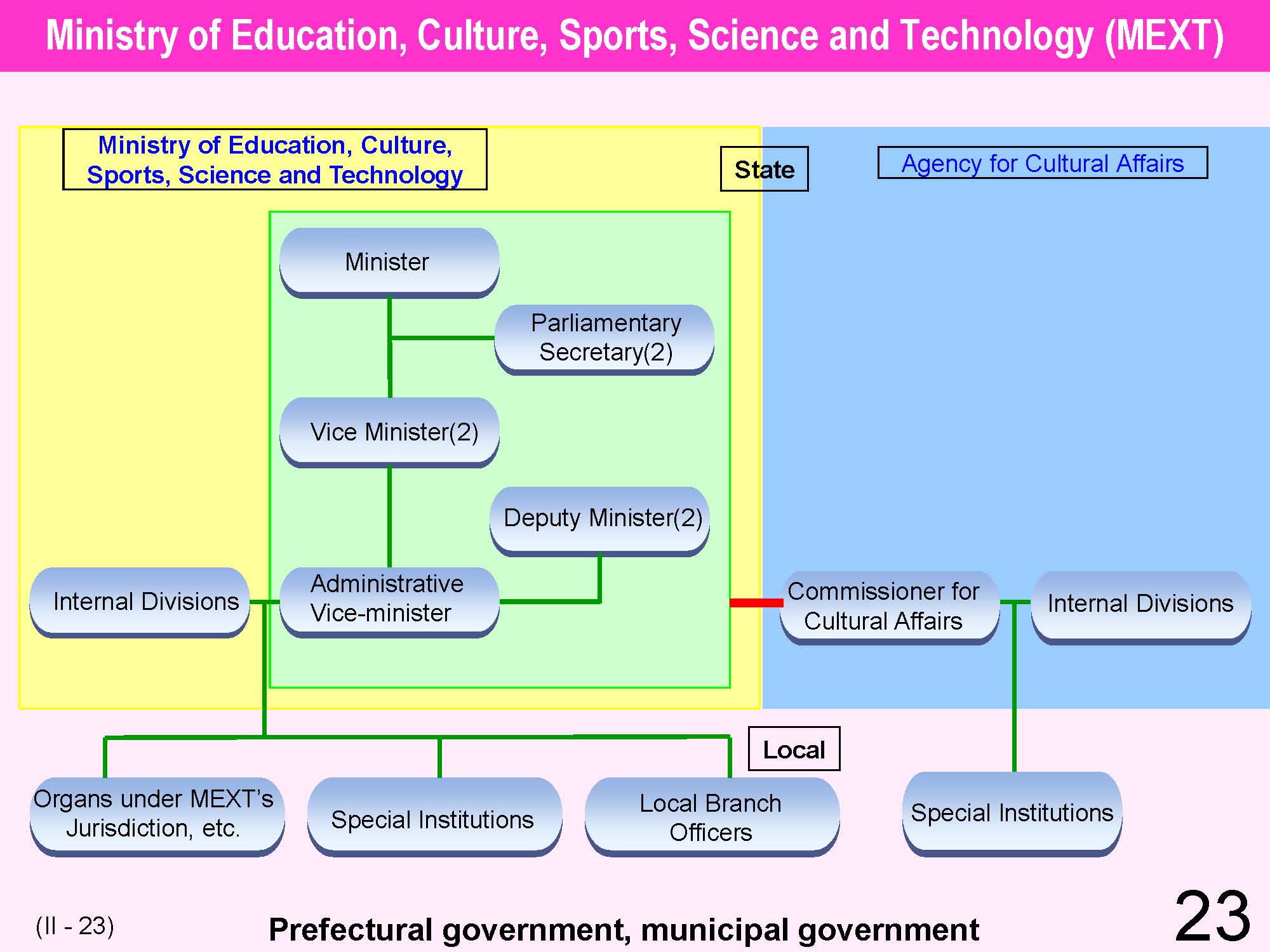 |
The educational administrative organization of Japan consists of the Cabinet and the Ministry of Education, Culture, Sports, Science and Technology. The right of administration of the state belongs to the Cabinet, and the Prime Minister directs and supervises each section of administration. The Ministry of Education, Culture, Sports, Science and Technology (MEXT) mainly takes charge of educational affairs among all the ministries under the control of Cabinet that plan and carry out policies. The Education ministry was formed by integrating the former Ministry of Education, Science, Sports and Culture and the Science and the Technology Agency under ministerial reforms enacted in 2001. It also functions as a government policy-making office was strengthened. In MEXT, councils were set up including the Central Council for Education and the Council of the Textbook Survey for Authorization. The councils discuss and submit reports requested by MEXT. (The diagram http://www.mext.go.jp/b_menu/soshiki2/index.htm) |
| 24 |  |
The educational administrative organization of Japan consists of the Cabinet and the Ministry of Education, Culture, Sports, Science and Technology. The right of administration of the state belongs to the Cabinet, and the Prime Minister directs and supervises each section of administration. The Ministry of Education, Culture, Sports, Science and Technology (MEXT) mainly takes charge of educational affairs among all the ministries under the control of Cabinet that plan and carry out policies. The Education ministry was formed by integrating the former Ministry of Education, Science, Sports and Culture and the Science and the Technology Agency under ministerial reforms enacted in 2001. It also functions as a government policy-making office was strengthened. In MEXT, councils were set up including the Central Council for Education and the Council of the Textbook Survey for Authorization. The councils discuss and submit reports requested by MEXT. . --> http://www.mext.go.jp/b_menu/soshiki2/index.html |
| 25 | 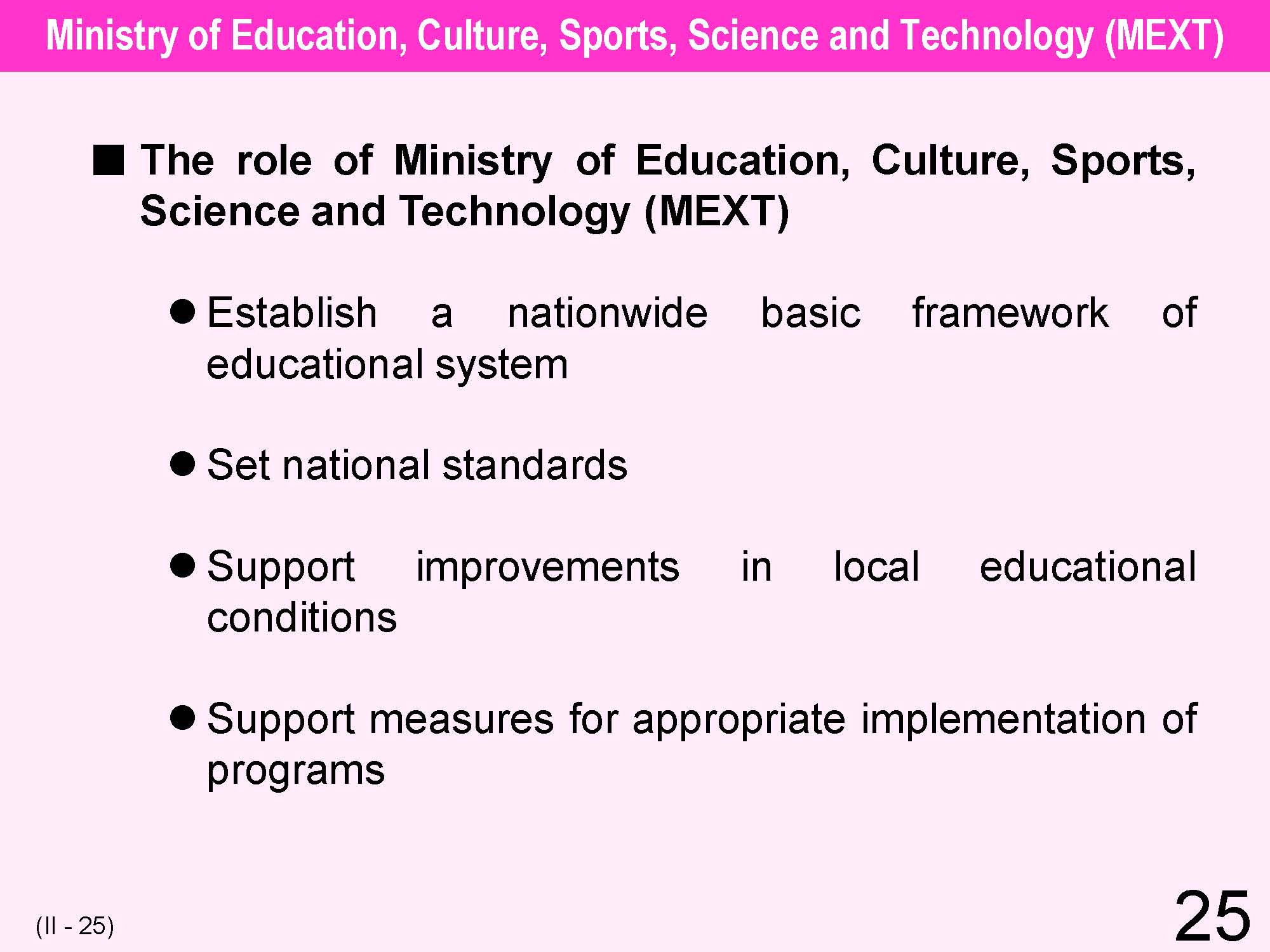 |
The law concerning the Advancement of Regional Devolution basically implemented the content of the Report of Central Council of Education, “Regional Devolution in the Future” in 1998. This law states that the role of the state in educational administration is largely transferred to local governments, and the role of the Ministry of Education, Culture, Sports, Science and Technology (MEXT) is to make a basic policy framework and to set standards of educational contents. |
| 26 | 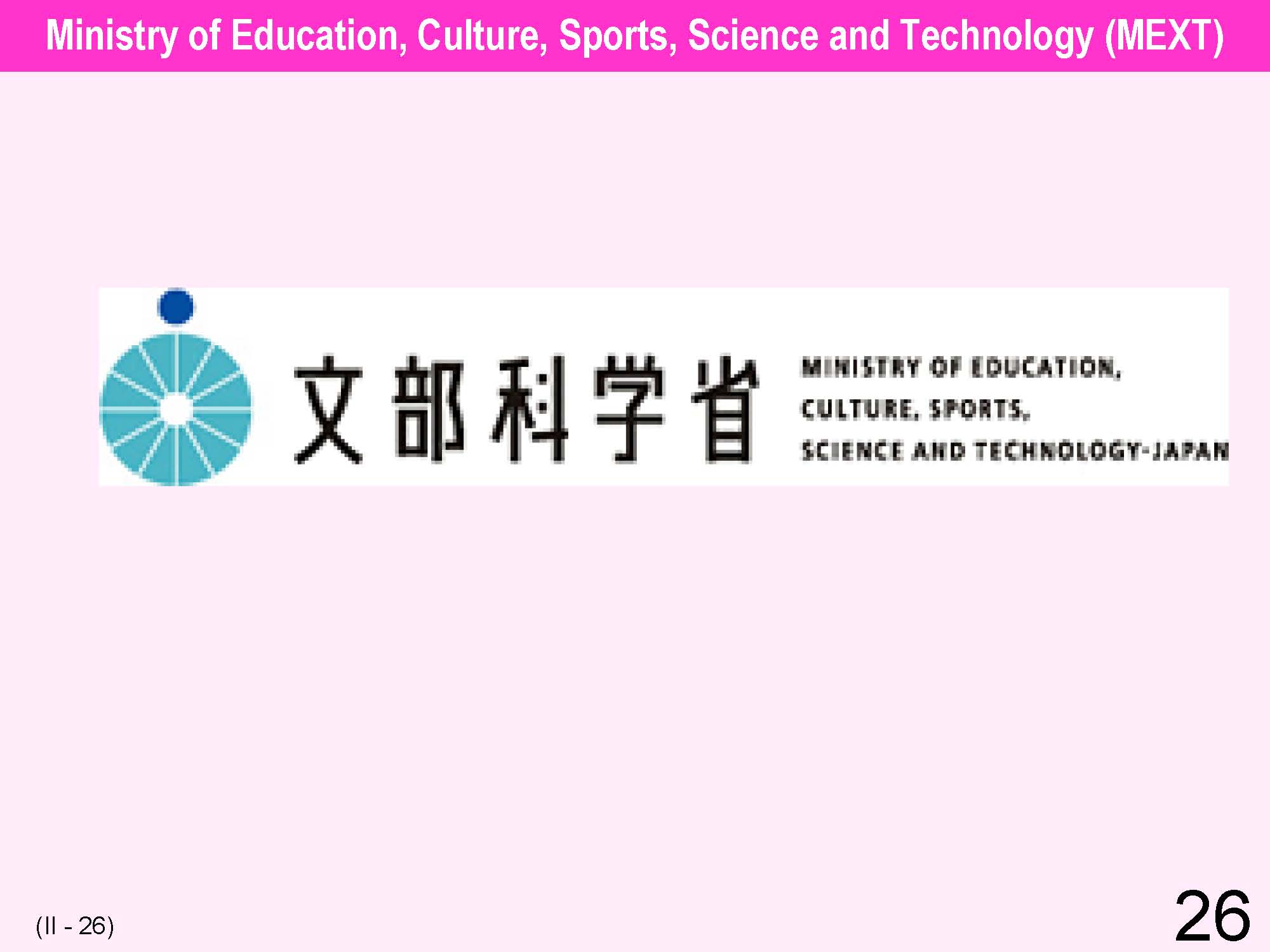 |
Since 2000, the Central Council of Education consists of the following subcommittees: (1) Subcommittee on Education Systems; (2) Subcommittee on Life-Long Learning; (3) Subcommittee on Primary and Secondary Education; and (4) Subcommittee on Sports and Youth. The Council submitted a Report in 2003, which emphasized: (1) revision of standard of university establishment; (2) revision of the Basic Act on Education and the Basic Plan of Educational promotion; (3) improvement in strategies for presenting curriculum and instruction in primary and secondary education; and (4) development of an international student policy. |
| 27 | 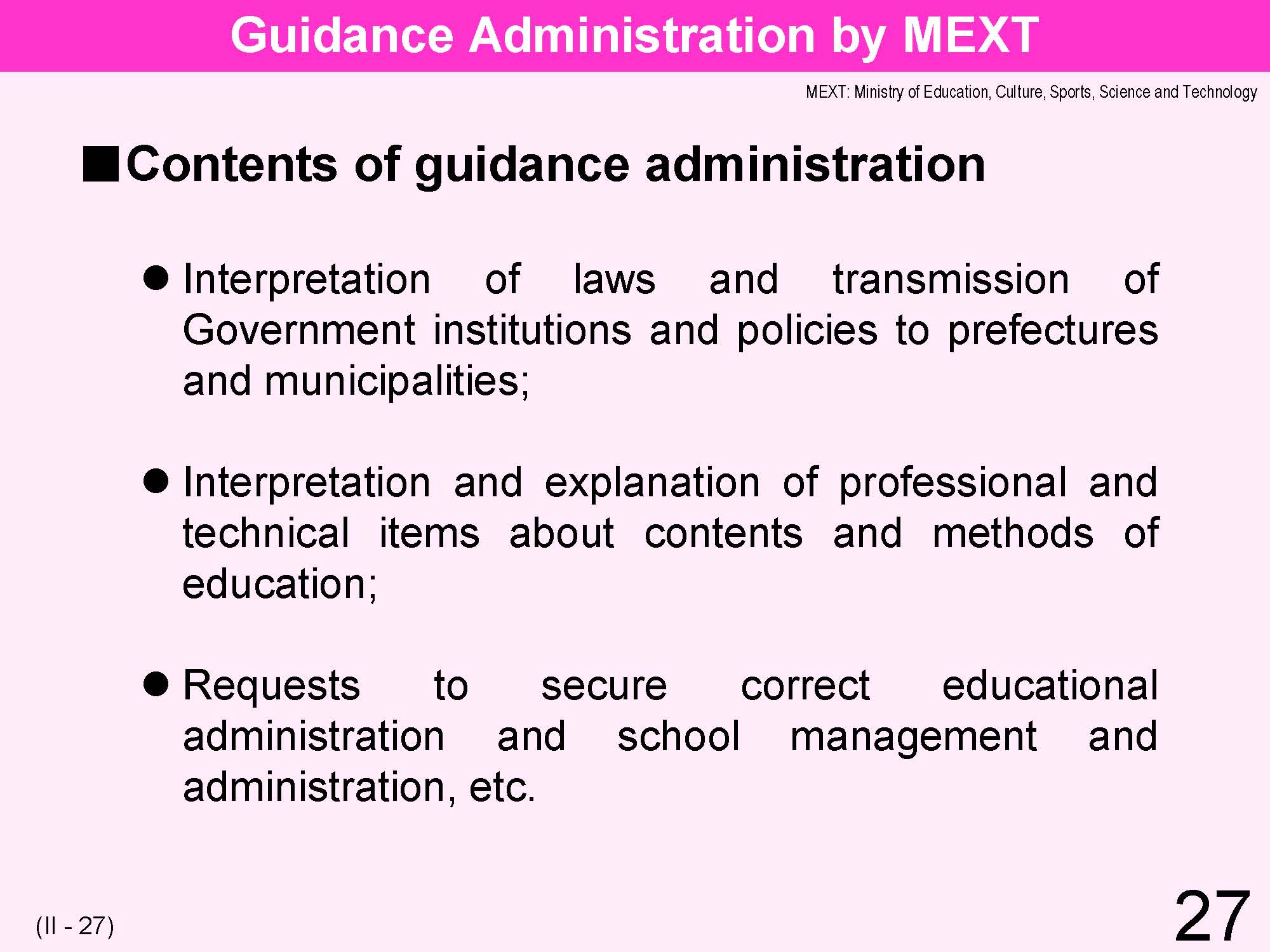 |
Guidance administration covers non-authoritative and non-binding administrational actions such as guidance, advice and assistance. In recent years, educational administrators are also expected to operate in a non-authoritative manner so that educational activities can evolve freely and creatively with respect for the relative independence and autonomy of Board of Education and schools. Key aspects of the task to provide guidance and advice regarding regional ownership of education includes: *Avoid constraining the judgments by prefectures and municipalities; * Emphasize supportive functions, such as collection and provision of information; * Stress correction of educational administration and school management and administrative aspects that violate laws, such as the Basic Act on Education and School Education Act |
| 28 | 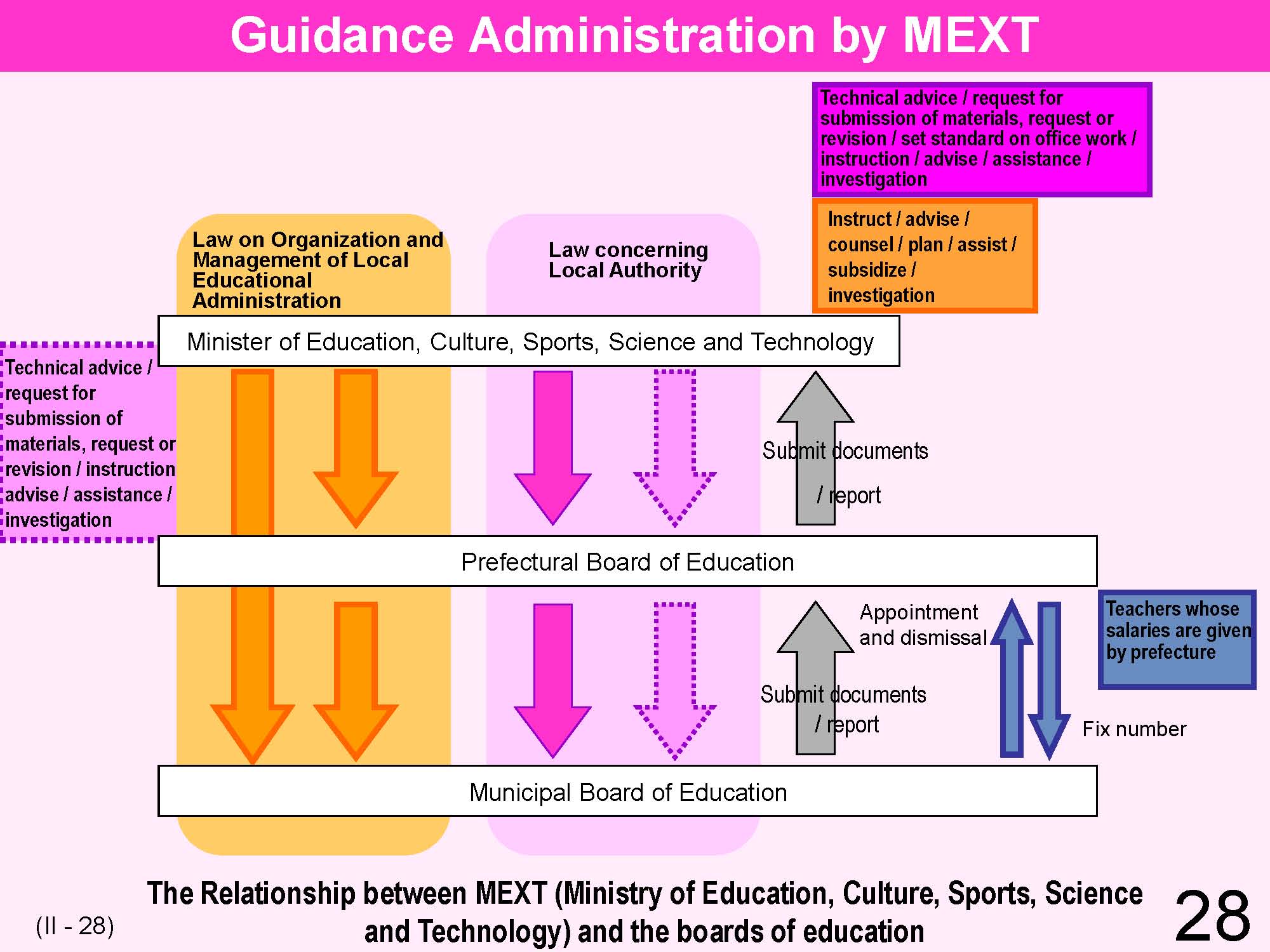 |
The Law concerning Local Authority and the Law on Organization and Management of Local Educational Administration, were revised on the basis of the Law concerning the Advancement of Regional Devolution enacted in 1999. These laws prescribe the relationship between the state Ministry of Education, Culture, Sports, Science and Technology (MEXT) and boards of education. In the regulations of the Law concerning Local Authority, the Minister of MEXT has the authority over technical advice, requests for submission of materials, requests for revisions, instructions, advice, assistance, and coordination of the autonomous administration of boards of education. Regarding administration of the prefectures, whereas previously revisions were issued directly in response to requests, now the situation has changed to a system of instructions re setting criteria for administrative management. Under the Law concerned with the Advancement of Regional Devolution, the Minister of MEXT has authority to instruct, advise, counsel, plan, assist, subsidize, and investigate local boards of education. |
| 29 | 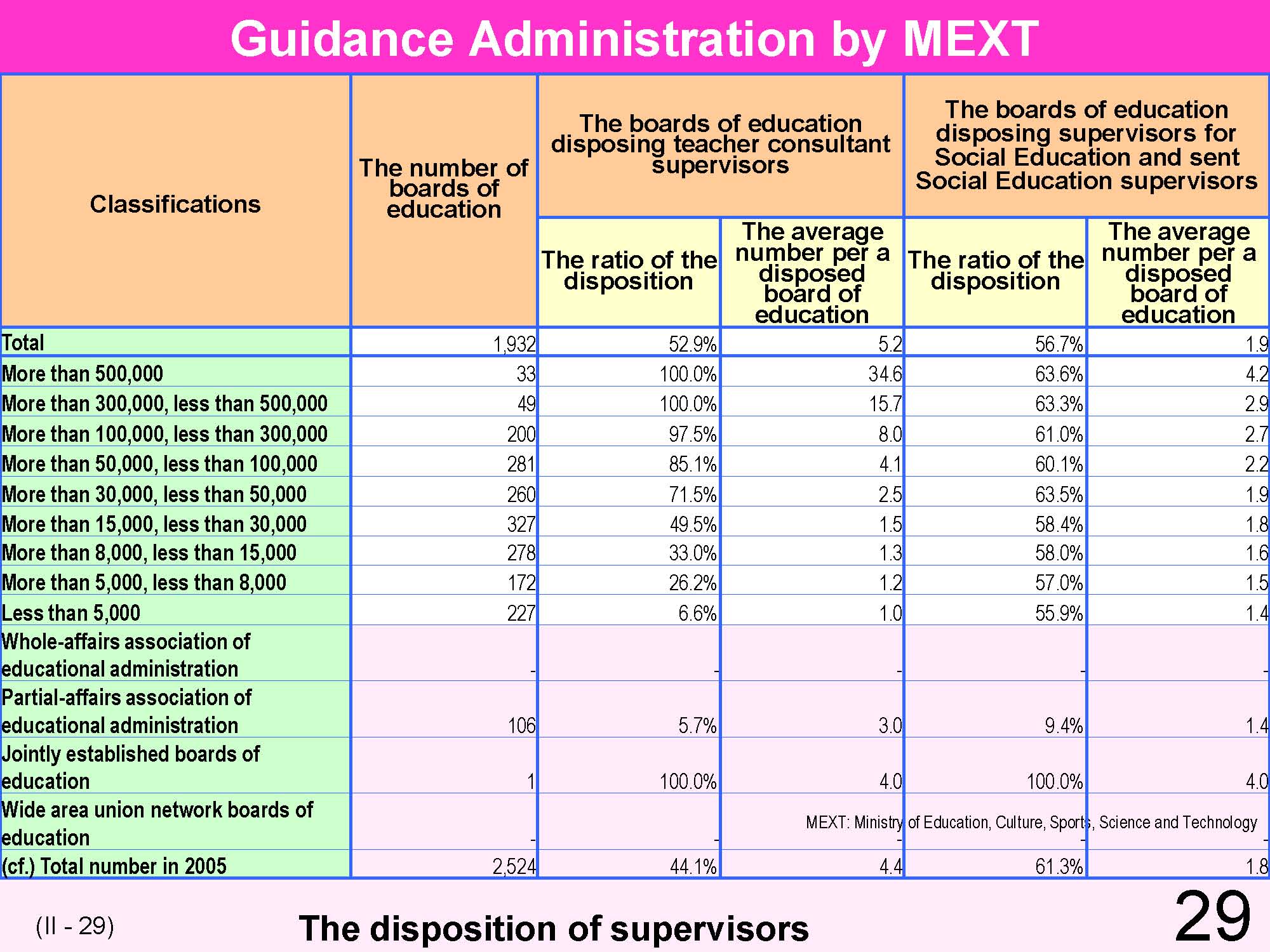 |
“The Japanese supervisory system reflects the conversion of the former system of directive educational administration into a system of advisory educational administration as an outcome of post-war educational administrative reforms. The aim of this system is to support schools through constructive guidance and advice based on expert knowledge and experience. Supervisors who are assigned to boards of education take charge of specialized guidance for principals and teachers regarding curriculums and teaching. During the pre-war period, this task was handled by inspectors. Currently, there are two types of supervisors: one type is appointed by municipalities while the other is delegated from prefectural boards of education. Among approximately 1,900 municipal boards of education in Japan, only half of them have supervisors. --> http://www.mext.go.jp/b_menu/toukei/001/005/gai002.htm |
| 30 | 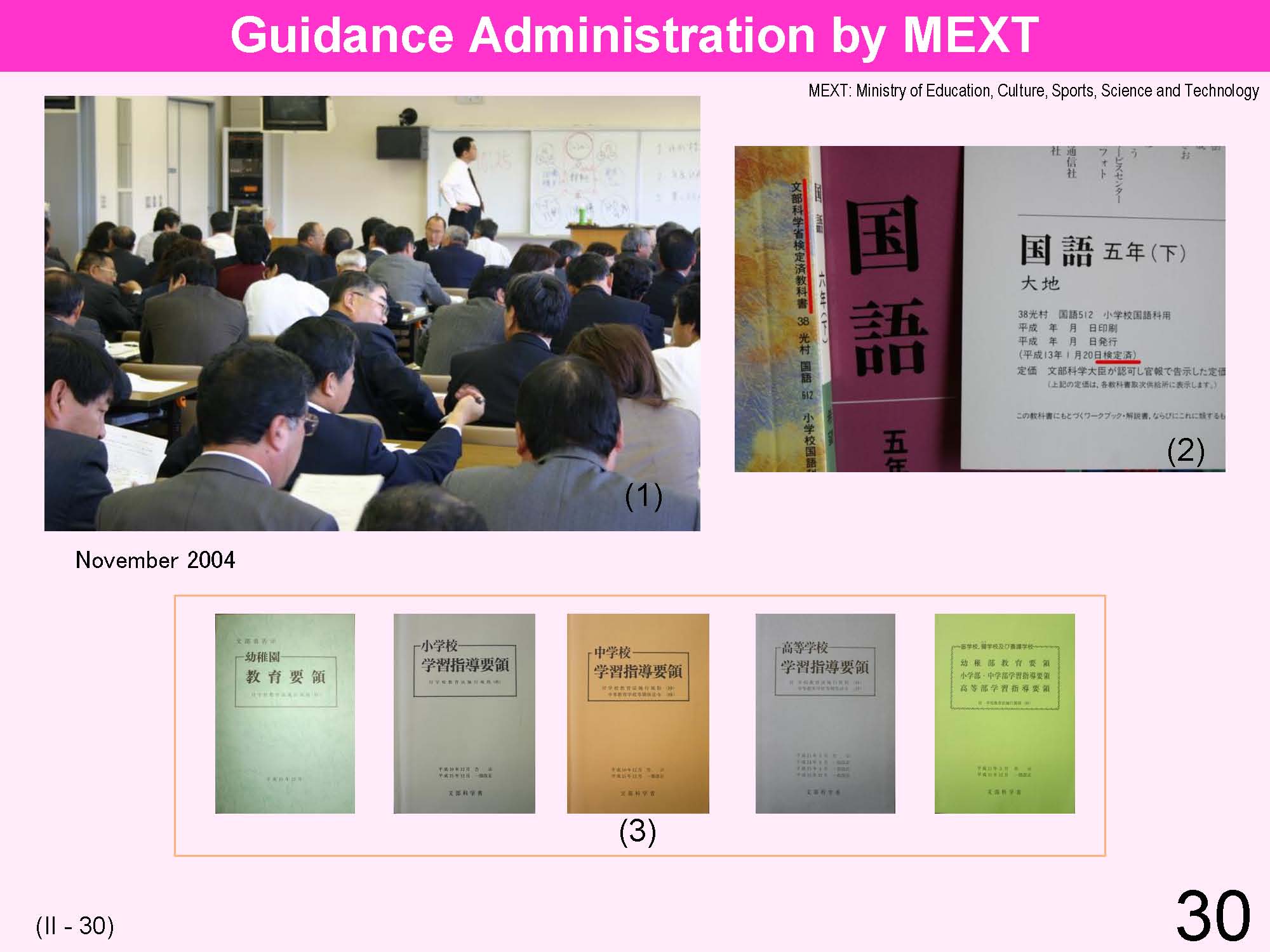 |
The duties of the supervisors, as specified in Article 19 of the Law concerning the Organization and Management of Local Education Administration, are as follows: Supervisors, under the direction of their superiors, engage in office work related to guidance of technical matters involving curriculums at schools, instruction improvement and in guidance of other school educational staff. Supervisors should have broad backgrounds in education and be cultured and experienced regarding technical matters regarding curriculums at schools, instruction improvement and matters pertaining to other school education staff. (1) Initial training for new elementary school principals done by the prefectural education board, November 2004 (In service training -->VIII 15 - 22, VIII 29 - 31) (2) Textbook authorization (-->II 63) (3) Course of study (--> IV 13 - 16) |
| 31 | 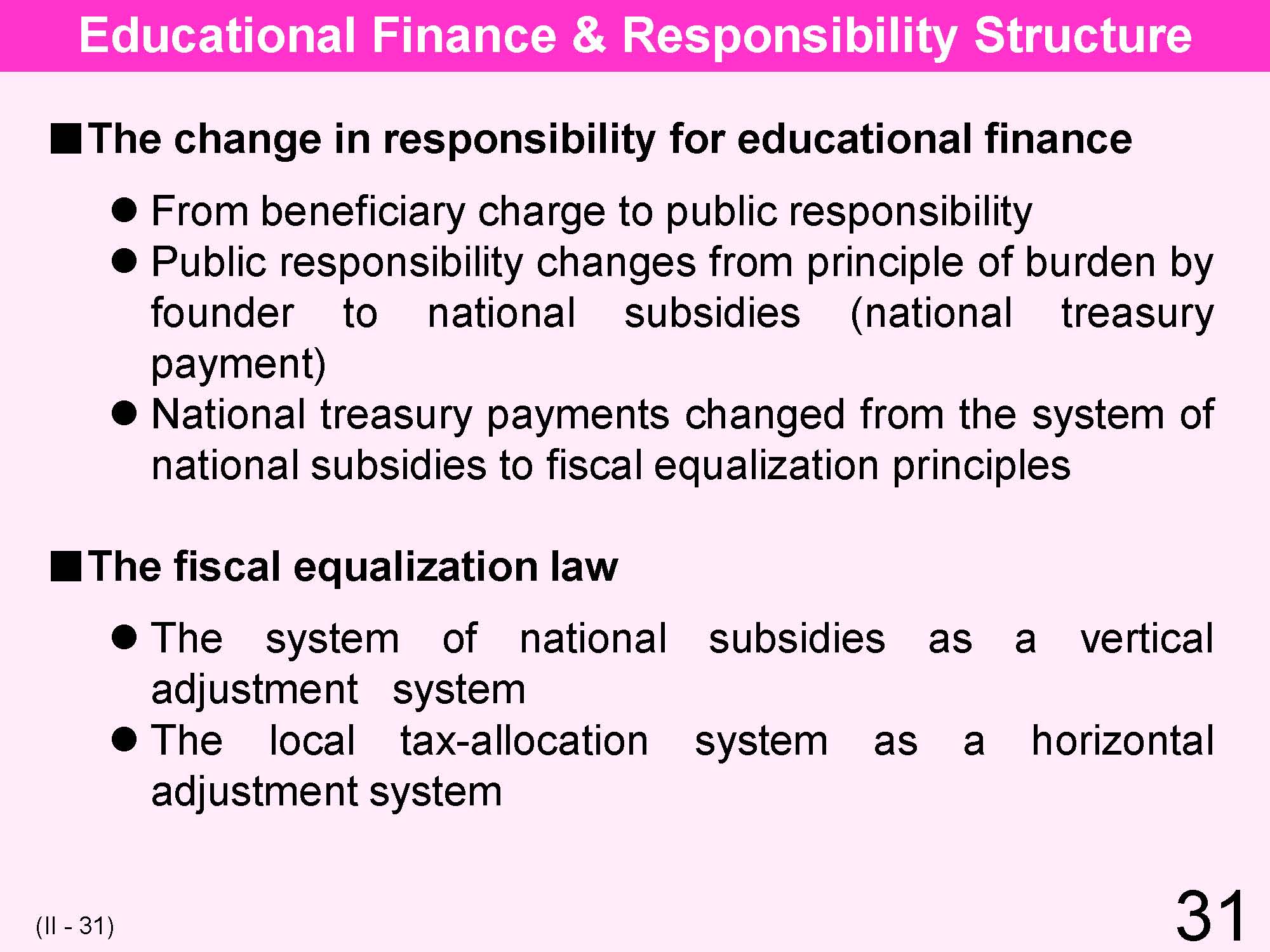 |
The principle of defraying expenses provides that school founding entities comprising the state, prefectures and school juridical persons remain responsible for paying expenses for their schools. In reality, there is a large financial imbalance in financing capacities, there are many special regulations regarding handling of school expenses and responsibilities that are designed to ensure provision of adequate educational financial resources. |
| 32 | 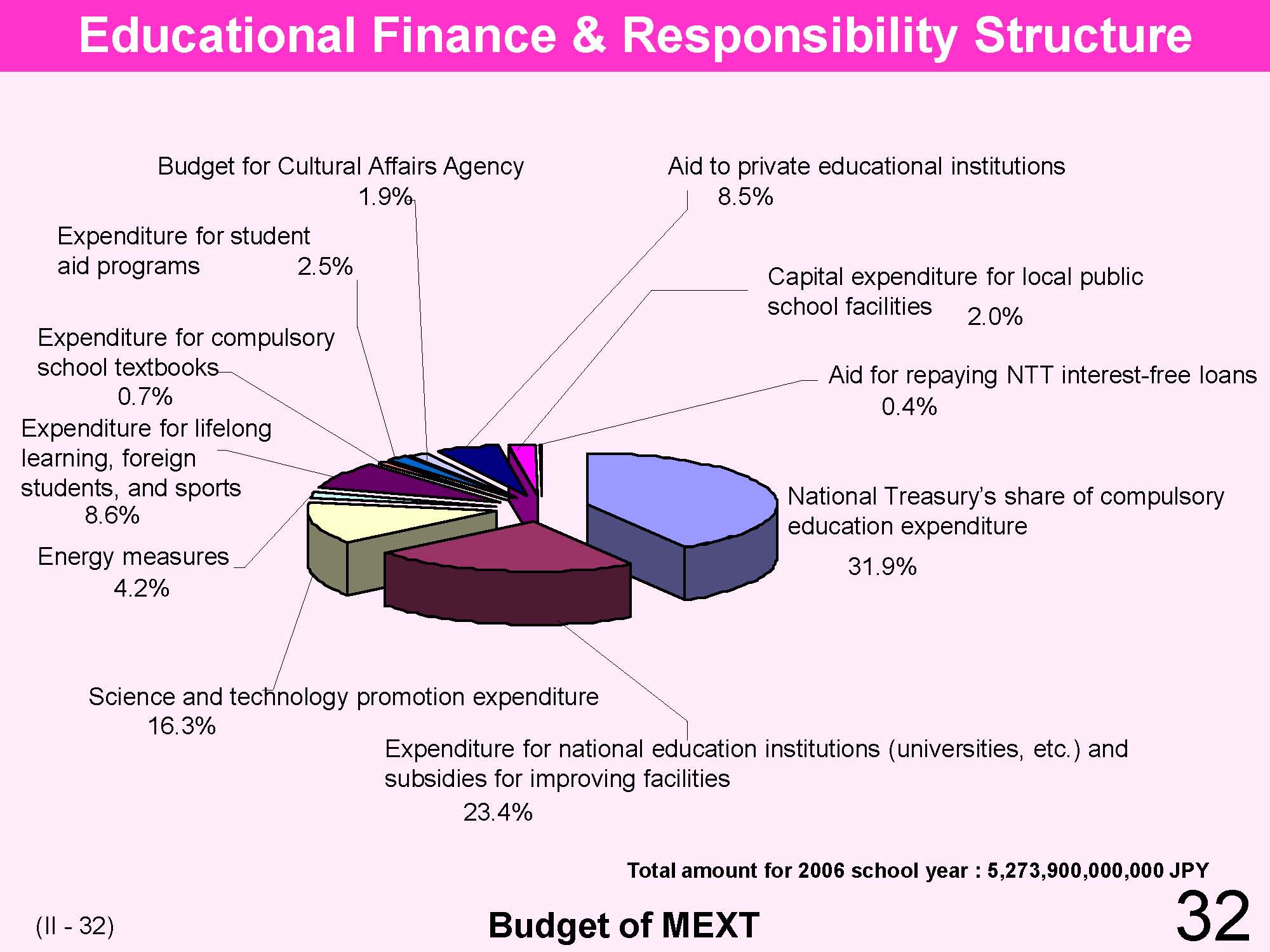 |
In order to reduce financial imbalances and differences, two systems have been introduced to public schools: the system of national subsidies involving vertical adjustments and the subsidy system of local governments involving horizontal adjustments. Subsidy systems for private schools have also expanded in a way that helps to close the financial gap between national/public schools and private schools. |
| 33 | 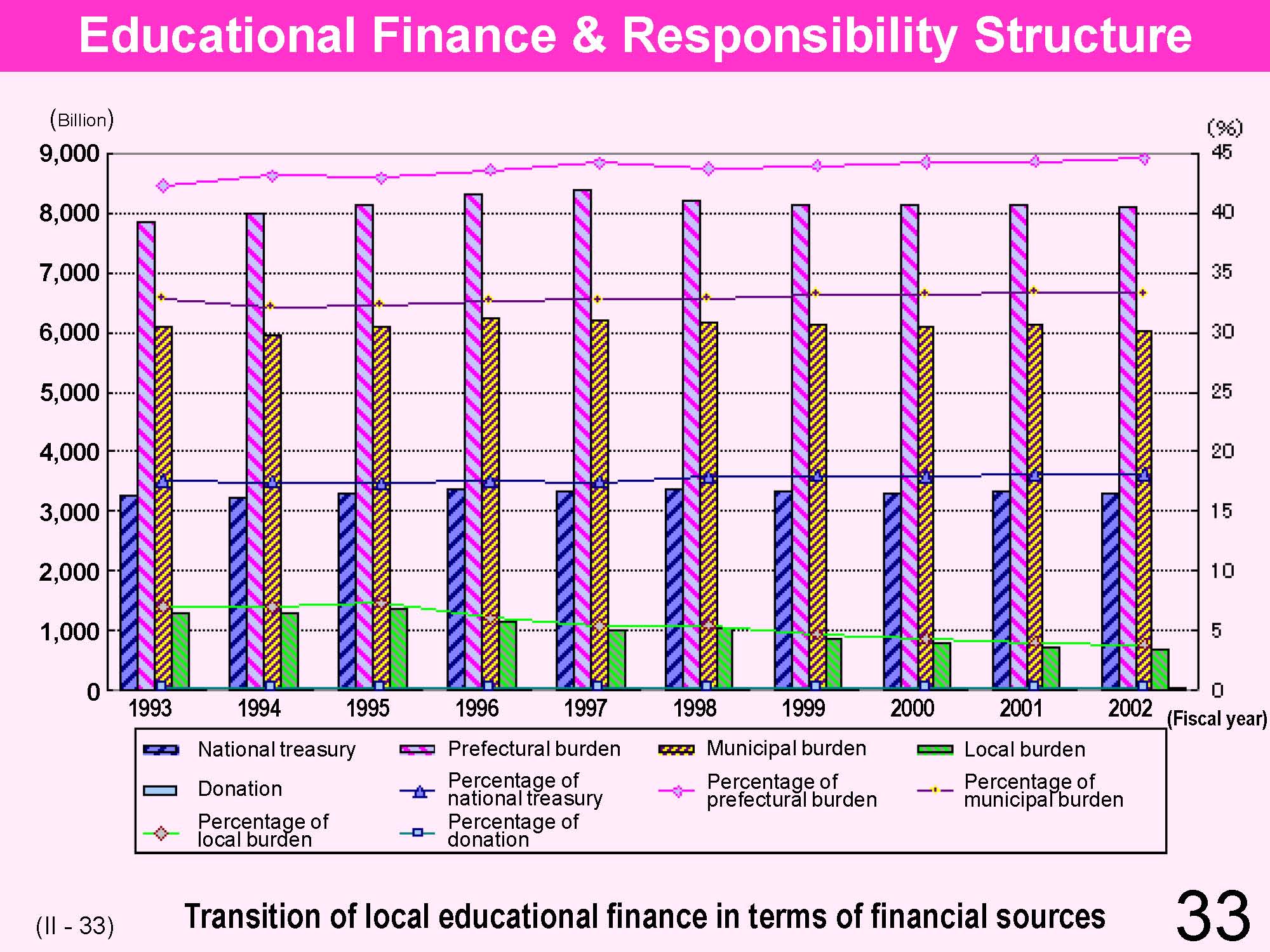 |
The national treasury finances 1/3 to 1/2 of the maintenance expenditure for facilities and equipment in public elementary and lower secondary schools. Also, the salaries for teachers working at national/public schools are financed by prefectures and the 1/3 of the amount is subsidized by the national treasury. |
| 34 | 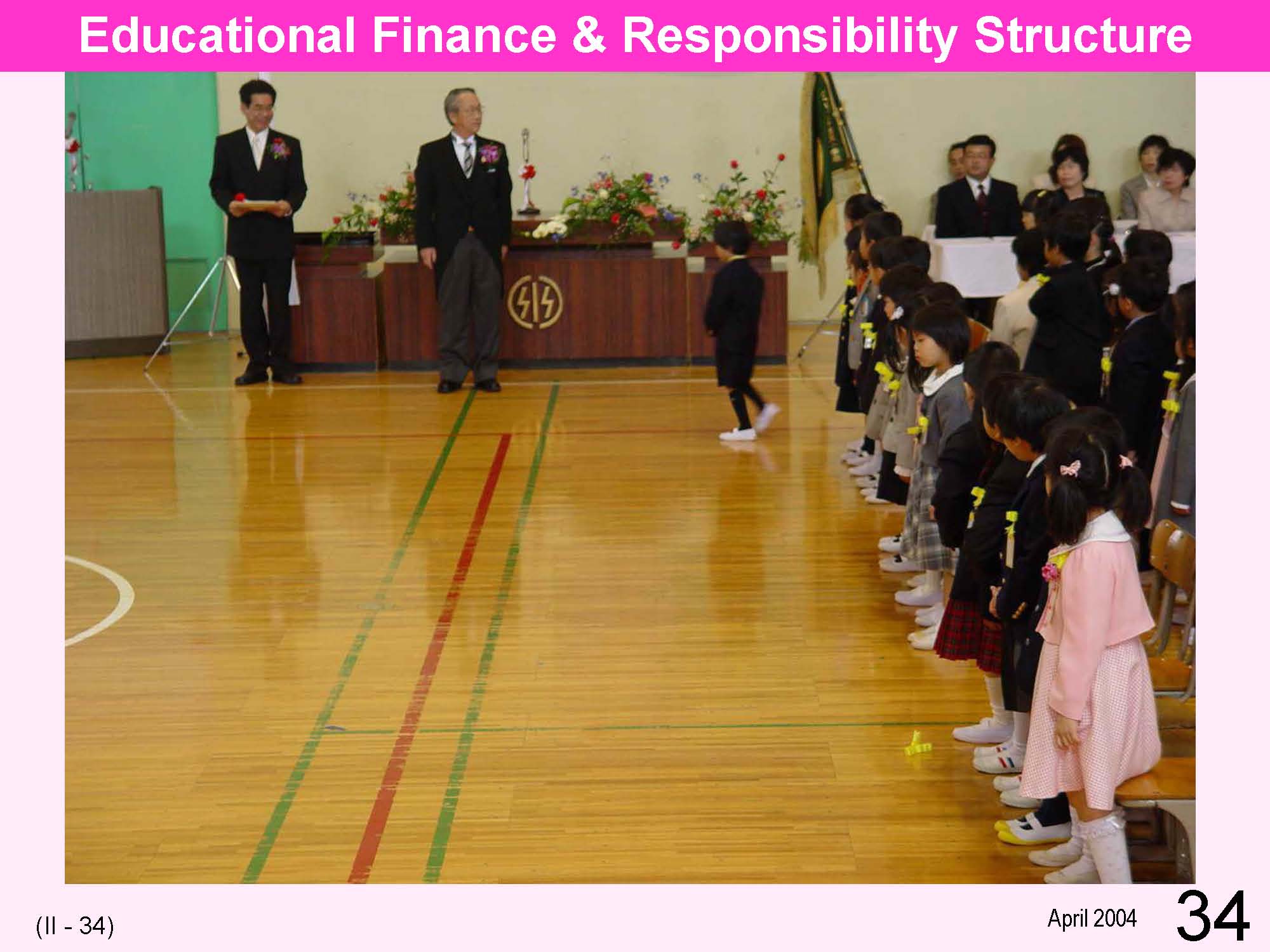 |
New first year students are given textbooks by the principal at an Entrance Ceremony. |
| 35 | 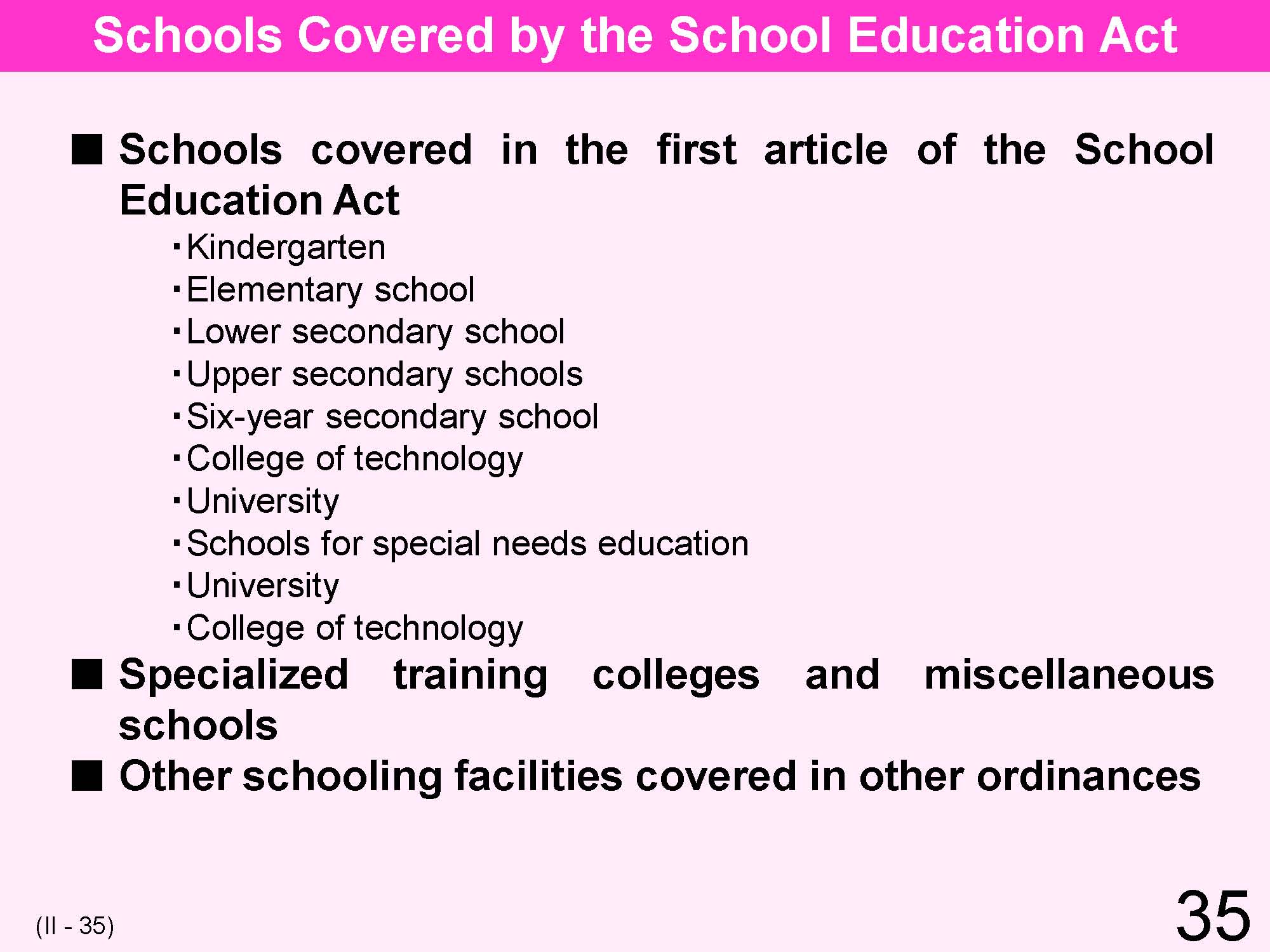 |
National legislation and regulations support the equal opportunities for education as well as the public character, neutrality, and the gratis (free) status of education as a basic feature of Japan’s philosophy of schooling. Public school teachers need to hold a teacher’s certificate in order to teach at schools covered by the national legislation, where the curriculums need to be based on the principles embodied in the Course of Study. The Basic Act on Education provides that private schools must not support a particular political party or conduct political education against a particular political party, and must maintain political neutrality. |
| 36 | 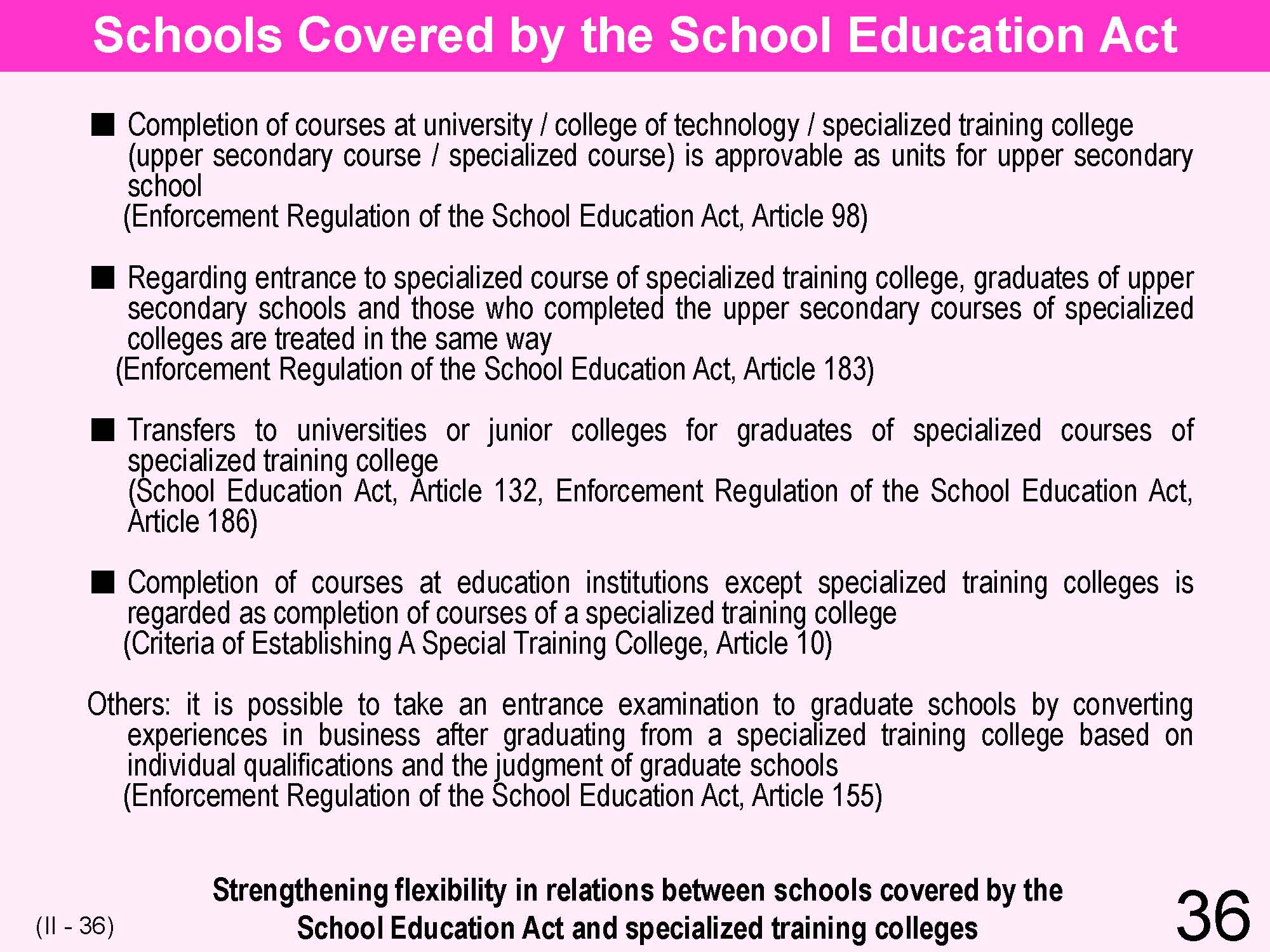 |
Specialized training colleges, which were first established in 1976, are not covered in Article 1 of the School Education Act. However, with recent amendments regarding enforcement regulations and the criteria for school establishment, there is now flexibility to transfer credits between colleges of technology and upper secondary schools, and between colleges of technology, universities and a junior colleges. (Specialized training colleges) -->I 37 - 40) |
| 37 | 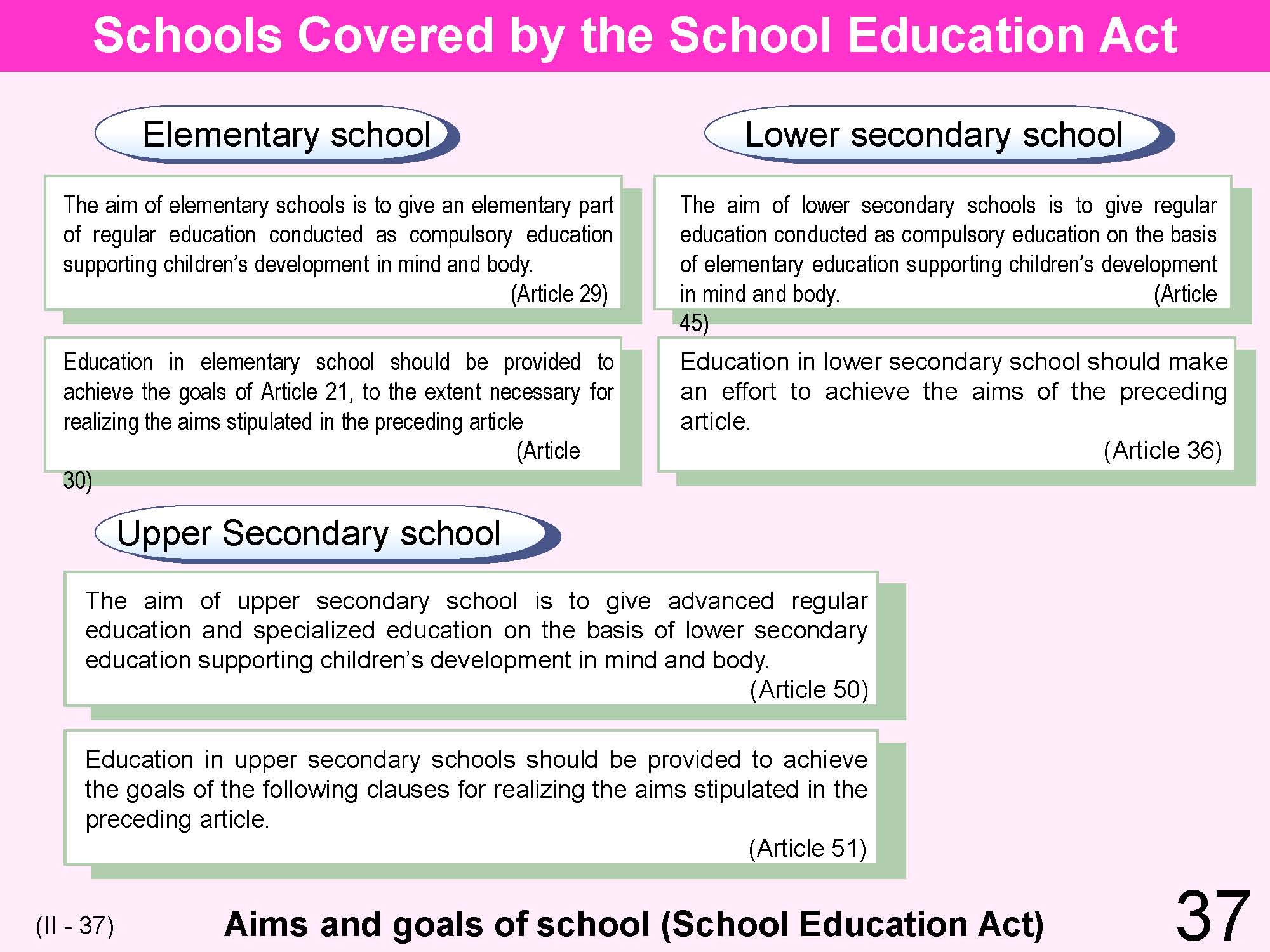 |
Aims and purposes of elementary and secondary schools are defined by School Education Act. Subjects, moral activities and special education are set up as educational categories. |
| 38 | 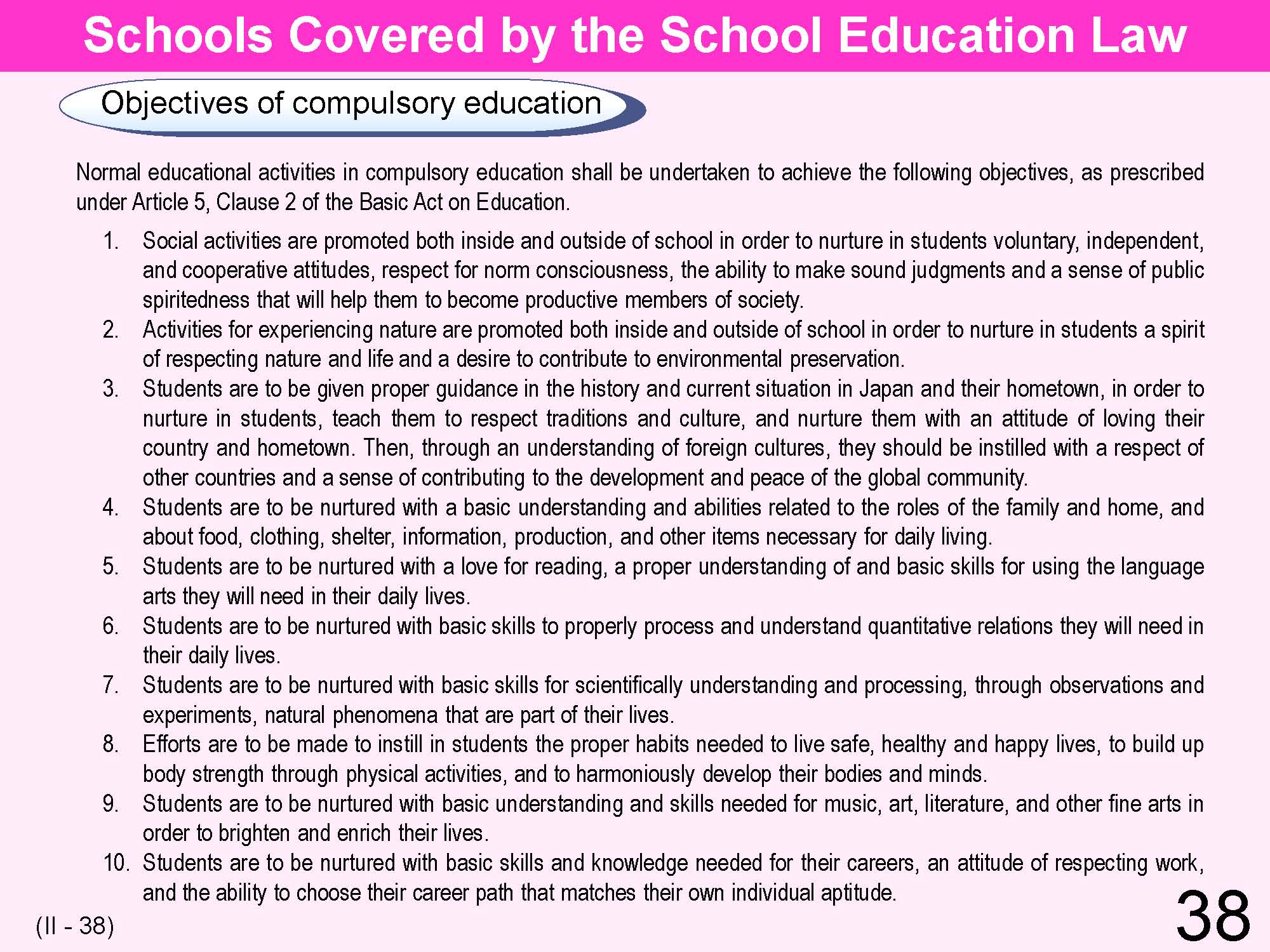 |
|
| 39 | 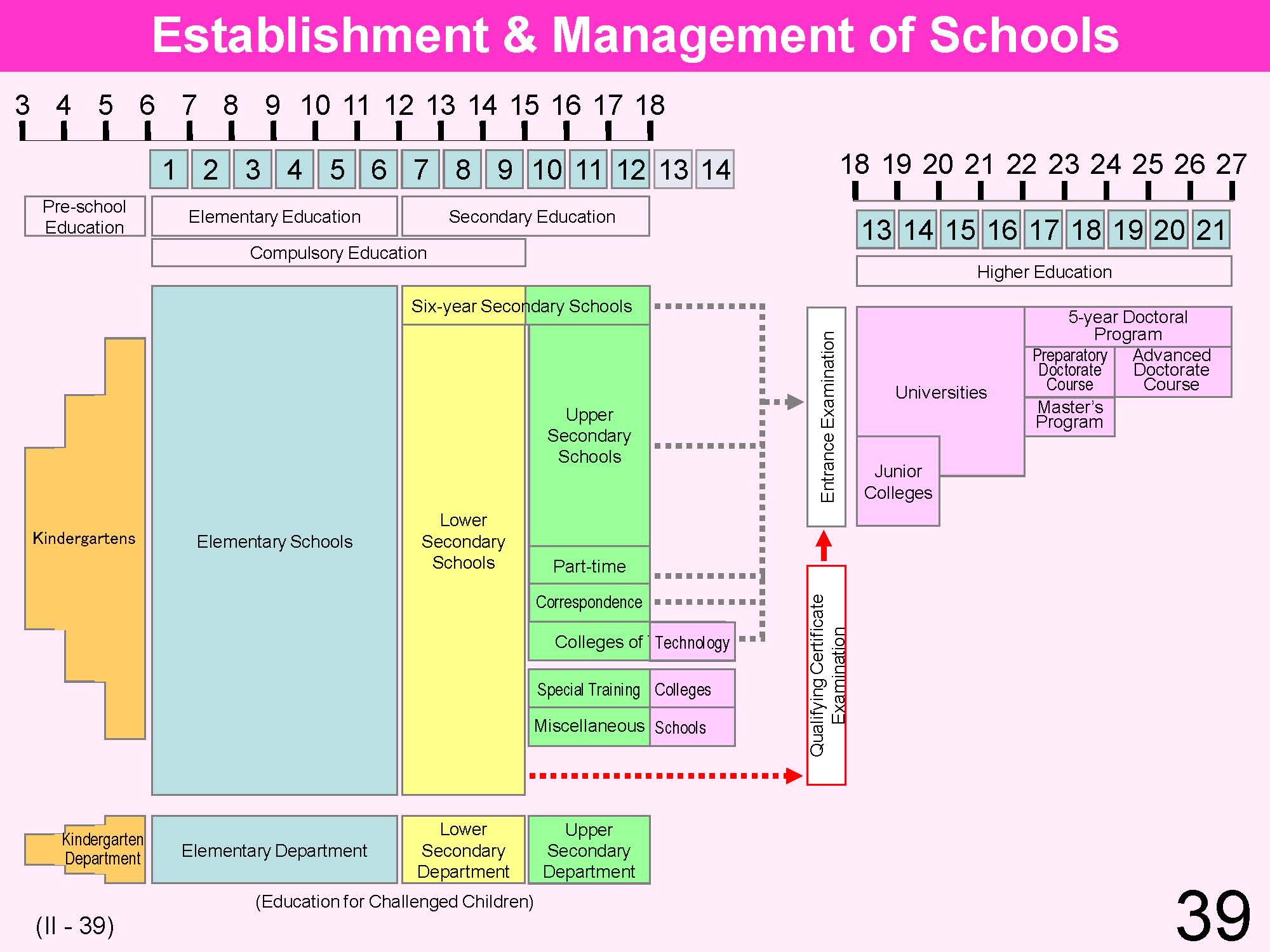 |
The school system of Japan became a single track system through educational reforms after World War II. After the reforms, schools, including technical training schools, specialized training schools, and comprehensive secondary schools were added to the system making it appear to be a dual track system. However, measures have been taken to avoid a dead-end situation under the current educational system. |
| 40 | 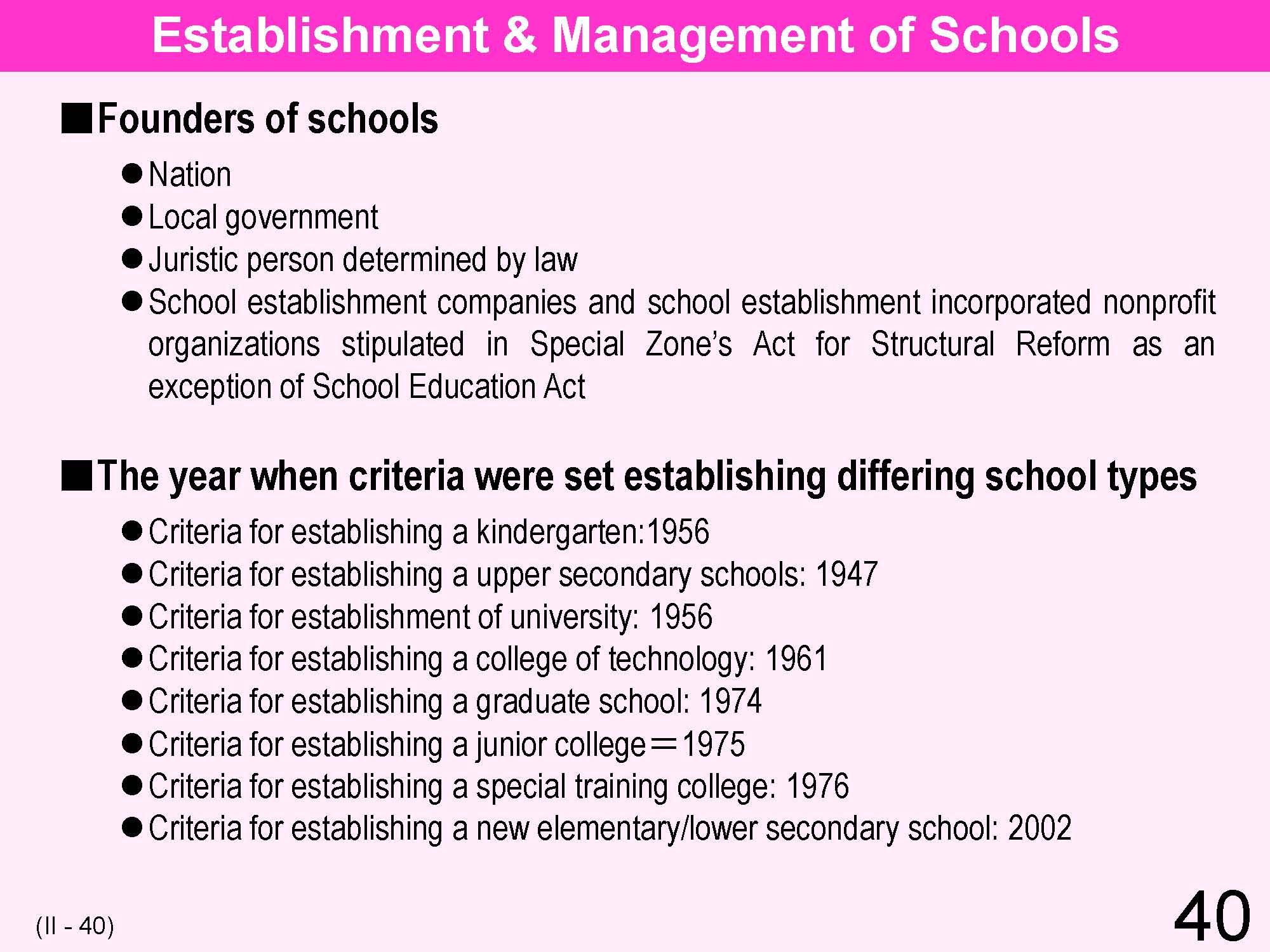 |
According to Article 2 of Japan’s School Education Act, “Schools can be founded only by the state, local government, and juridical persons as defined by Article 3 of the Law on Private Schools.” However, to found kindergartens and schools for handicapped, a founder does not need to be a school juridical person. A person who wants to found a school must follow the criteria for school establishment, such as the type of school, the equipment and the composition which are determined by the Ministry of Education, Culture, Sports, Science and Technology. The criteria for establishing new elementary/lower secondary schools were not set until 2002. This is because 99% of the elementary schools and 94% of the lower secondary schools were public schools due to regulations of the School Education Act and other laws defining criteria for establishment. However, in order to encourage and to promote the establishment of private schools, new criteria for school establishment were formulated in 2002. As an exceptional measure, school founders, school establishment companies and school establishment incorporated nonprofit organizations can establish schools under Special Zone’s Act for Structural Reform. |
| 41 | 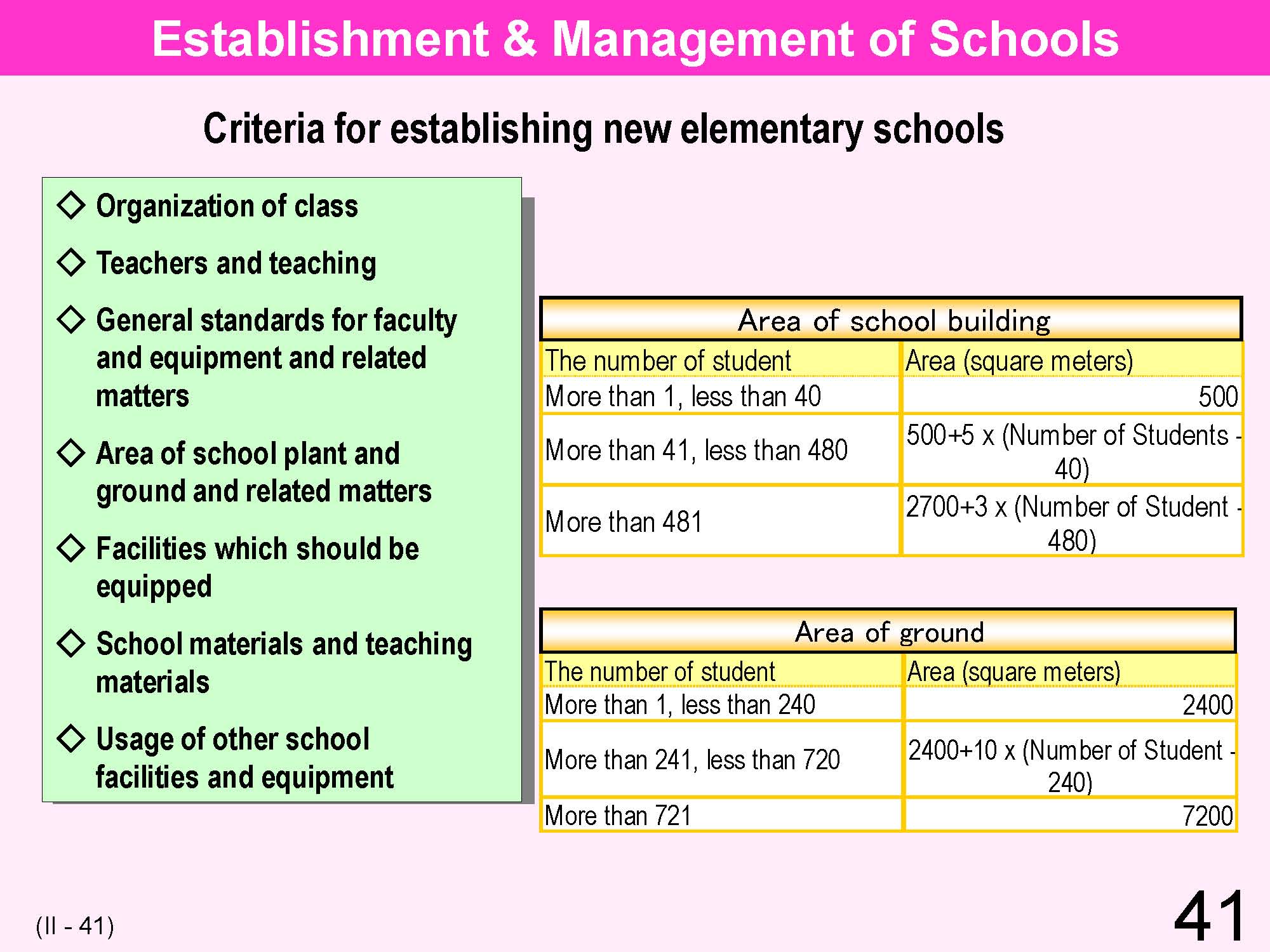 |
|
| 42 | 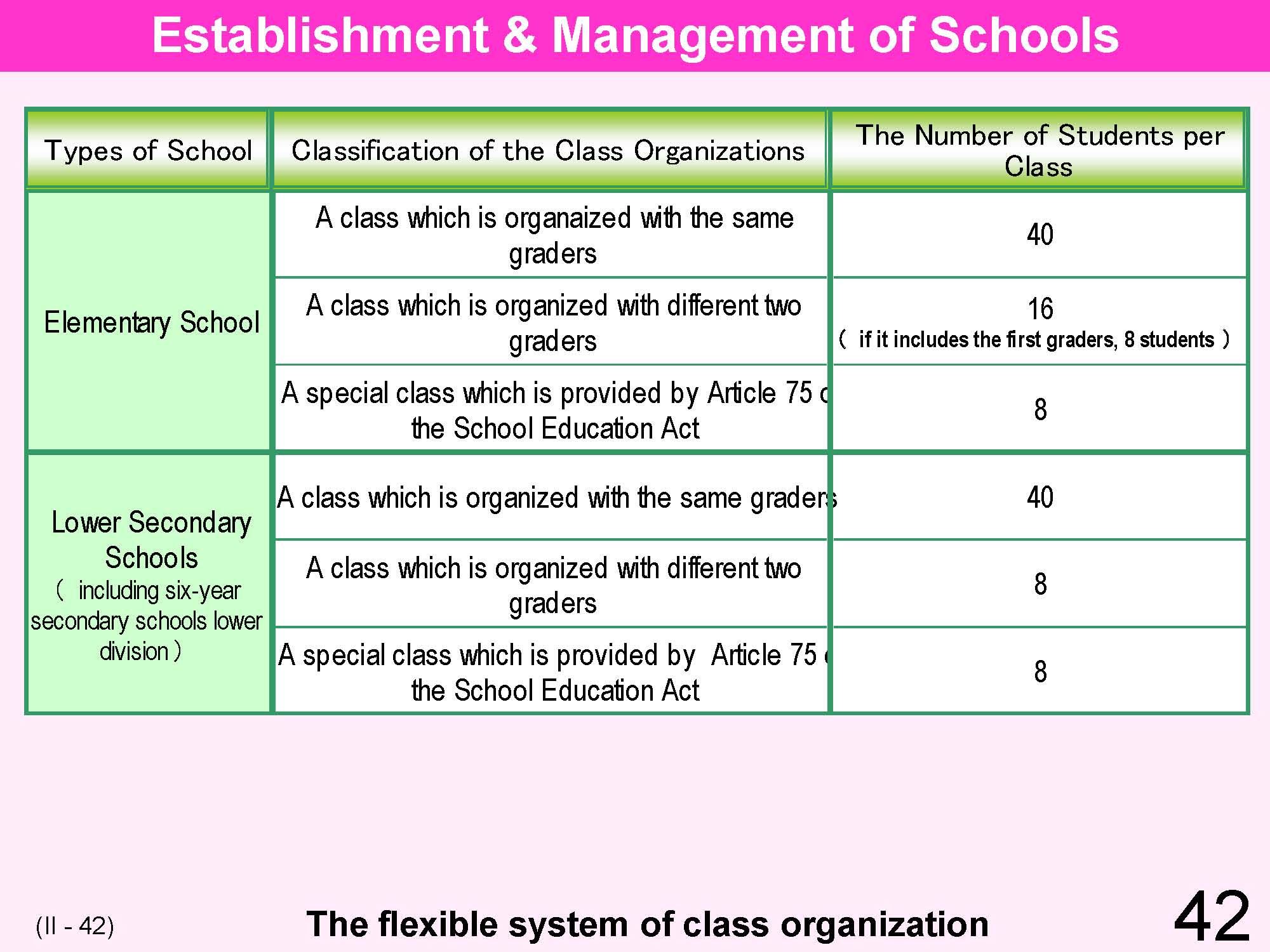 |
As an example of the flexible system of class organization, each class may be made up of fewer than 35 students if there are more than 3 classes in one grade and the average number of students in one class is more than 35 in the 1st grade. Careful instructions are necessary in school with approximately 100 students. |
| 43 | 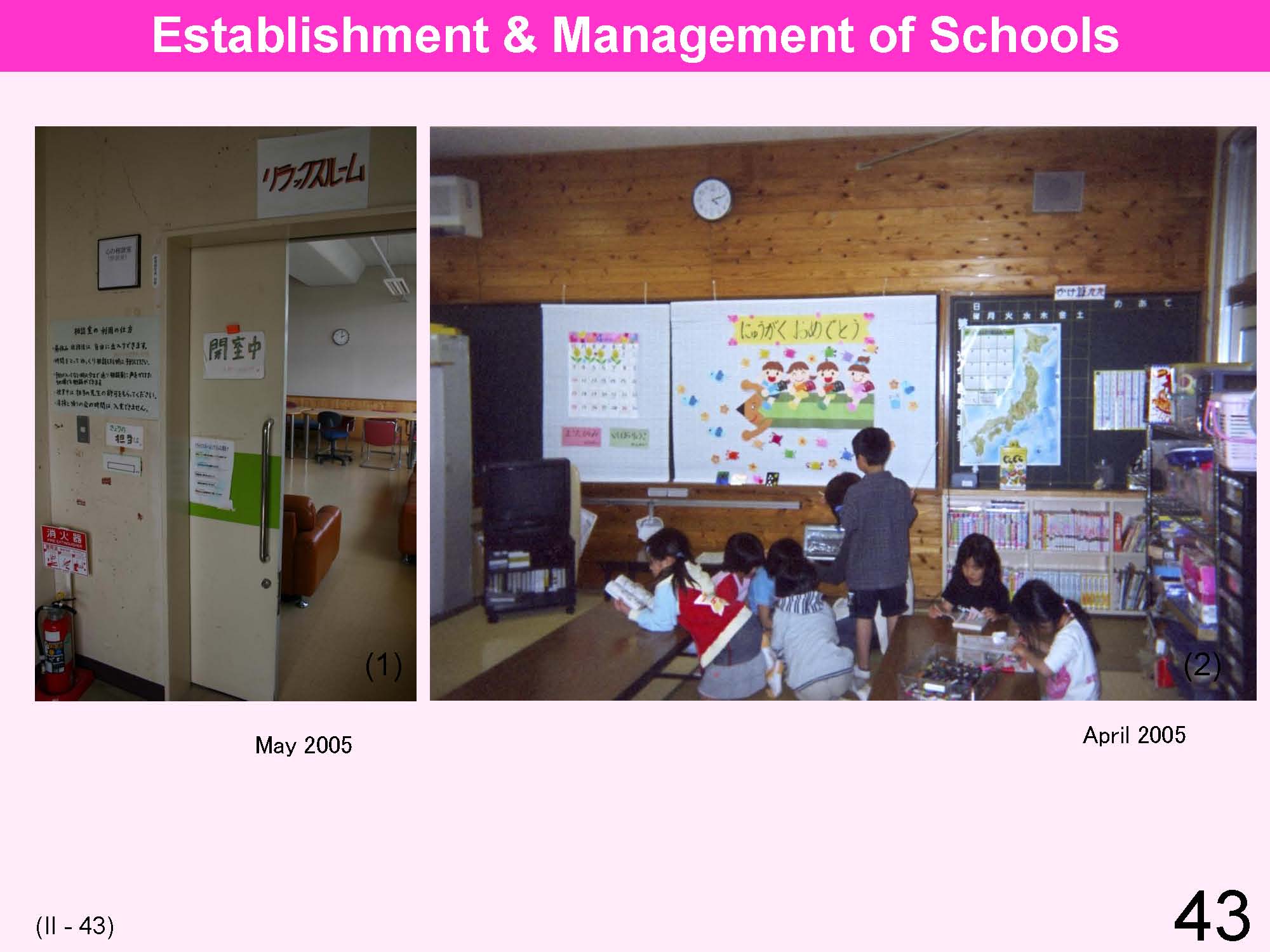 |
Many schools have vacant class-rooms because of the decrease in recent birth rates. These vacant class-rooms may be utilized as dining rooms for students; or for facilitating activities for local people in the community, including guardians. (1) Relaxation room (counseling room) (2) Utilization of vacant rooms (children club) In considering the need to conserve local environments at schools and from the viewpoint of environmental education, MEXT is promoting the establishment of environmentally-friendly school facilities, or eco-schools. Source: http://www.mext.go.jp/english/org/f_formal_16.htm |
| 44 | 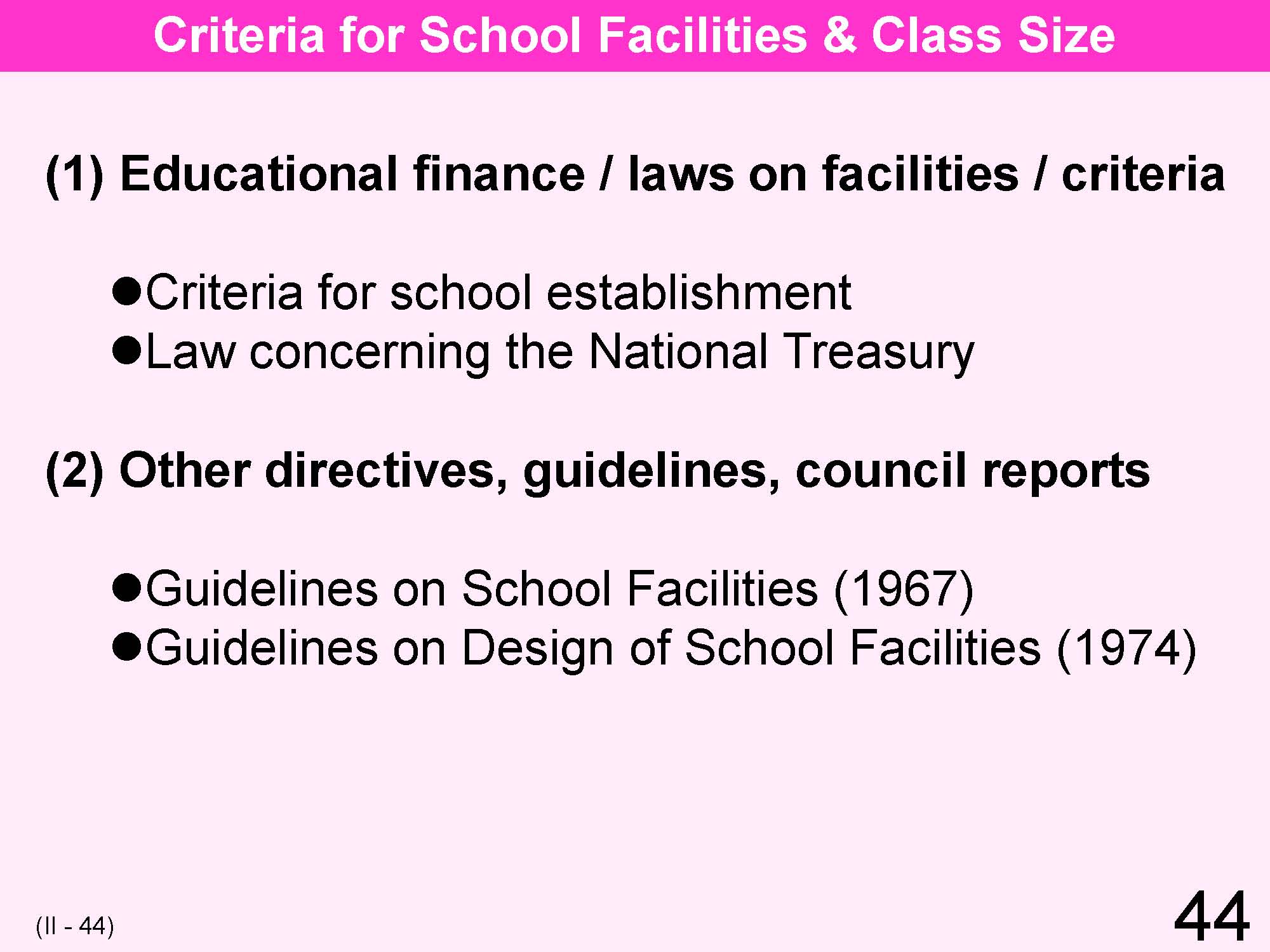 |
Until new criteria for establishing new elementary/secondary school were issued in 2002, laws and criteria described here were the main criteria for determining facilities in elementary schools and lower secondary schools. Even after enactment of the 2002 law, these earlier criteria still in function. These days, the focus has shifted from the provision of facilities to cope with increases in the number of students to the provision of facilities to provide an enabling cultural environment, and to cope with individuality of students and their needs, including diversification of teaching methods. Also, reuse of facilities in response to the decrease in the number of students have eventuated in policies to open school facilities to the public. (1) Educational finance / laws on facilities / criteria *Sharing of Expenses for Various Compulsory Education School Facilities (types of classrooms, appropriate school size and conditions) * the Law for the Promotion of Science Education (criteria of science education facilities) *the Law for the Promotion of Education in Isolated Areas (Necessity for providing schools in isolated areas) * Law Governing Special Measures for the Establishment of Special Schools for the Challenged (criteria re facilities of special public schools for the challenged) * the School Lunch law, Standards for the Provision of School Lunches (criteria of facilities for school lunch in compulsory education schools) (2) Other directives, guidelines, council reports * Concerning Creation of Cultural Environment for School Facilities (1982) * Concerning School Facilities which Meet the Needs of Diversification of Educational Methods (1988) * Concerning computer-intelligent educational facilities (1990) * Concerning Compounding of School Facilities (1991) * Guidelines on Management of School Facilities (1992) |
| 45 |  |
The school environment refers to the natural, physical, and artificial environment surrounding schools. School environments also include problems related to school facilities, size of the classes/schools, school architecture, natural and social environments in local communities, school districts and along school routes. ●Social Conditions ・Avoid industrial areas, love motel areas (Building Standards Law 48, etc) ・No environmental pollution such as air pollution, noise, or damage from vibration (Law concerning Enterprisers' Burden of Cost for Environmental Prevention, Law concerning Special National Financial Expenditure for Initiatives for Environmental Prevention, Law concerning Prevention of Noise Pollution of Airplanes around Public Airports, etc.) ●Natural Condition ・Height of the school location (Building Standards Law19) ・Commuting distance to school (Enforcement of National Treasury's Share of Expenses for Compulsory Education Schools 3, less than 4 kilometers are appropriate for elementary school students to commute to school) |
| 46 | 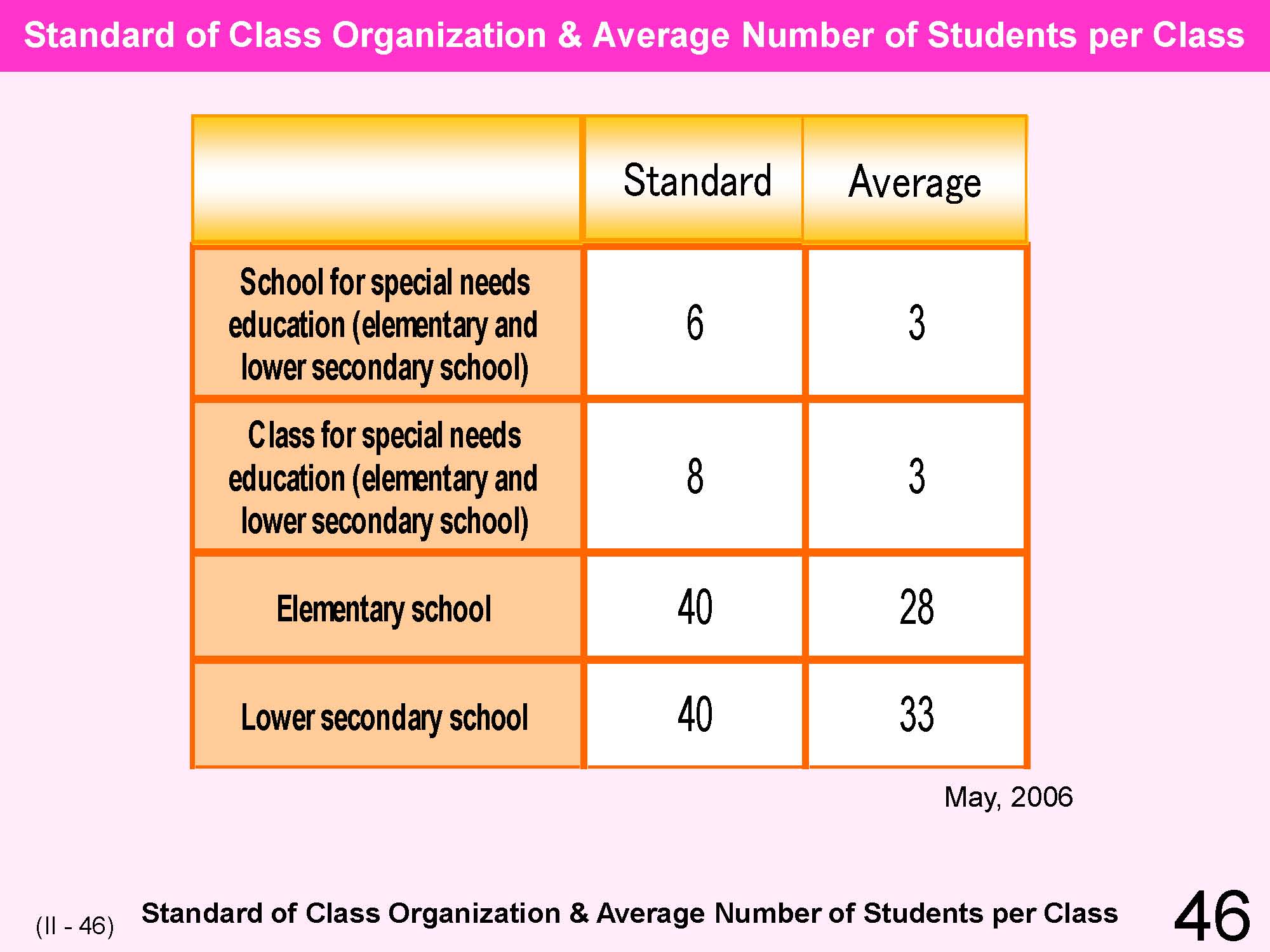 |
A standard school size is 12 to 18 classes in elementary schools and lower secondary schools. Still, there are many small sized schools nation-wide with only one class in each grade. Schools in large cities have been unified or closed due to the urban sprawl phenomenon which has grown over the last 20 years. In recent years, some problems about school and class sizes have arisen, such as the issue of continuance of small schools linked to the abolition of school district s. -->http://www.pref.shimane.jp/section/kyousou/kekkagaiyou/gaiyou02.html |
| 47 | 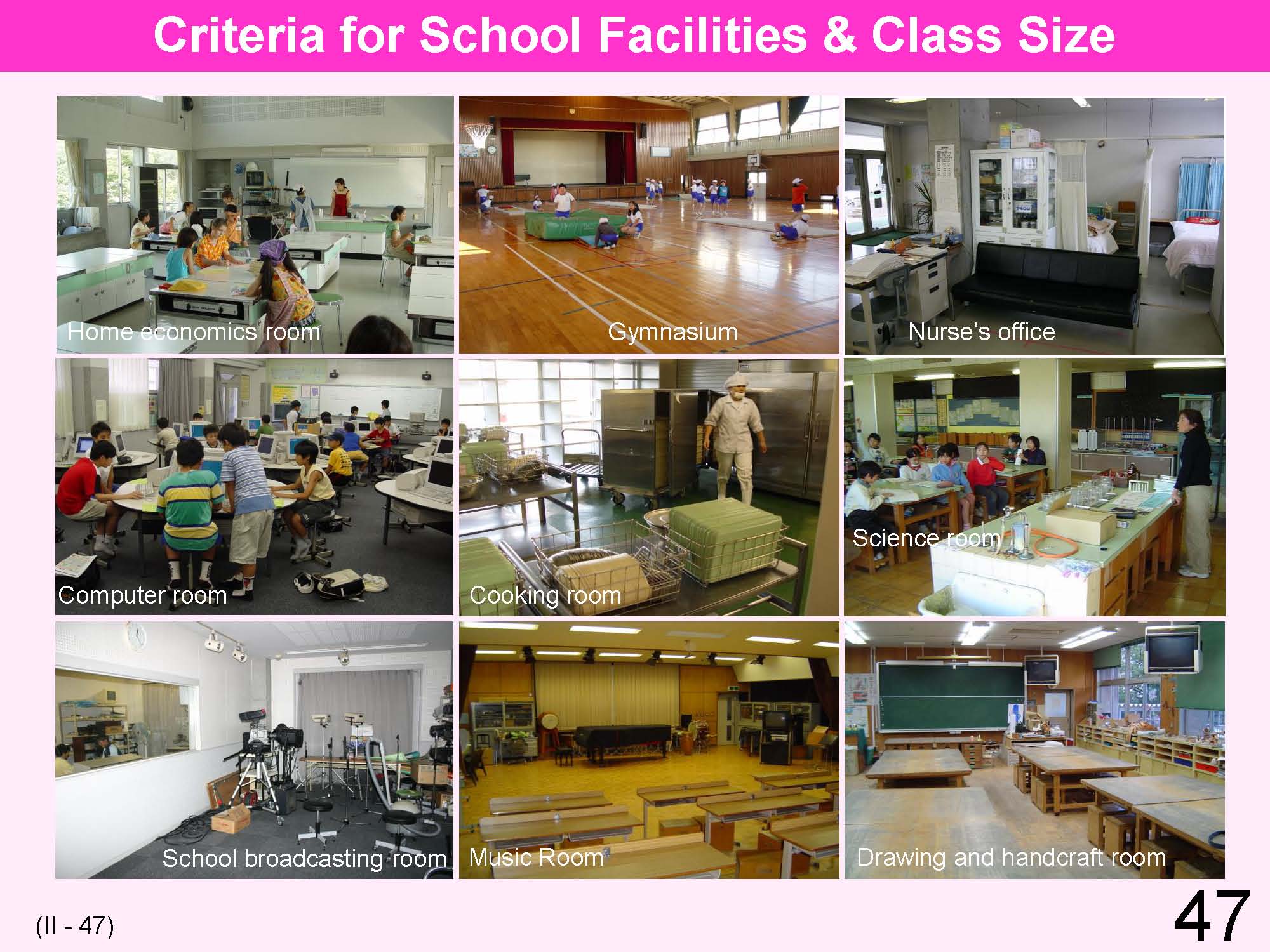 |
Reforms of school facilities are proceeding at established schools in response to the information-oriented society and to new efforts that school facilities be opened to the local community. In the latter case, establishing safety measures against external intruders who enter school premises is one of the issues. |
| 48 | 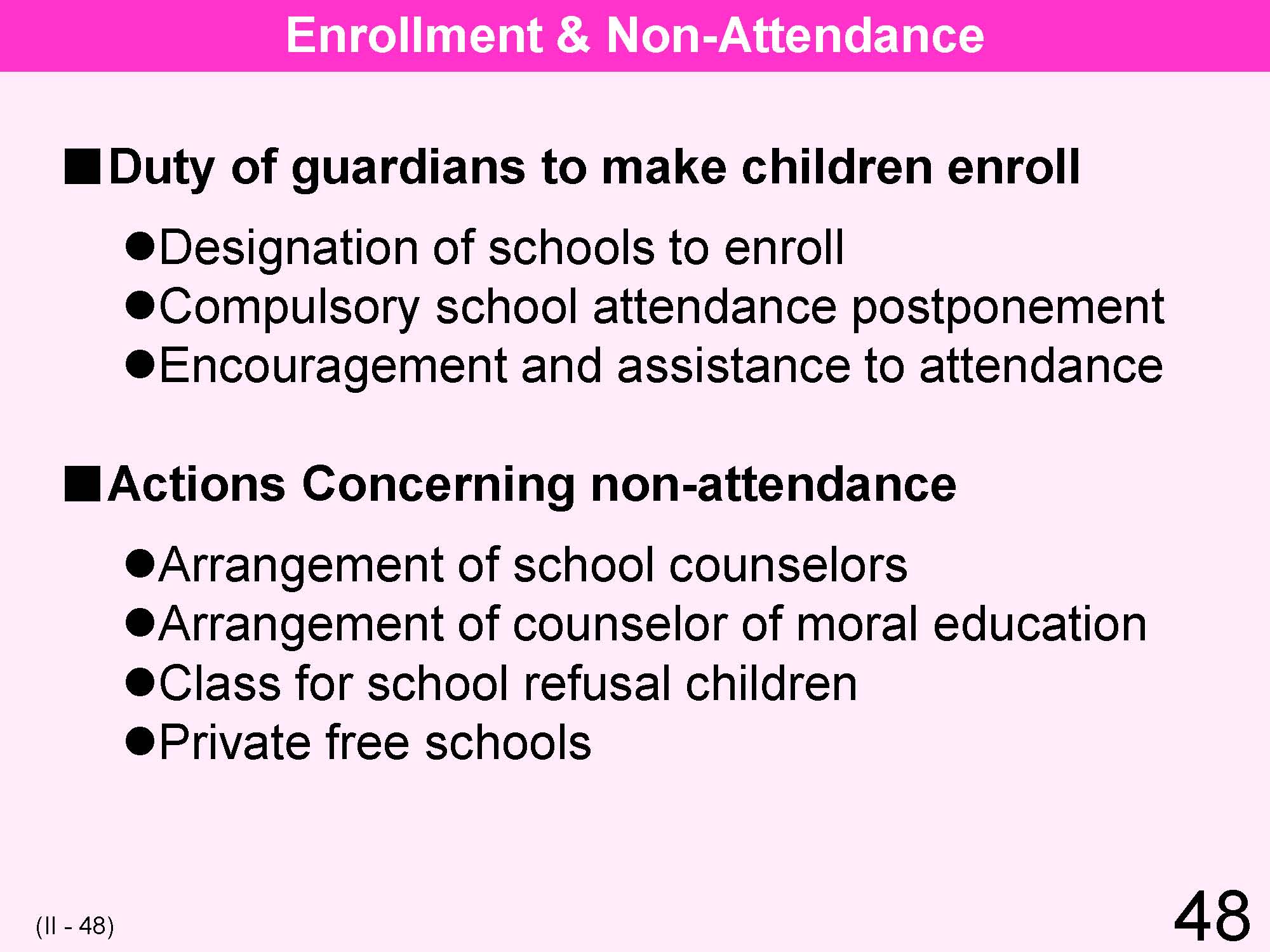 |
Japanese parents have an obligation to send their children between the ages of 6 to 15 to school. Today, there is an increasing number of school-refusal (absentee) students for various reasons, even though in theory such students are formally enrolled. The need to deal with such school-refusal (absentee) children represents an important task that needs to be addressed within current school policies. (Non-attendance -->V-20 - 24) |
| 49 | 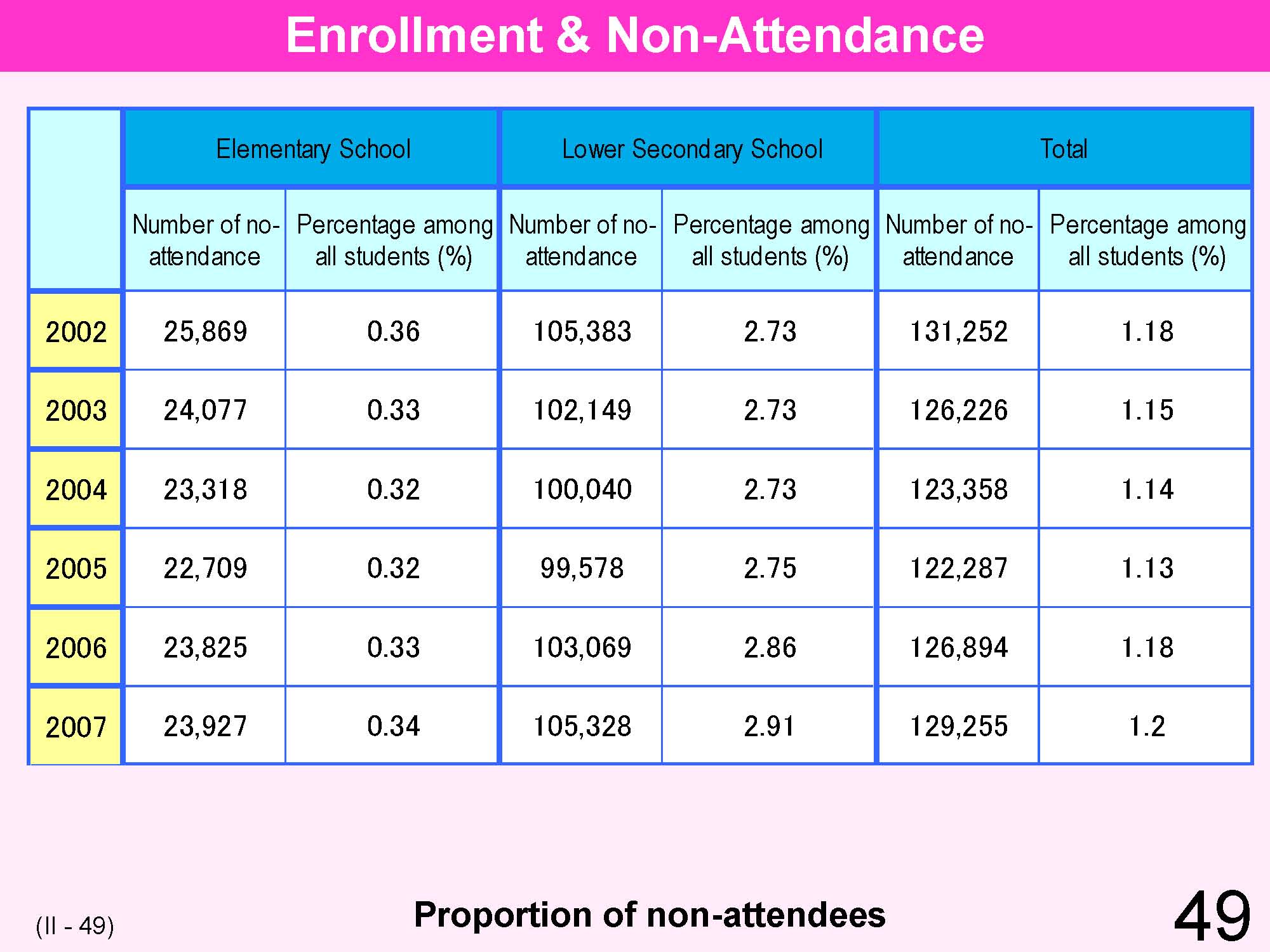 |
The number of students who are absent from school for more than 30 days a year is increasing, not for a valid reason like illness, but for “non-attendance,” which means they can’t or don’t want to go to school. As of 1999, 1 out of 288 students at the elementary school level and 1 out of 41 at the lower secondary school level were recognized as non-attending (absentee) students. -->http://www.mext.go.jp/b_menu/houdou/14/08/020820c.htm (Non-attendance -->V 20 - 30) |
| 50 | 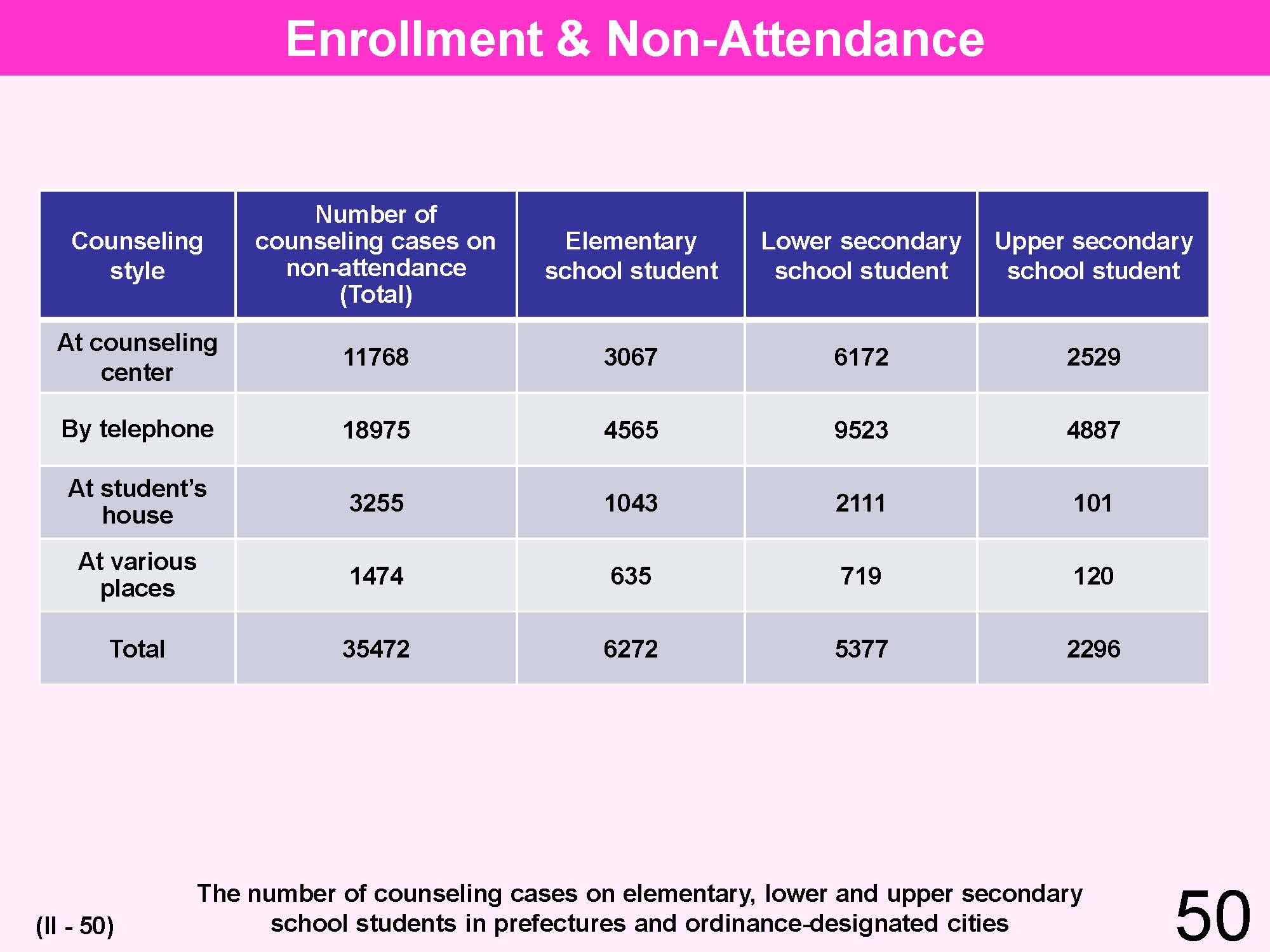 |
|
| 51 | 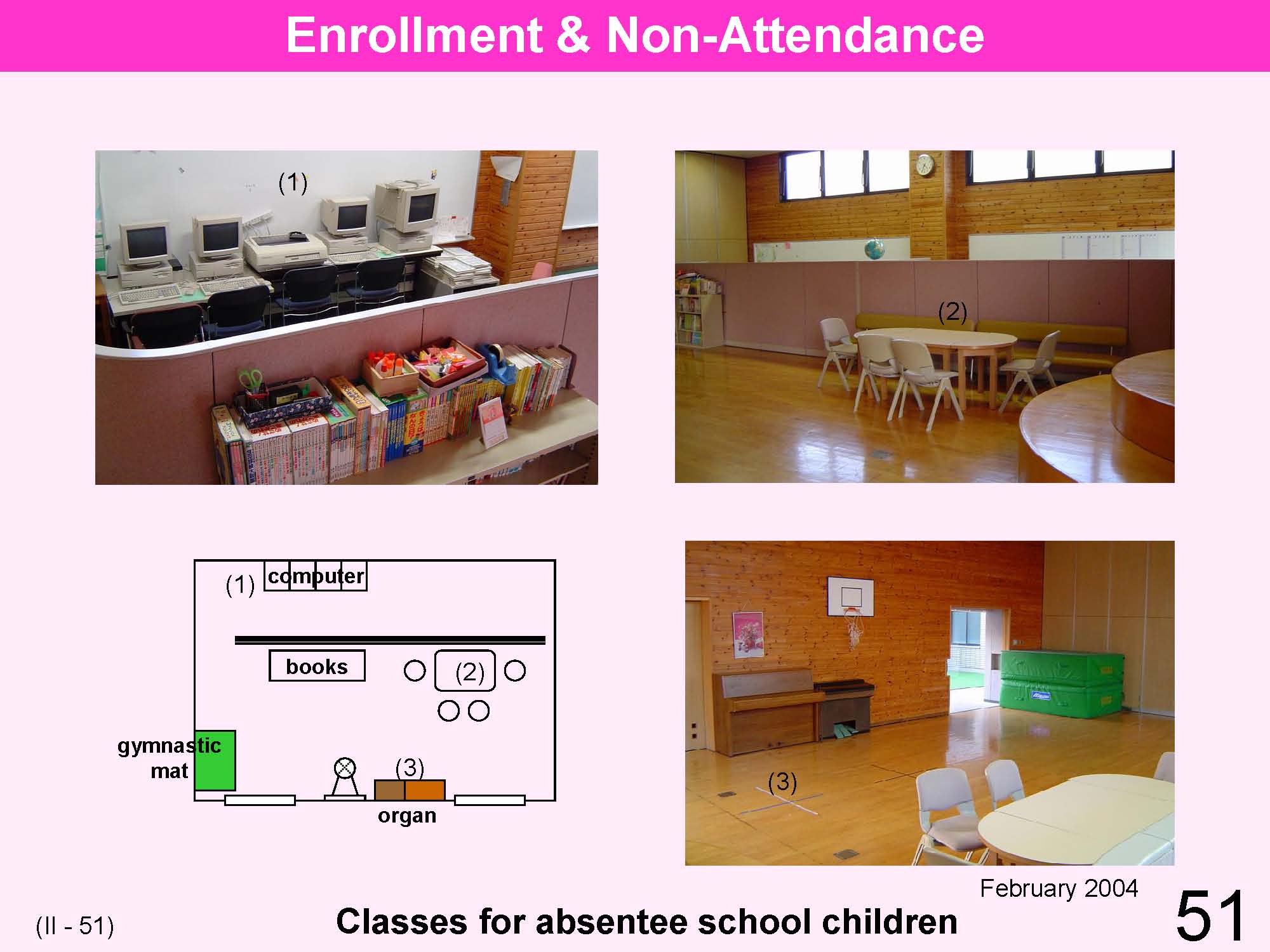 |
In addition to special classes for school absentee children, there are similar facilities also in private free schools (-->V25) and free spaces to provide educational instruction for school dropouts. Attendance at these classes is considered equivalent to school enrollment. (Measures for School Refusal -->V 20 -30 ) |
| 52 | 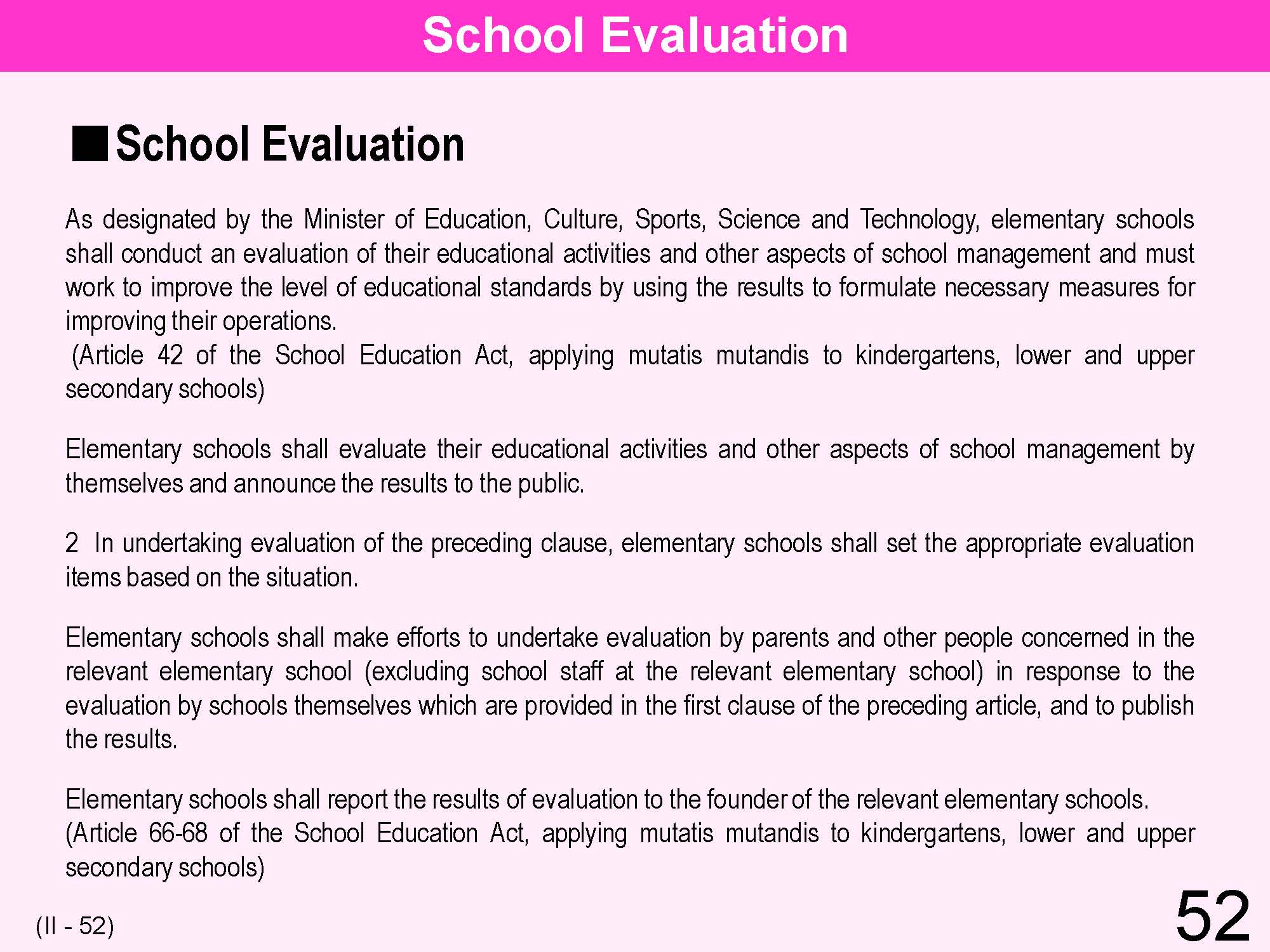 |
Based on the criteria for establishing new elementary/secondary schools as enacted in 2002, self- inspection and self-evaluation of schools has become an obligation. A regulation providing for a similar obligation was added to the criteria for school establishment for schools at other educational levels such as upper secondary schools and specialized training colleges. This provision was deleted, due to the revision of the School Education Act in 2007 which makes school evaluation a legal obligation. |
| 53 | 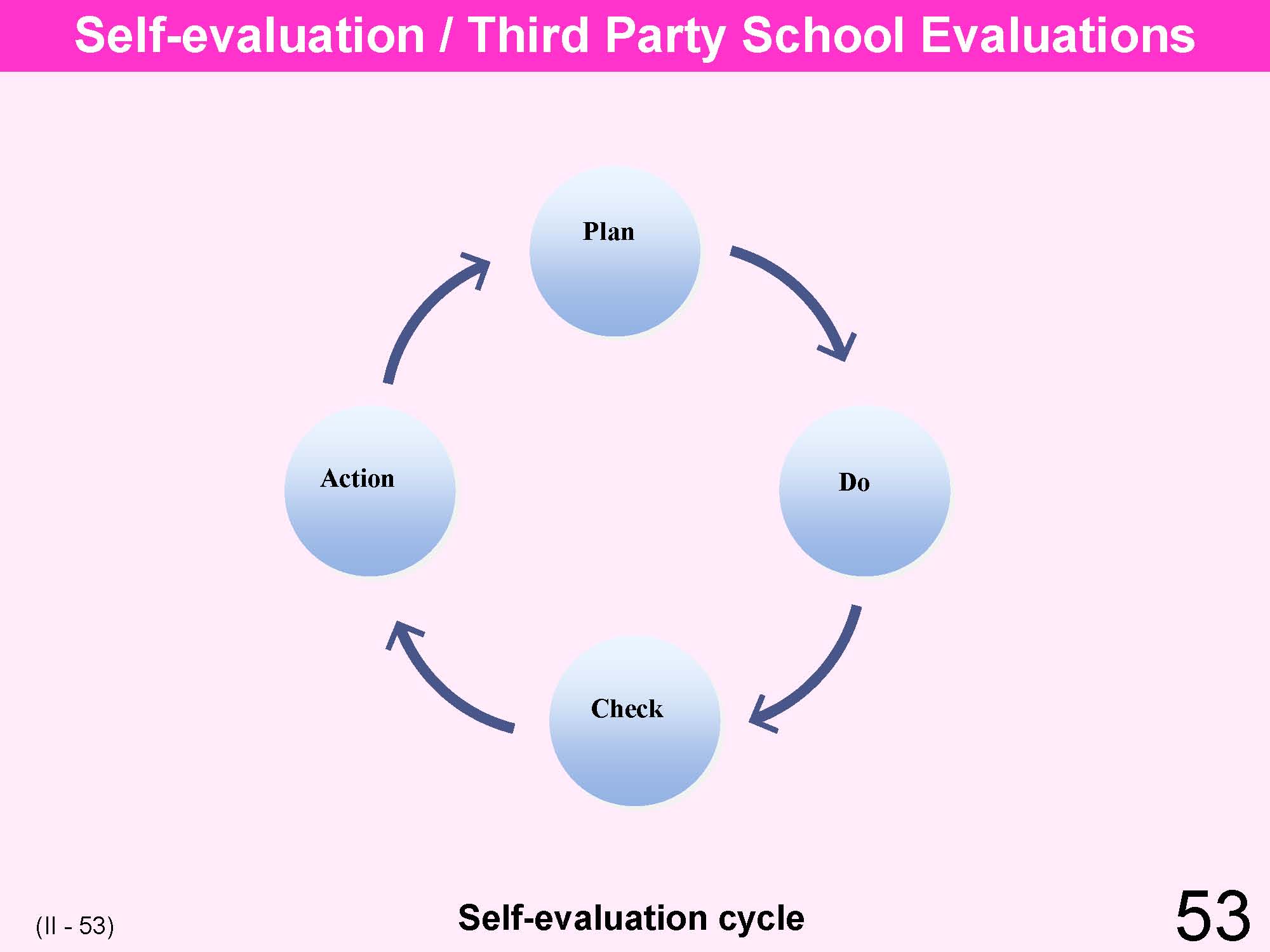 |
Generally, school evaluations are based on “management in accordance with objectives” derived from business management methods. In practical terms, school evaluations are conducted based on the “Plan, Do, Check, Action cycle.” |
| 54 | 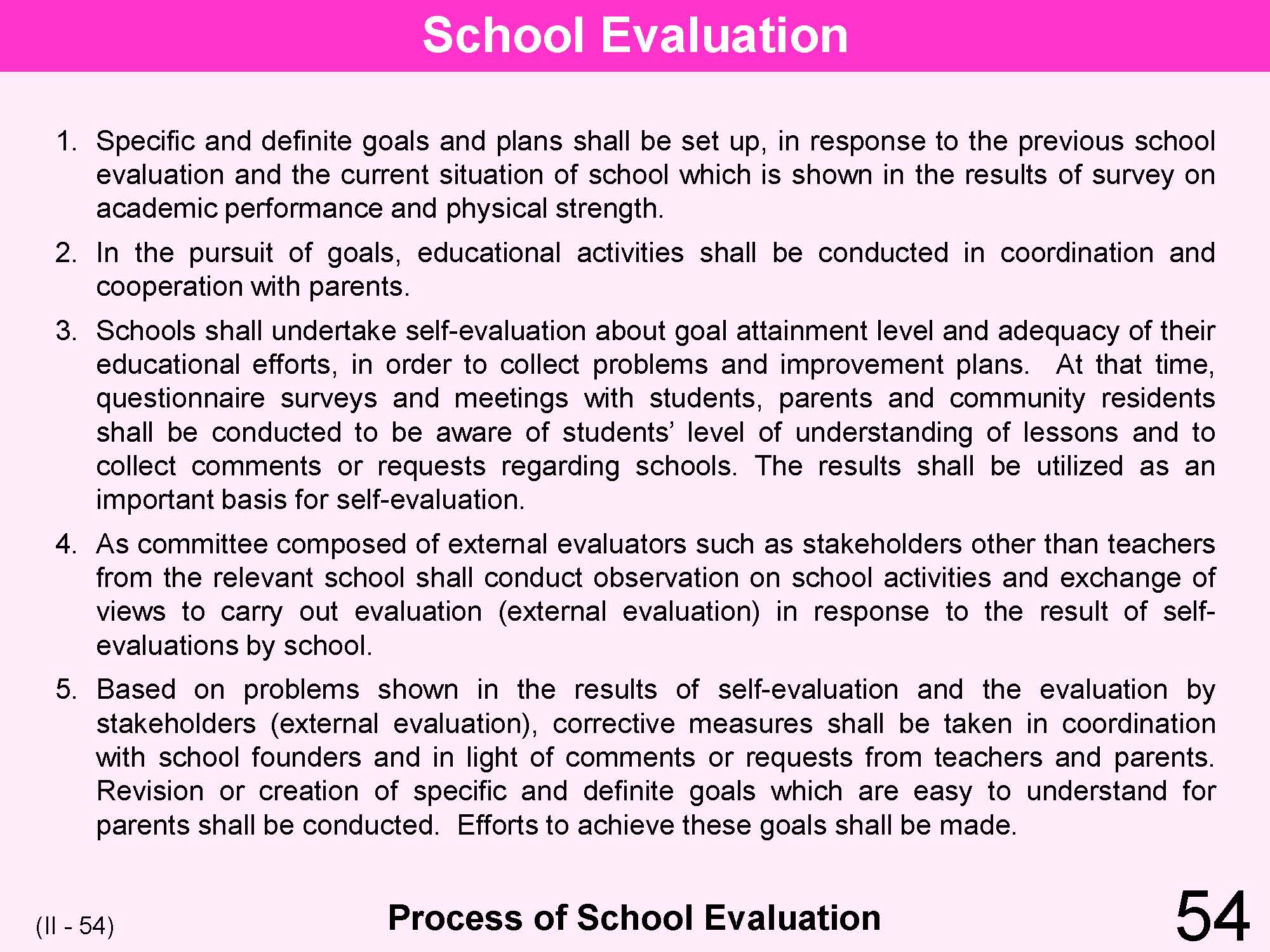 |
It is important that numerical target sand action targets are set during annual planning phases in schools in order to evaluate progress. There are, however, some problems that derive from the difficulty in quantifying aspects and outcomes of school educational goals and targets each academic year. |
| 55 | 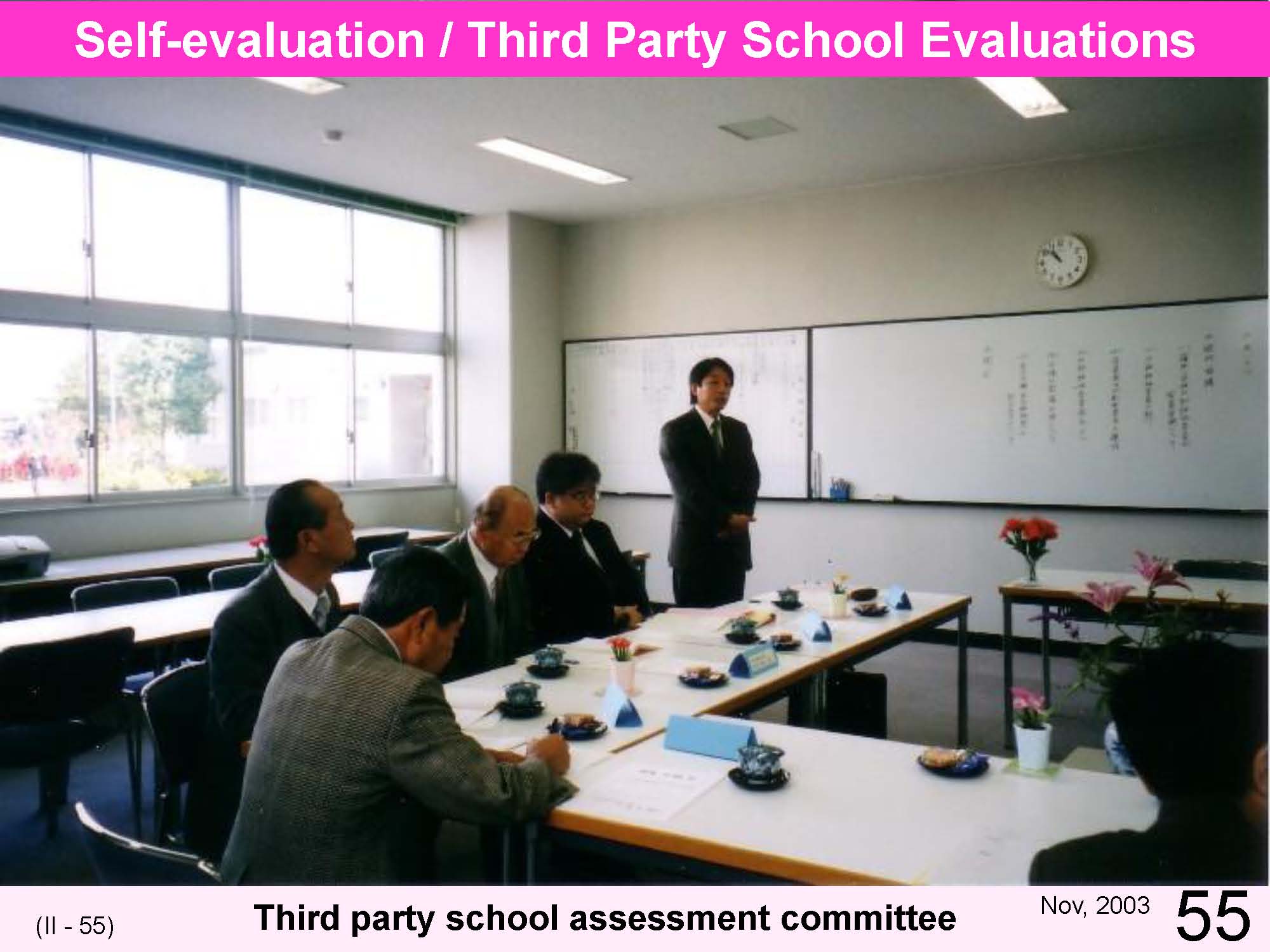 |
External school assessments have not become obligatory under existing ordinances. However, many schools voluntarily have started to assess the validity of self-inspections and the self-evaluations. The main approach is to survey opinions of parents to help them to participate in accountability. Third party school assessments have been introduced in some schools and are carried out by third parties such as educational researchers, sometimes by involving them in the school boards. |
| 56 | 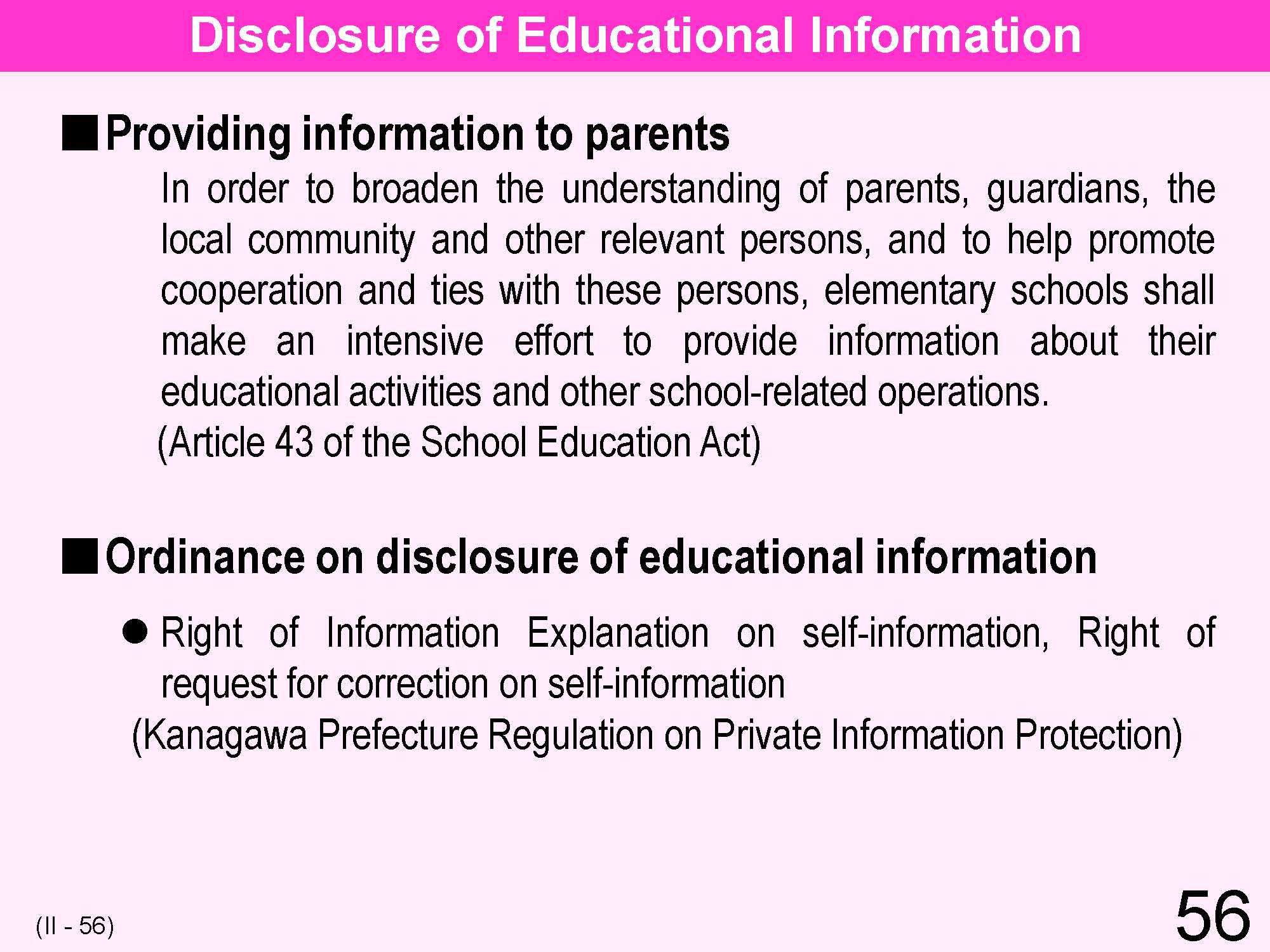 |
School Education Act is covered in the regulation that schools shall actively open their information along with school evaluations to the public. A key element of debated concerned how far the Free Access to Information Ordinance or the Protection of Personal Information Ordinance of local regional bodies applies to personal information on education. Recently an increasing number of lawsuits and claims have opened the release of information on such aspects as school guidelines, which previously were not open to the public or to individuals. |
| 57 | 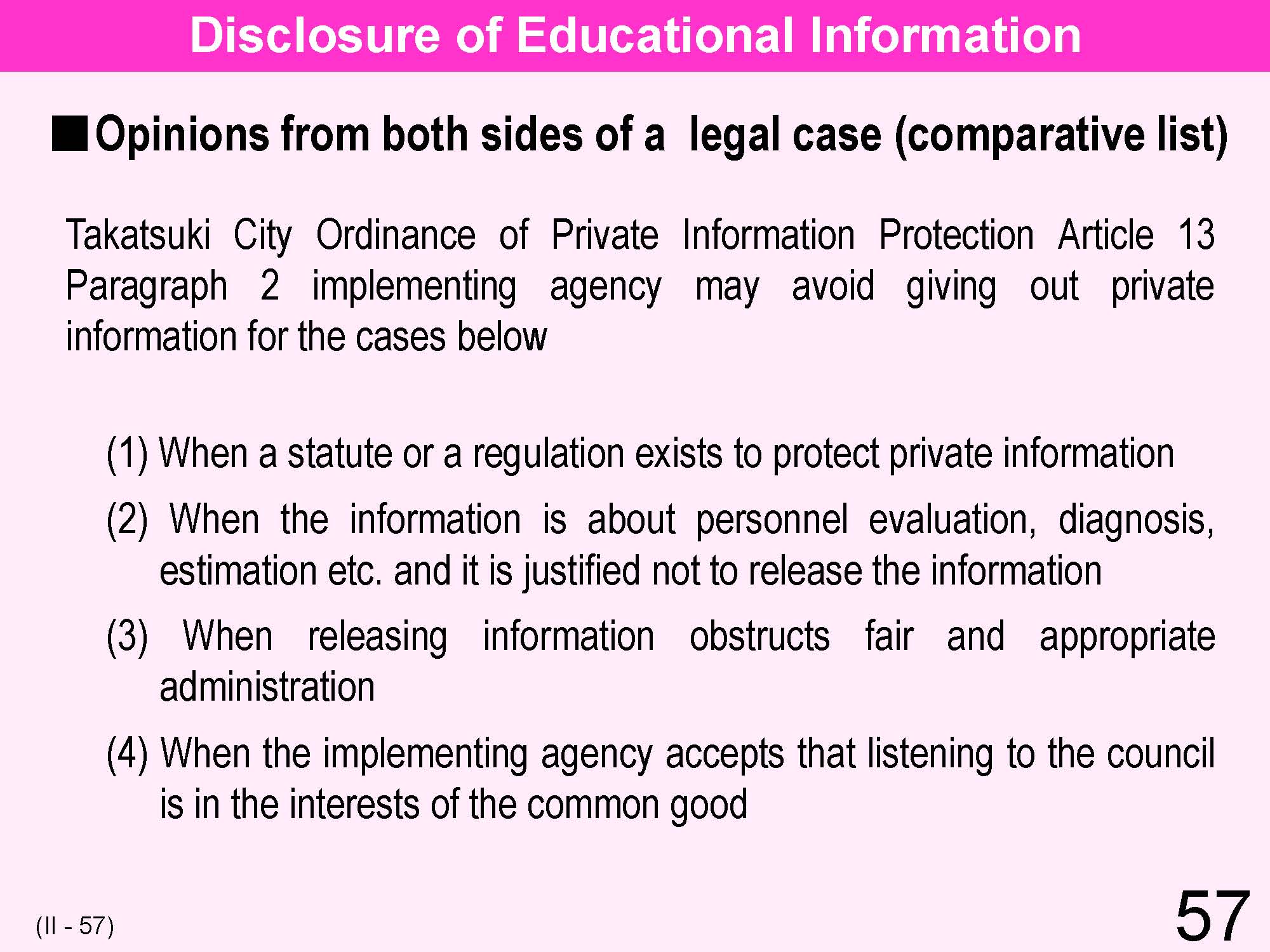 |
*The argument of the plaintiff (The person who asks for disclosure of information) (1) A precedent proves that Article 13 of the Constitution protects the right to privacy. This right includes the right to control private information. Therefore a student has the right to see his/her own school transcript. (2) The student’s right to see his/her own education information is guaranteed in Article 26 of the Constitution, as the right to education. (3) There is no negative effect, such as undermining the relationship of trust between the student and the teacher, by the student’s perusal of his/her school transcript. Therefore, school transcript will be excluded from non disclosure documents, and nondisclosure of school transcript is illegal. *The argument of the defendant (The municipal board of education) (1) The right to control private information is not set as a positive law. The right to ask for disclosure of private information as in this case, is founded in regulation. (2) There is a bad effect such as not being able to secure the fairness of the content if you disclose the school transcript to the student. School transcript will be included in the non disclosure document, therefore, the decision of nondisclosure is not illegal. |
| 58 | 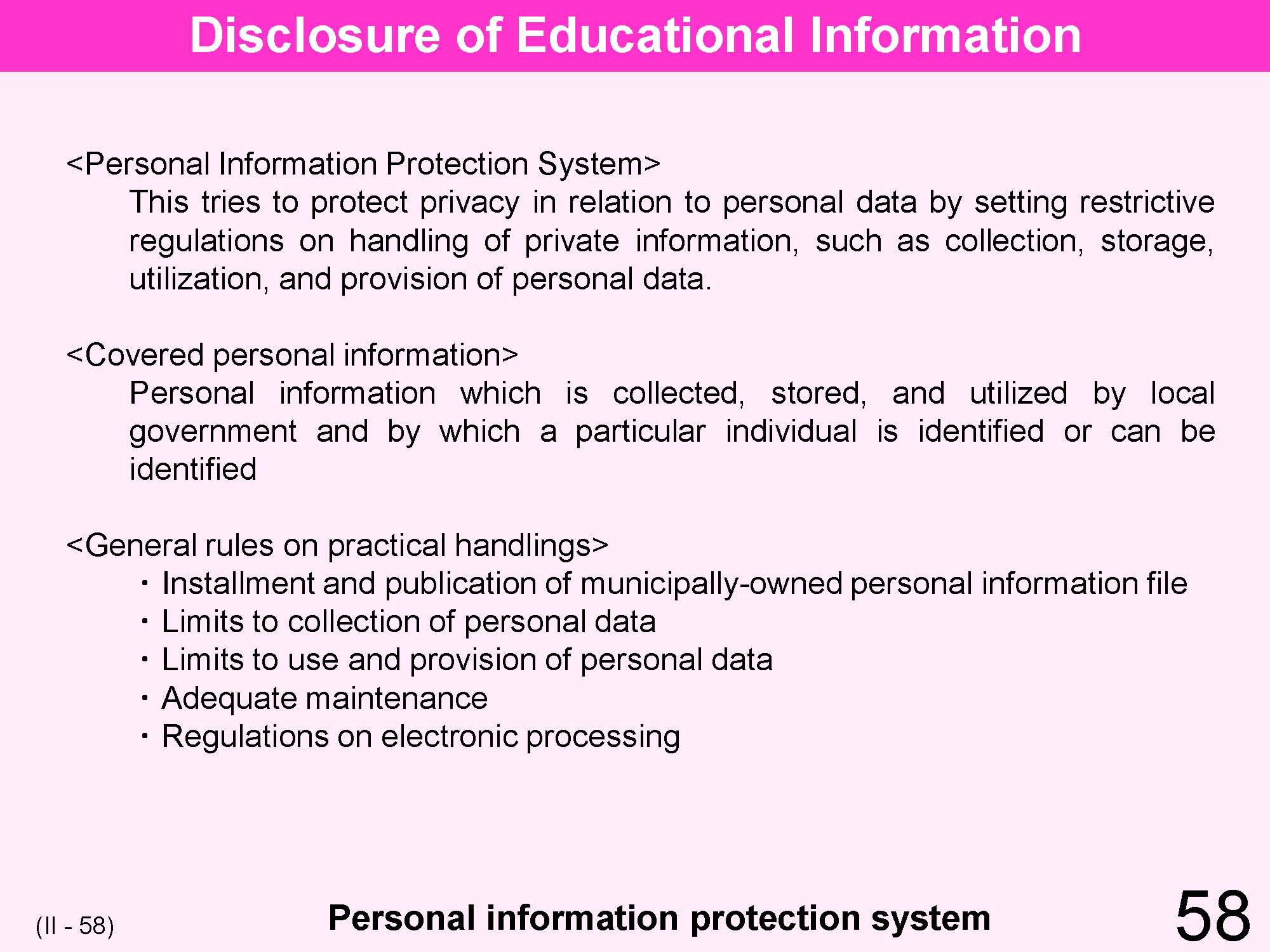 |
The Supreme Court handed down a freedom of grade evaluation or verdict in a November 2003 case where a 23 year-old woman had pleaded for the disclosure of her school record at elementary school. That was the first judgment by the Supreme Court about the disclosure of school records to the said person. http://www.asyura2.com/0311/nihon10/msg/699.html -->table; www.psn.ne.jp/~jhc-cebc/s-zyouhou/naishin.htm |
| 59 | 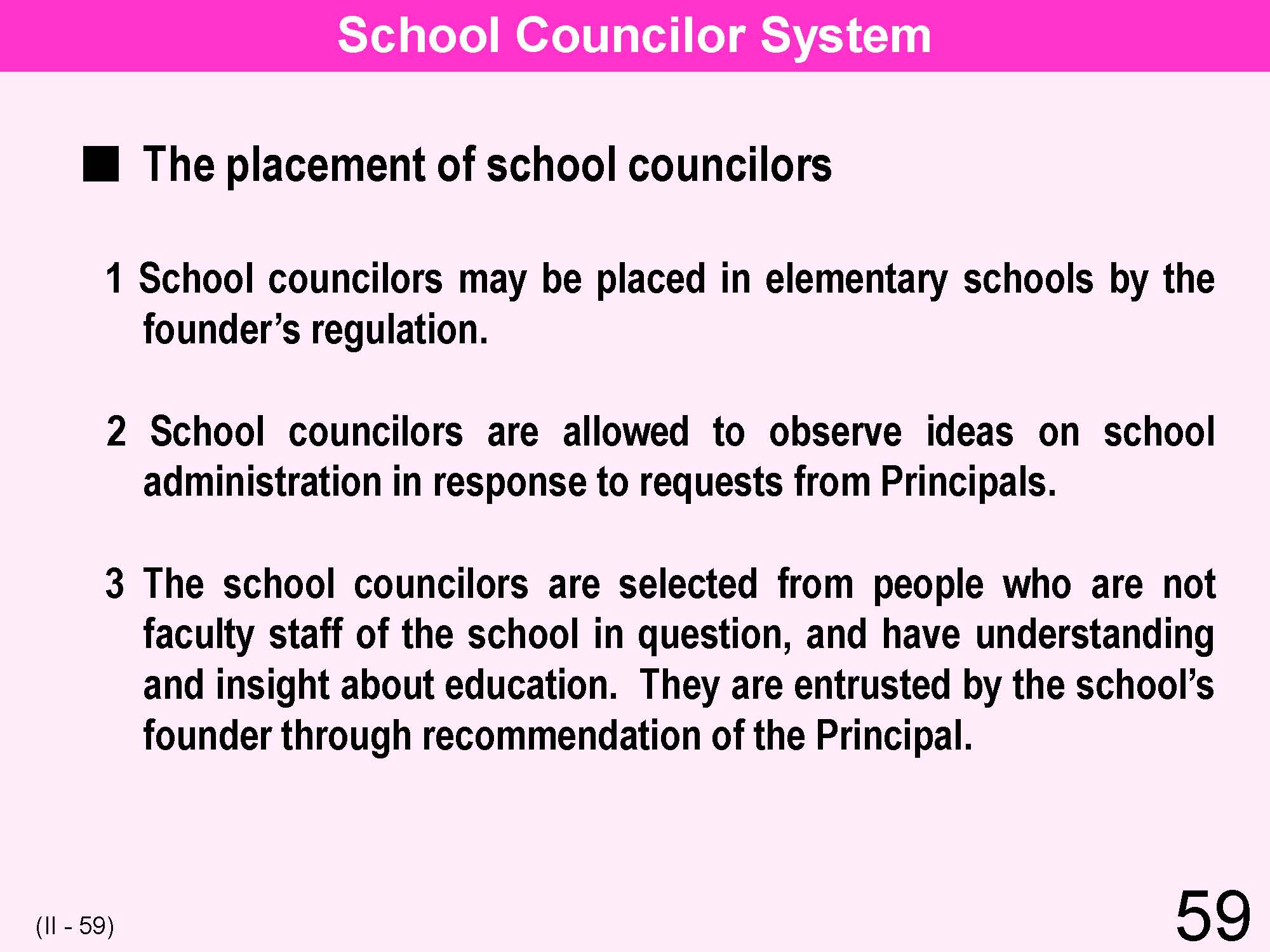 |
The school councilor system is defined as “the role which is newly formed as the mechanism of local people’s systematic commitment to school administration” “to encourage the future school to be administered systematically and flexibly under the leadership of a Principal, in an independent and autonomous fashion, in order to be able to evolve a distinctive school program that complies with the actual conditions of students and local communities”. (A Notification from Administrative Vice-Minister of Education, January 21st, 2000.) The system needs to be accountable to and reflect the demands of parents and local communities for effective school administration. |
| 60 | 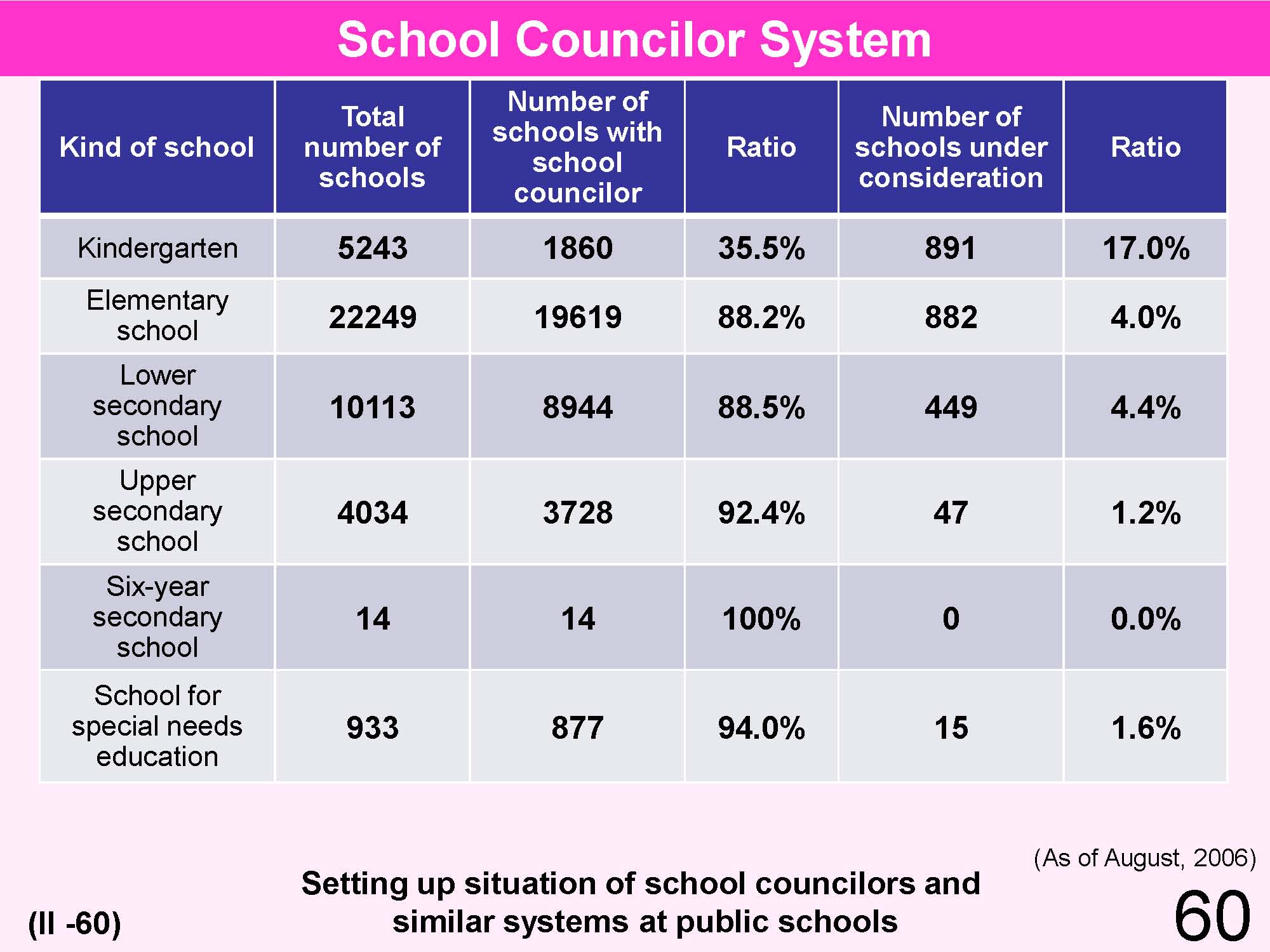 |
|
| 61 | 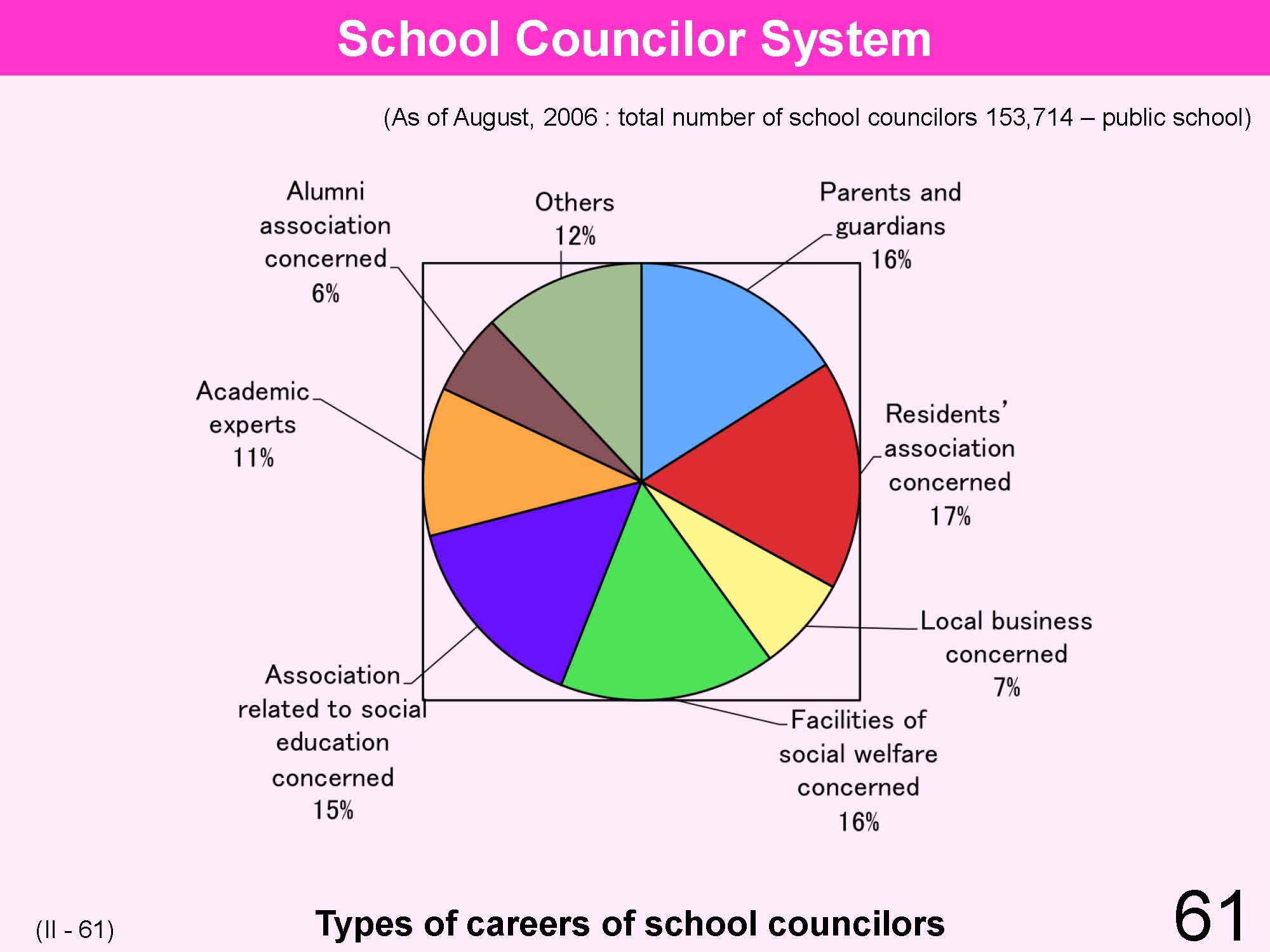 |
Among school councilors, persons involved in neighborhood associations comprise 17%, which is the largest proportion. Parents and persons who have worked at facilities of social welfare concerned comprise 16% each, persons involved in association of social education comprise 15%, academic experts comprise 11%,persons who have worked in private companies comprise 7%, and persons from school alumni associations comprise 6%. |
| 62 | 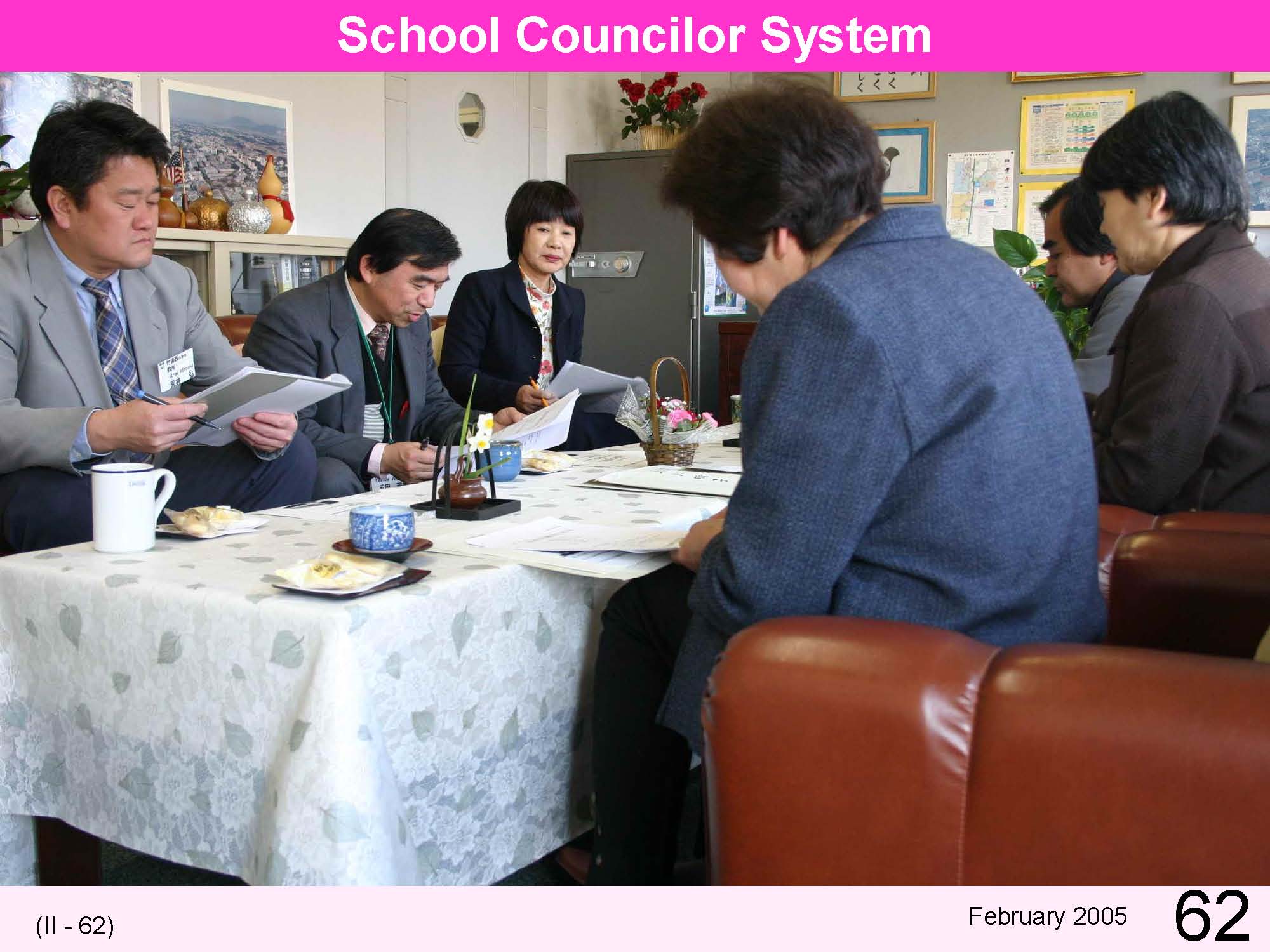 |
From left side; head-teacher of academic affairs (-->VI-21), vice principal, principal (-->VI-12 - 15), school councilor 1,2,3 |
| 63 | 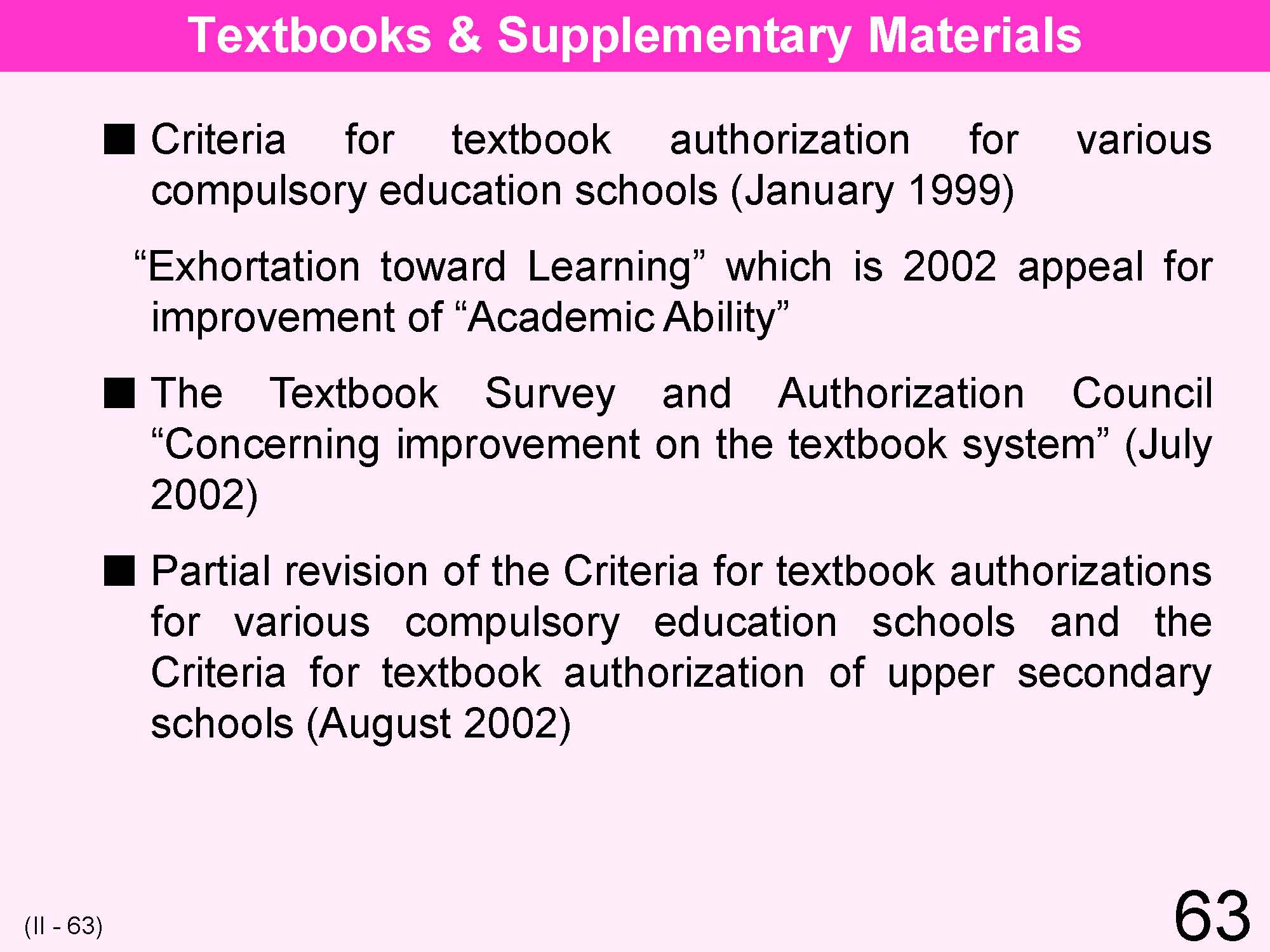 |
In order to promote and ensure “Academic Achievement” under the 2002 appeal, three things were done: re-interpretation of Course of Study as a minimum standard; incorporation of contents for promoting improved learning from textbooks; and revision of the Criteria for textbook authorization for various compulsory educational schools. In other words: (1) Following the objectives of the Course of Study of elementary and lower secondary schools and paying attention to contents and treatment; (2) Avoiding insertion of unnecessary elements into the contents of textbooks based on the treatment of contents in the official Course of Study. Regarding the contents of books that are not textbooks, it is possible to link up aspects not covered in the Course of Study with contents that are already there without deviating from the aims and meaning nor burdening students with extraneous information, and (3) The contents of books should corresponded with the levels of mental and physical development of students, and neither be too high or too low in terms of students abilities. |
| 64 | 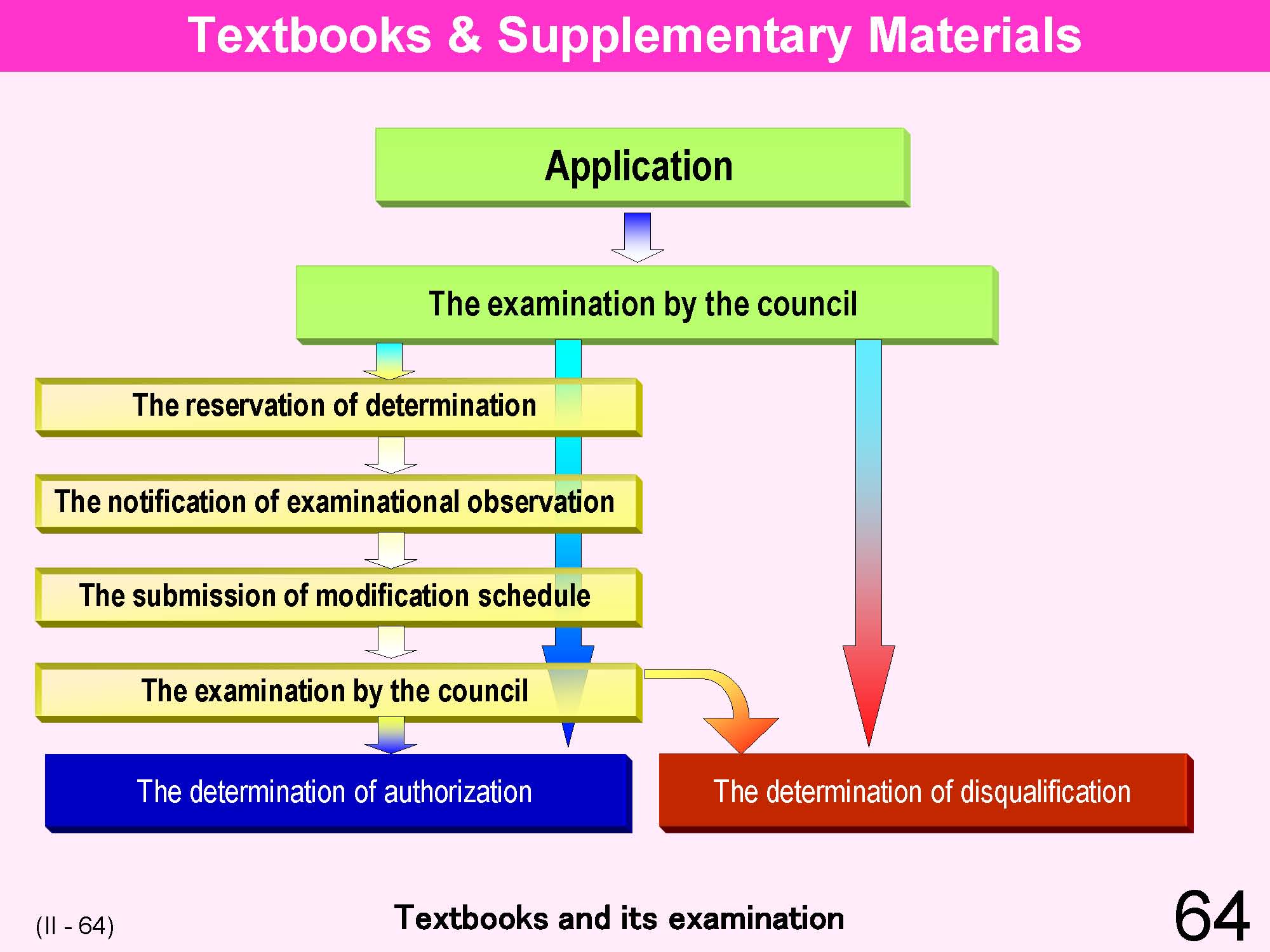 |
Textbook authorization means that a book that is a candidate to be a school textbook is examined for whether it is proper for subject-use, and authorized as an appropriate book for use as a textbook. The process proceeds as follows: 1. An author or a publisher of a book applies for book authorization to the Minister of Ministry of Education, Culture, Sports, Science and Technology (MEXT). 2. The Minister of MEXT determines whether to authorize or disqualify the book as a text book based on hearings of the Textbook Survey and Authorization Council, and notifies the applicant of the results. 3. In the case of the reservations regarding the determination, the council needs to receive a notice regarding the examination and the submission of a modified schedule, undertake a hearing, and then make a decision either to authorize or disqualify the book. When the Minister is going to decide to disqualify a book, s/he notices the reasons for it beforehand and listens to objections from the book applicant. If an appeal is filed by the applicant within 20 days after receiving the notification of examination from the MEXT minister and, it is recognized as reasonable, and the Minister withdraws the initial notification in question. |
| 65 | 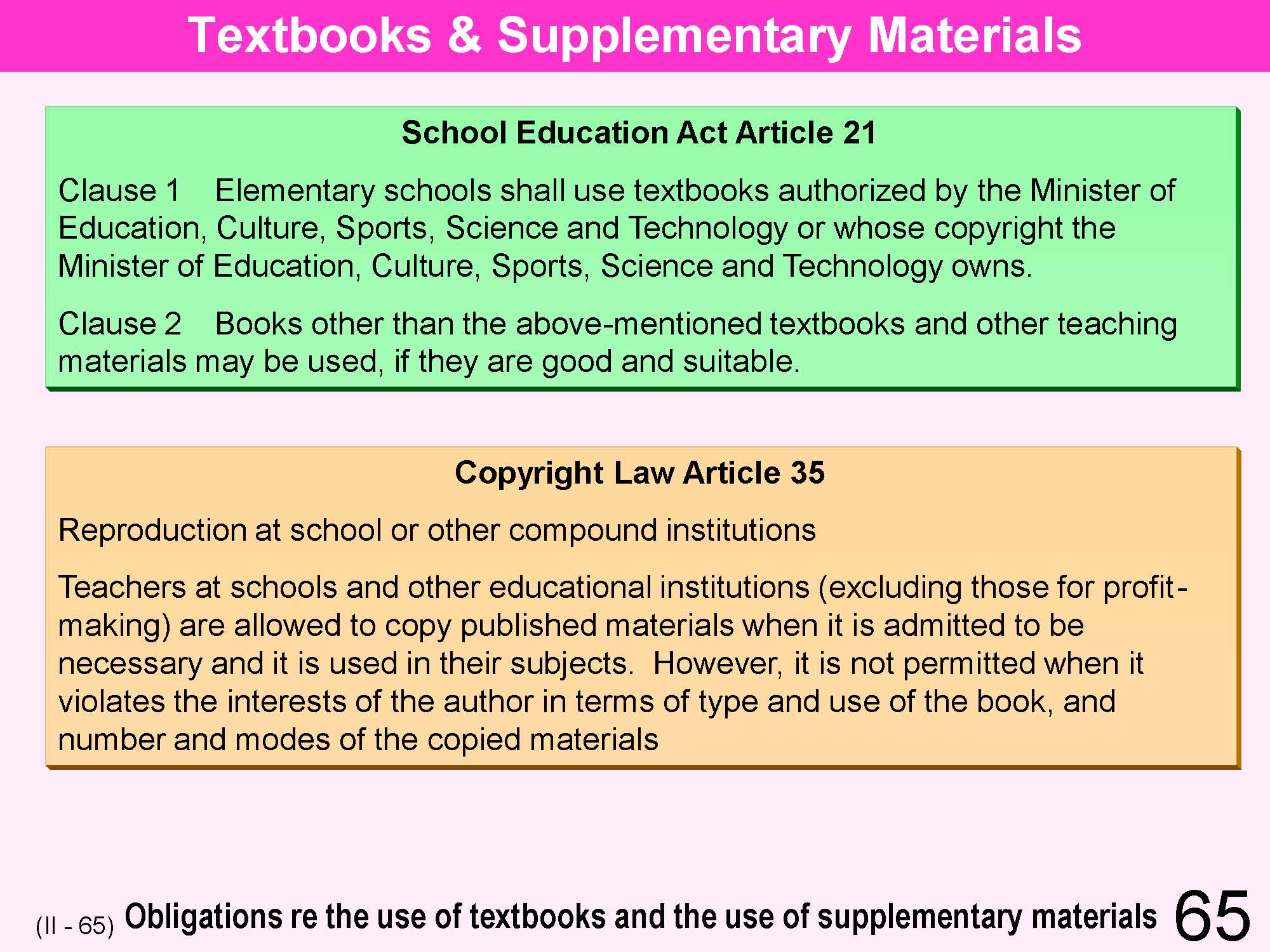 |
Article 21, Clause 1 of the School Education Act An elementary school should use school textbooks approved by MEXT (the Minister of Education, Culture, Sports, Science and Technology) or school textbooks owned MEXT. Article 107, the School Education Act Regardless of the provision of Article 1, the Clause 1 of the School Education Act, the MEXT Minister supplies, school textbooks other than those stated in Article 1, Clause 1 can be used in upper secondary schools, upper secondary divisions of schools for the blind, schools for the deaf, and schools for the handicapped other than the blind and deaf, and also in special classes. |
| 66 | 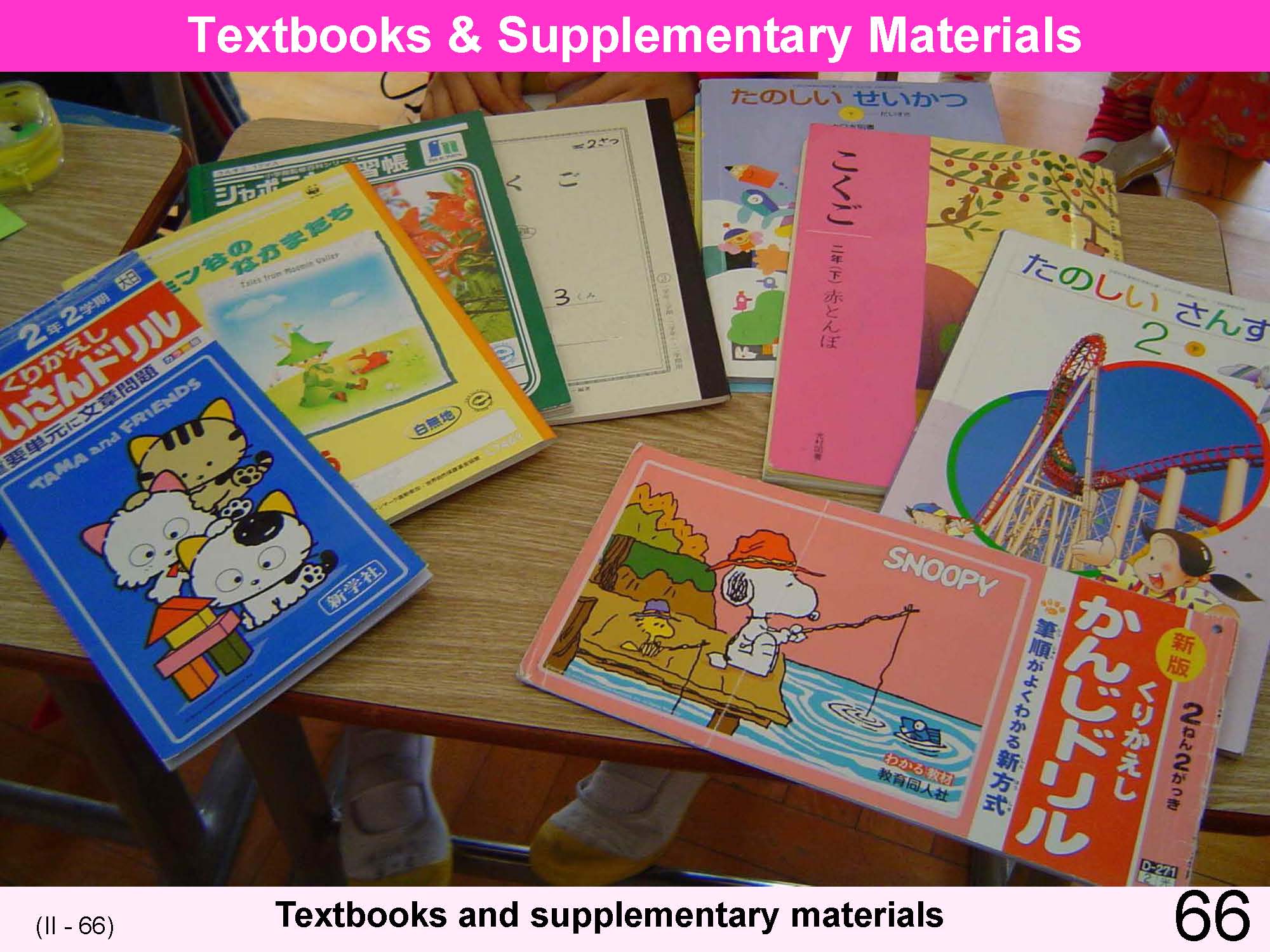 |
|
| 67 | 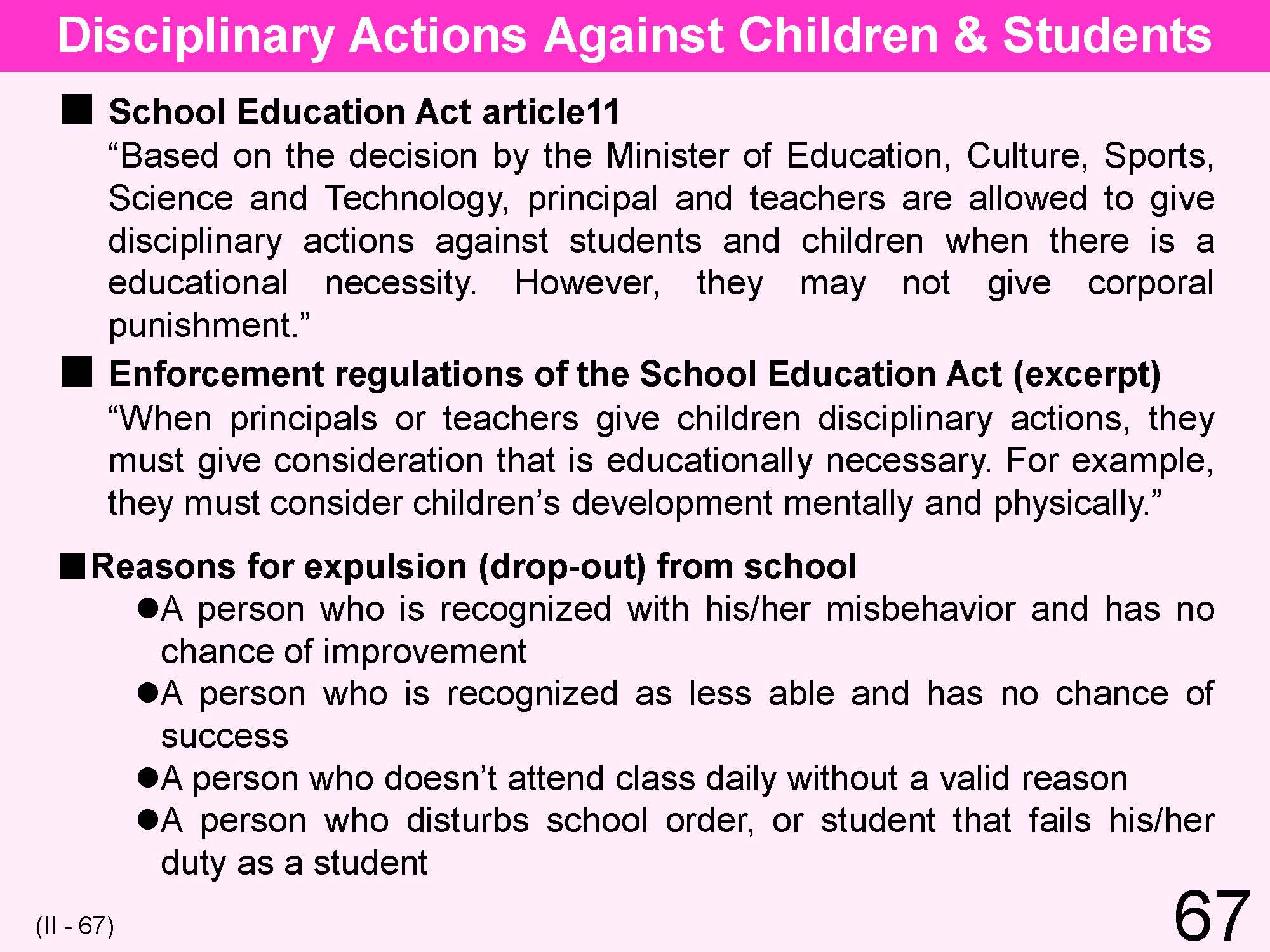 |
Among disciplinary actions, expulsion, suspension and admonition are handled by the school principal. These three are usually called disciplinary actions as punishment. Other disciplinary actions include rebuking, standing, and doing a duty such as a penalty, which can be given by teachers. “Corporal punishment” includes not only physical actions to the body such as hitting or kicking, but also actions that give students physical pain like making them maintain a specific posture for a long time. Since such actions give different levels of pain, such as standing in the classroom and standing under the burning sun, teachers must consider students’ age, health, residential, environmental and other constraints, and must judge if there is any physical pain to a student. School detention is recognized as disciplinary action. However, not allowing students to go to the bathroom or keeping them long after meal time is considered as corporal punishment. |
| 68 | 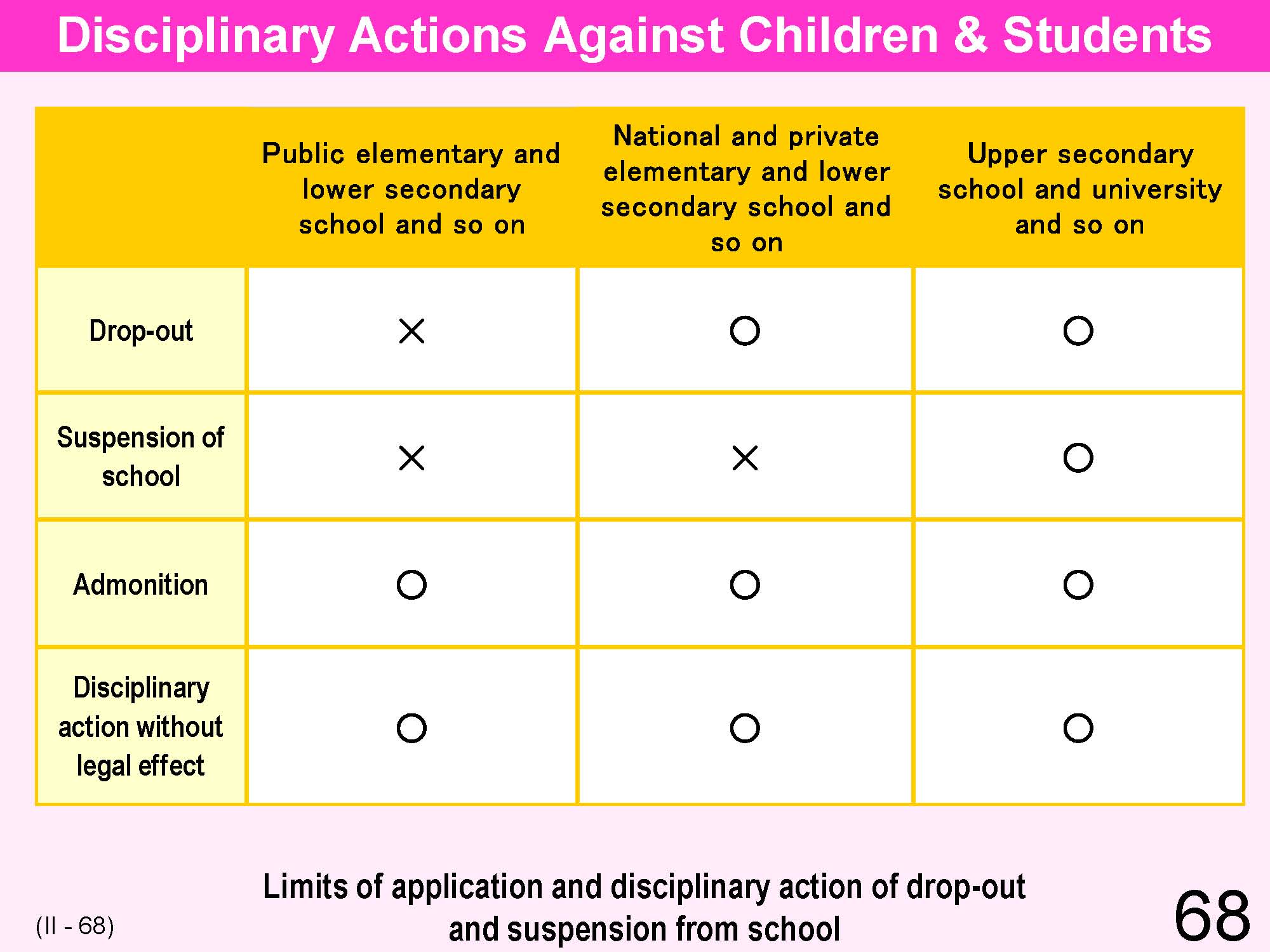 |
When a principal dismisses or suspends students from school and admonishes them through disciplinary action, such actions are generally called disciplinary action as punishment. There are also practical disciplinary actions which can be taken by teachers such as lecturing, forcing students to stand and undertaking duty penalties. Some disciplinary action are set independently by individual schools. For example, absence from school is an offence subject to disciplinary action lighter than actions against drop-out. Some improper student behavior may not be subject to disciplinary action but rather alternative actions may be taken as guidance based on agreements with students. The right to take disciplinary action by teachers applies only to students who belong to the school where the teacher works, although it is not important of the students actually attend their class. Under the guidance structure established at every school, it is important for teachers to understand the character of individual students and their health conditions. There are limits to circumstances where dismissal and suspension from school is an option. This means that it is difficult to dismiss students who belong to public schools and to suspend students of school age. |
| 69 | 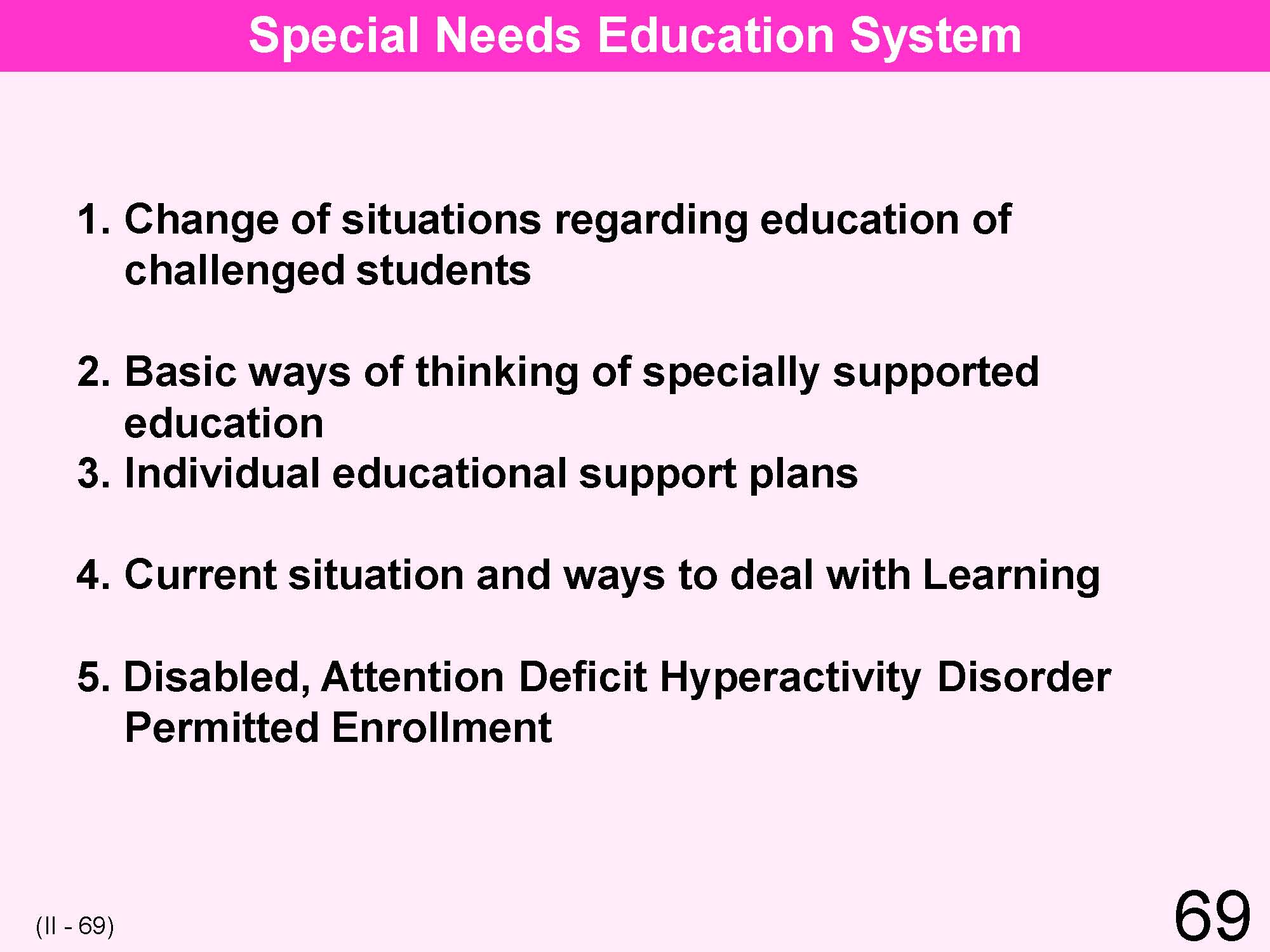 |
The Enforcement Regulation of the School Education Act was amended in 2002 in order to reconsider the approach to guidance on enrollment. This was done so that the appropriate education could be designed to meet the special educational needs of individual students with disabilities, consistent with the changing educational situation for the disabled, such as the the evolution of social norms and the push for decentralization of education. |
| 70 | 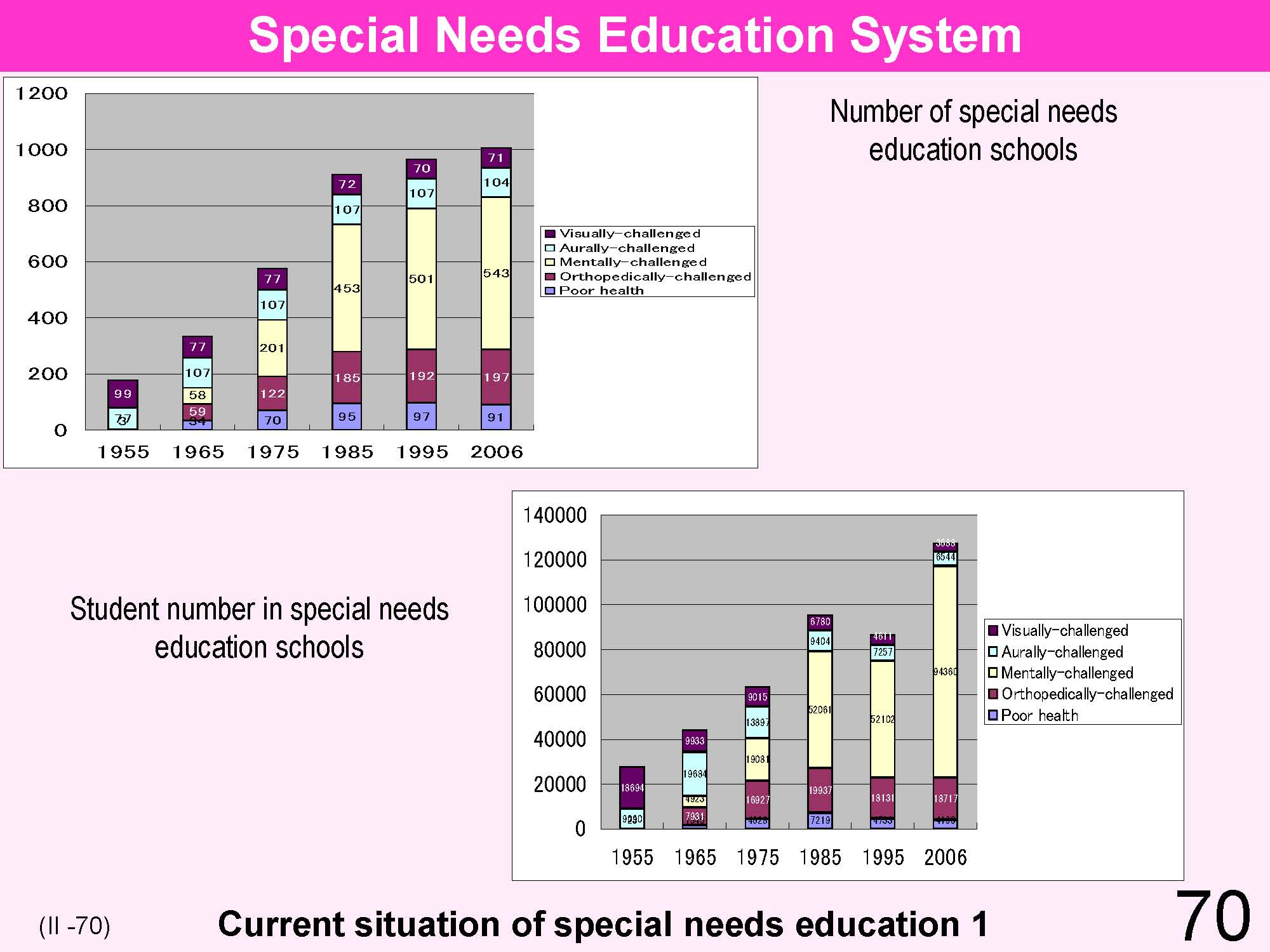 |
Among the infants and students in schools for special needs education (schools for the visually challenged, the aurally challenged and the mentally and physically challenged), the number of mentally-challenged has been greatly increasing. For those children who cannot commute to school due to severe impairment, teachers go to children’s homes, facilities or hospitals to conduct visiting teaching. |
| 71 | 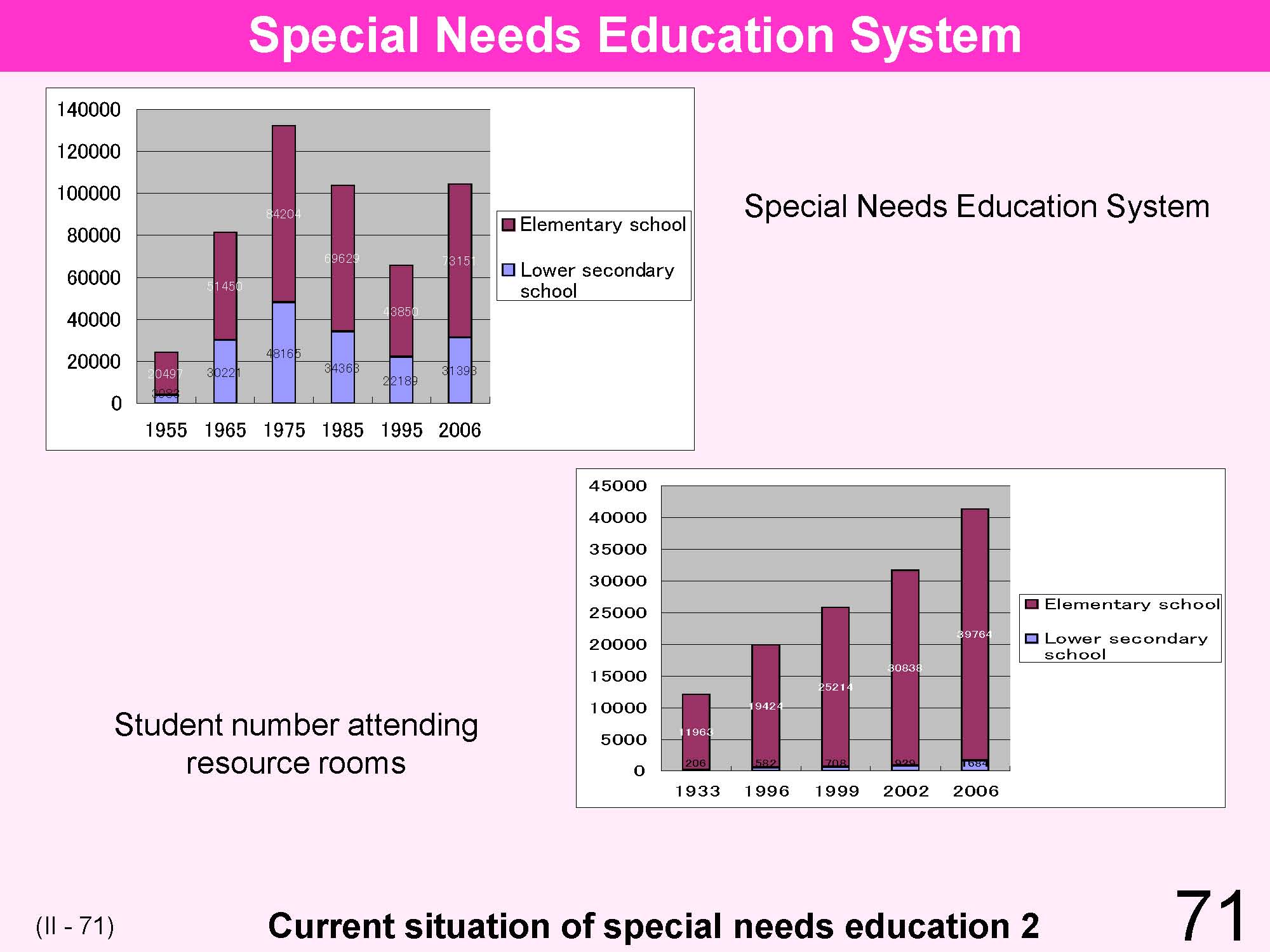 |
Classes for special needs education are small-group classes (up to eight children) which are provided for children with relatively mild impairments, and are established for each type of impairment in elementary and lower secondary schools. There are special classes for children who are mentally challenged, orthopedically challenged, have poor health, weak eyesight, hearing impairment, are vocally-challenged, or have emotional problems. Resource room teaching is the learning style in which children with mild impairments enrolled in regular classes at elementary or lower secondary schools receive most of their lessons at regular class and take some special lessons based on the state of impairment at a special place (resource rooms). Targets for resource room learning are children who are vocally challenged, autistic, have emotional problems, learning disability (LD), attention-deficit hyperactivity disorder (ADHD), weak eyesight, hearing impairment, and others. |
| 72 | 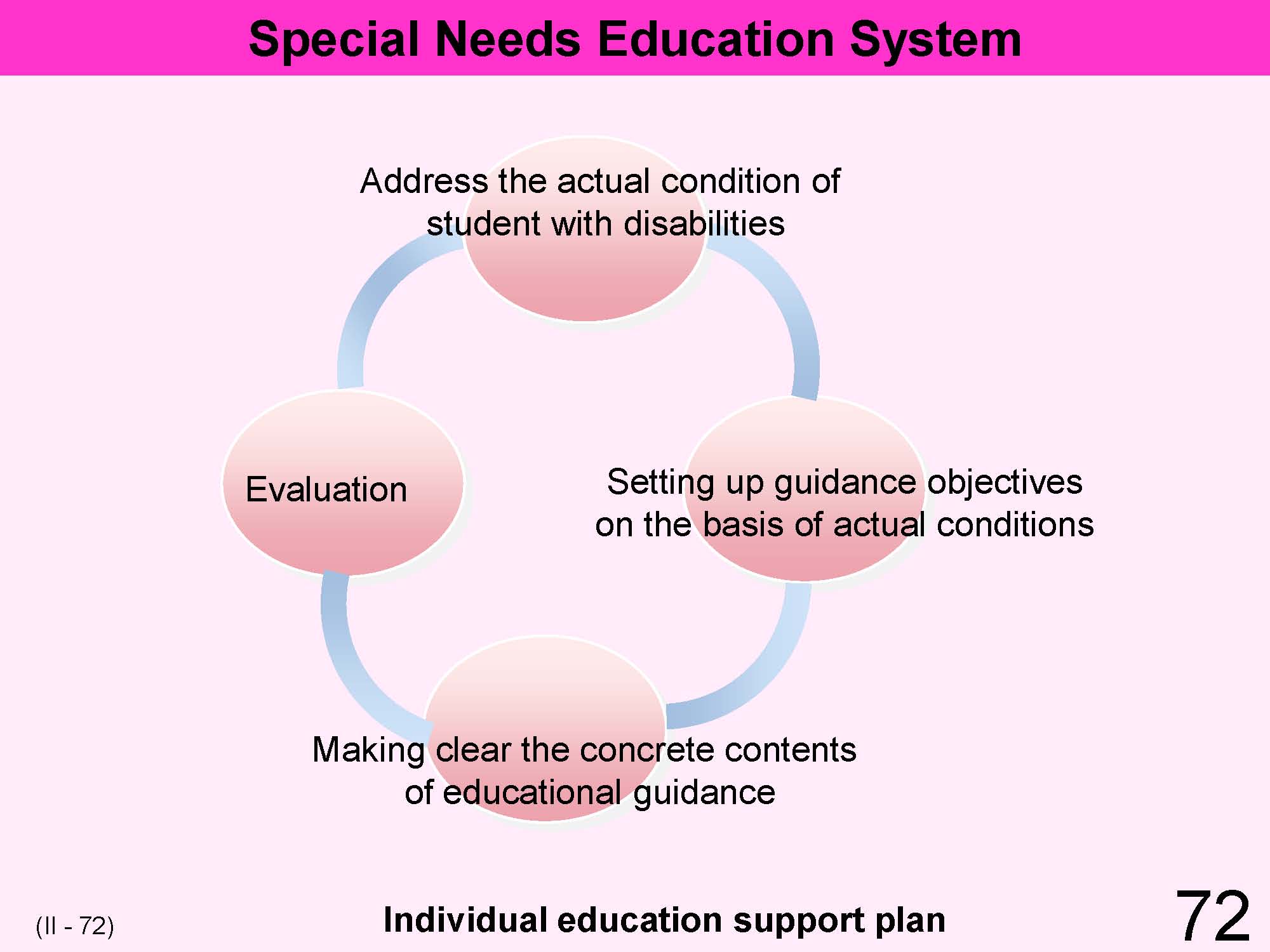 |
Individual education support plans are designed to support challenged students appropriately and consistently from early childhood through graduation from school by using a long-term perspective. It is based on the idea of the need to correctly assess the needs of individual challenged students and to respond to them adequately from the viewpoint of education. The educational support plan has been formulated and revised, including the contents of special educational needs, adequate targets and effective educational support measures along with appropriate staff and organization. |
| 73 | 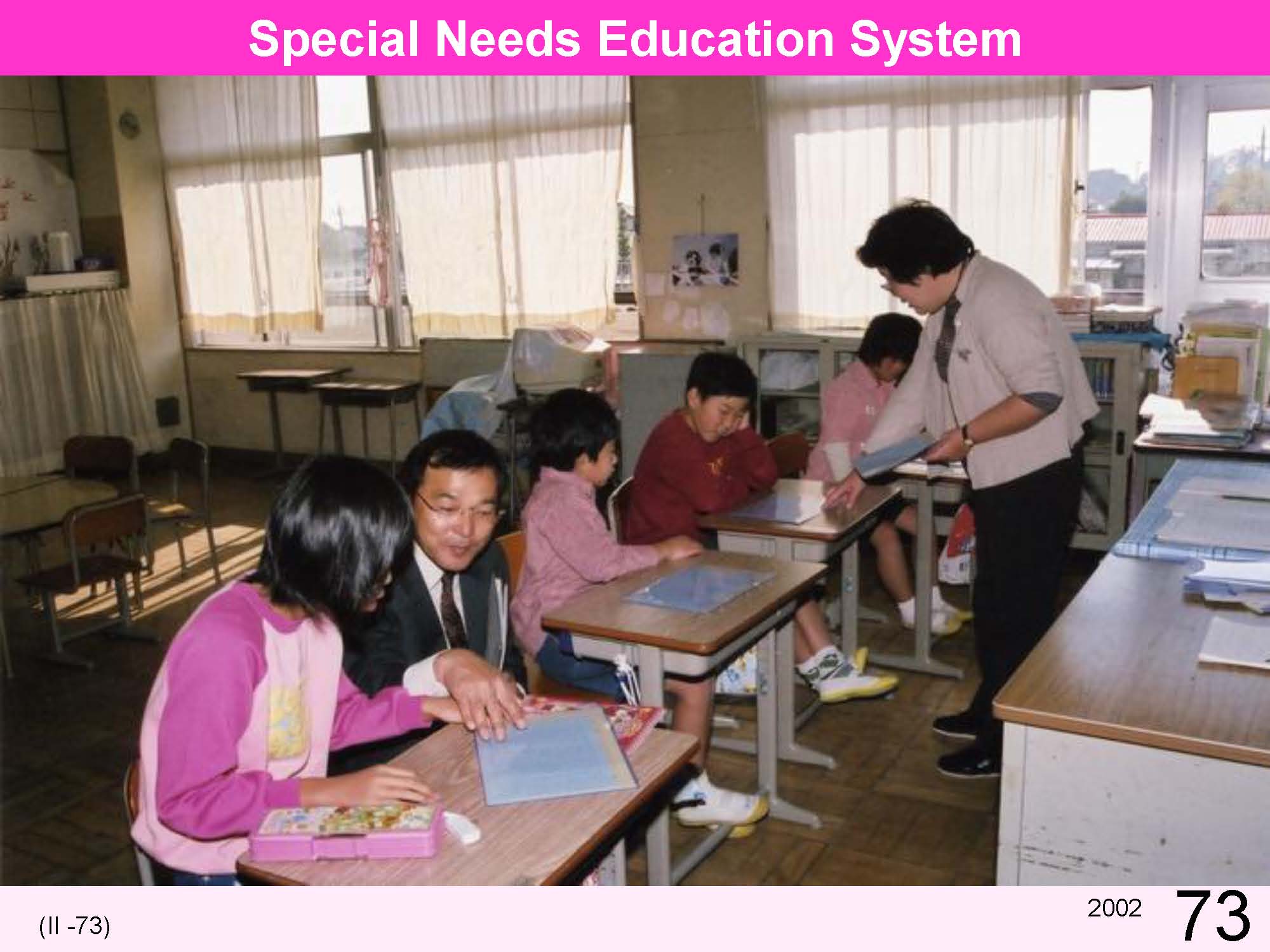 |
The scene of special needs education class. |
| 74 | 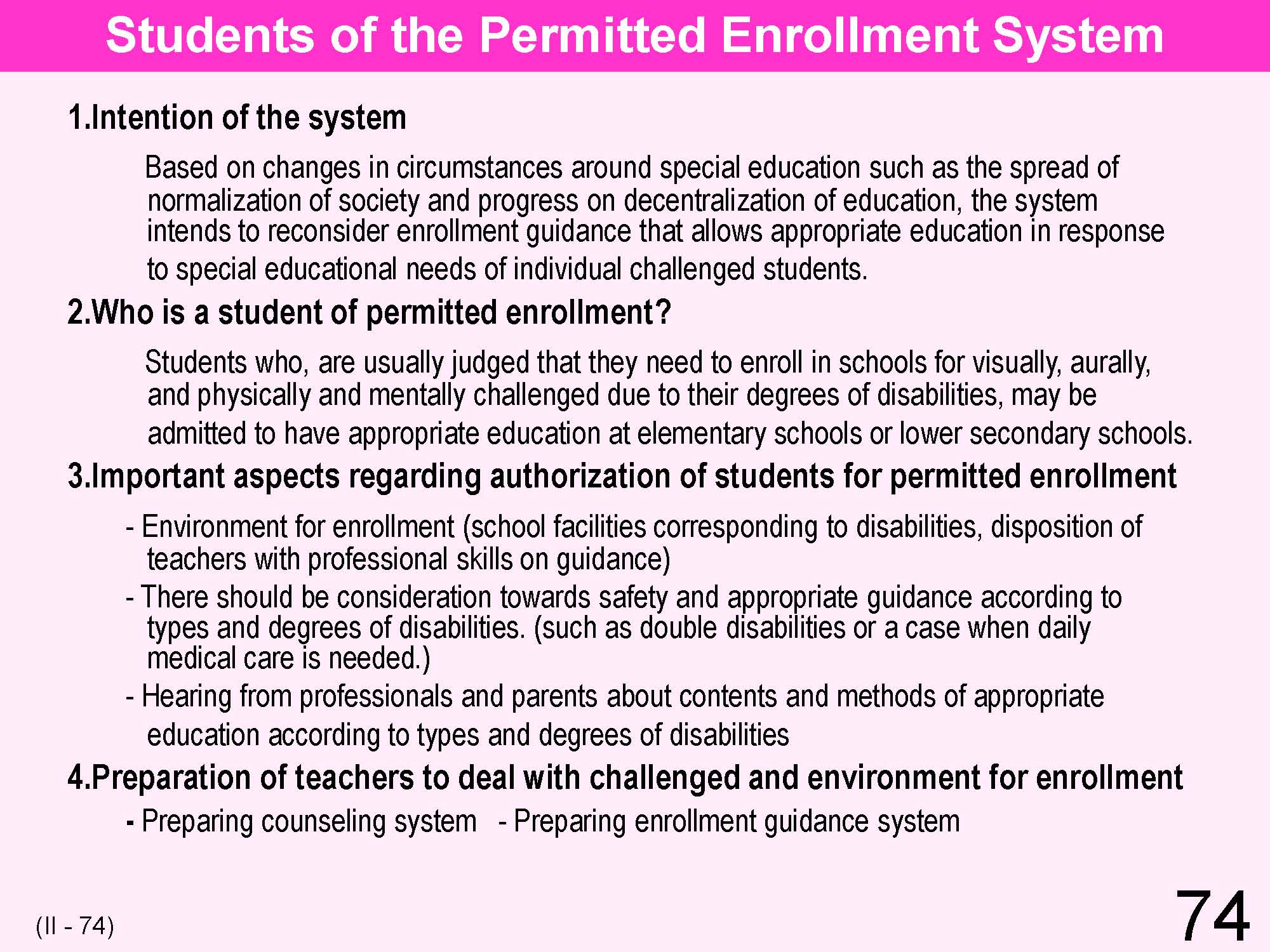 |
The permitted enrollment system allows students with disabilities who meet standard enrollment criteria to enroll in elementary schools or lower secondary schools. The municipal boards of education certify the students’ enrollment, and are required to assess arrangements to ensure a that there is a proper environment for them to enroll, such as availability and placement of teachers who have a high level of expertise in guidance. |
| 75 | 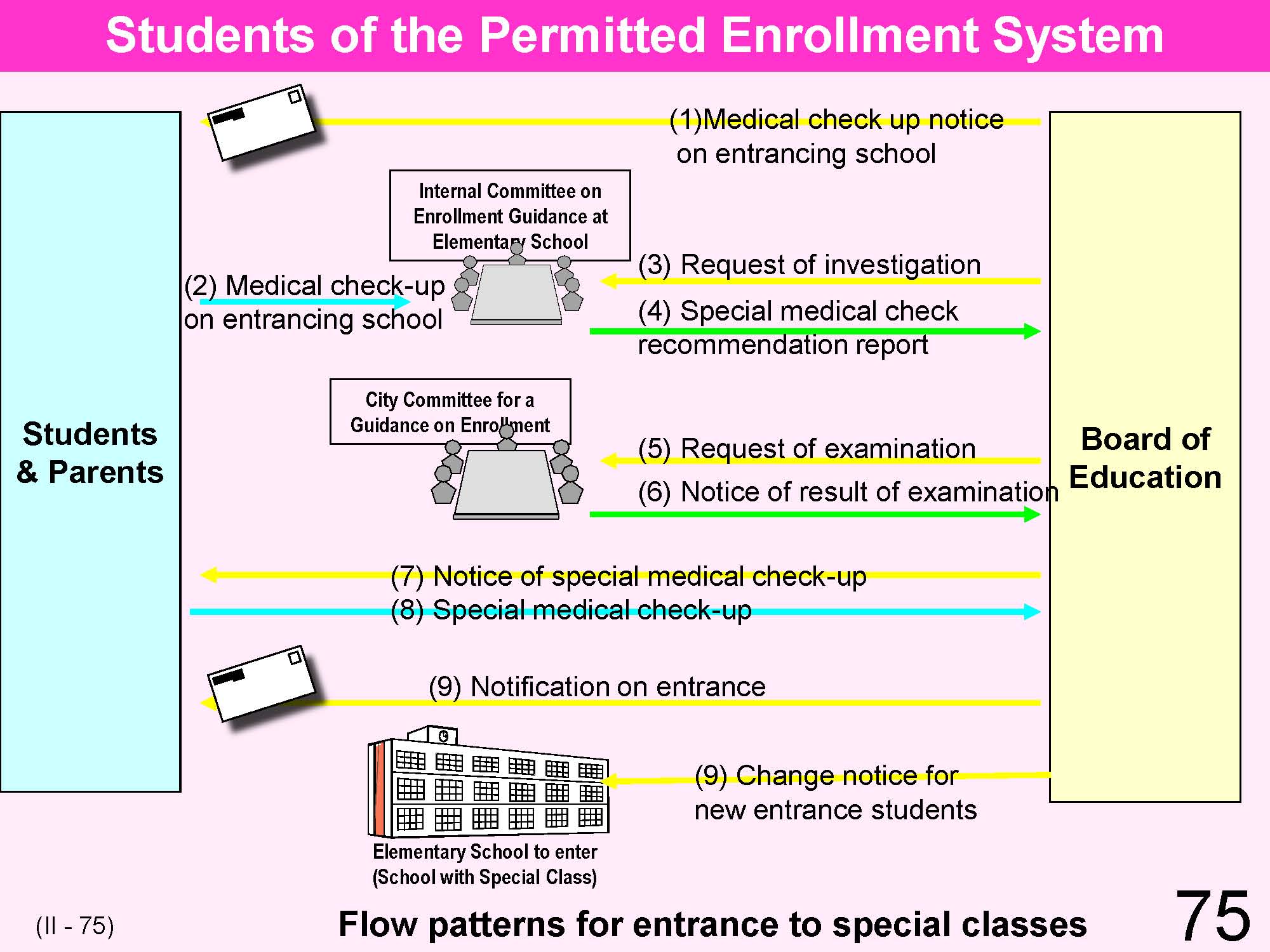 |
There are some cases of disputes between challenged students’ parents who wish to send their children to ordinary schools and the boards of education that recommend them to attend schools for the challenged that are designed to meet their special needs. In order to carry out guidance and to ensure smooth enrollment, it is important that the boards of education provide opportunities for confidential educational consultation for the parents. This can be done when initial contacts are made with principals of schools, where both parties can listen to concerns and help to build up mutual trust in their relationships. Such trust can help facilitate accurate judgments on which type of school is appropriate for individual students to enroll in, based on mutual understandings and cooperation with the parents. |
| 76 | 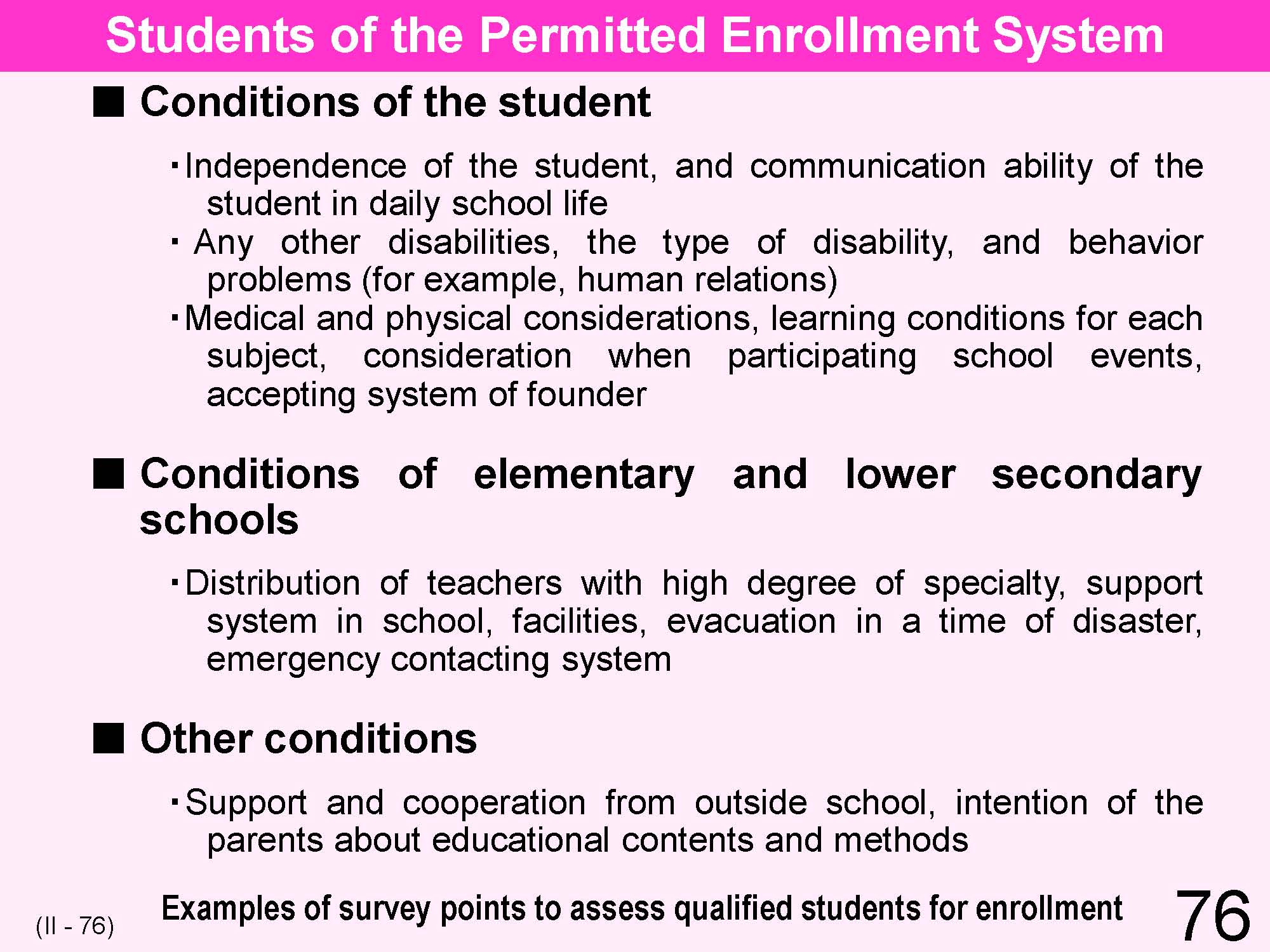 |
|
| 77 | 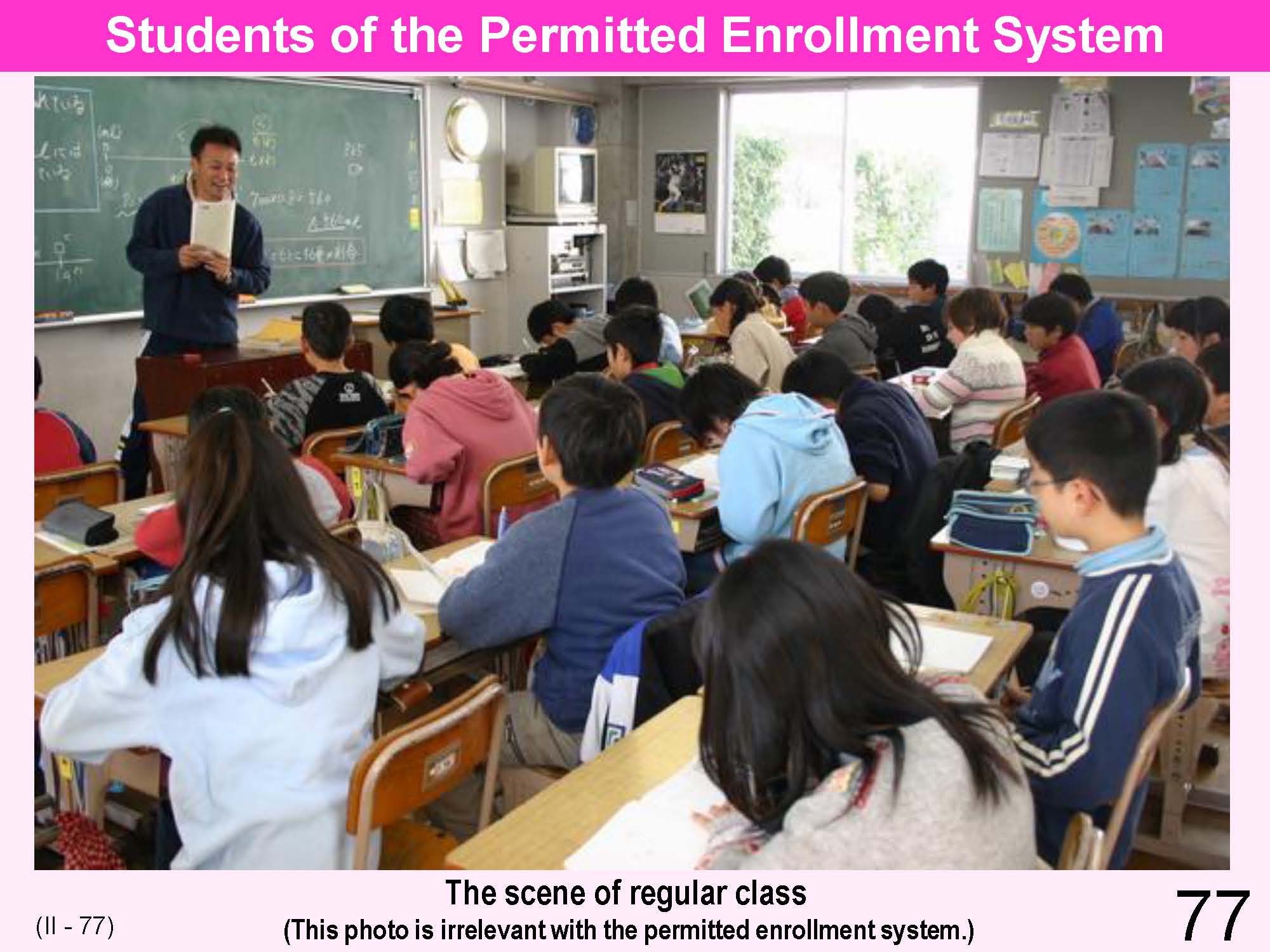 |
Promotion of mutual understanding is encouraged through exchange and collaborative learning between challenged children and children without impairment, when children with impairment are expected to take positive action and to live a spiritually rich life as a member of the local community. The Ministry of Education, Culture, Sports, Science and Technology has created an exchange and collaborative learning guide to promote exchange and collaborative learning among children with and without impairment at elementary and lower secondary schools. |
| 78 | 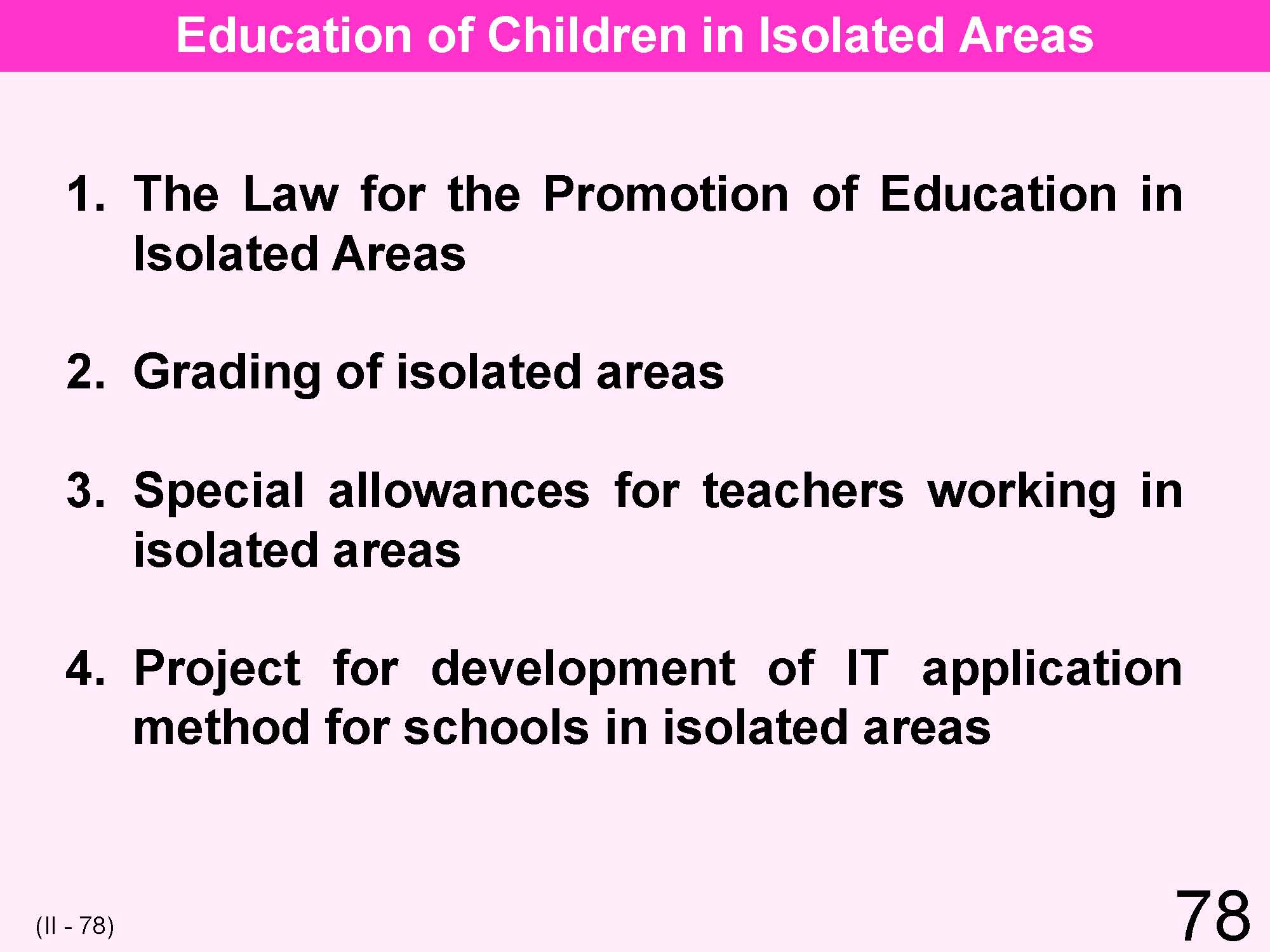 |
The aim of the Law for the Promotion of Education in Isolated Areas: Improvement in standards of education in isolated areas through policies that the Government and regional bodies must implement to promote education for children in isolated areas based on the intention of equal opportunities in education and in view of the need to accommodate specific circumstances of isolated areas. |
| 79 | 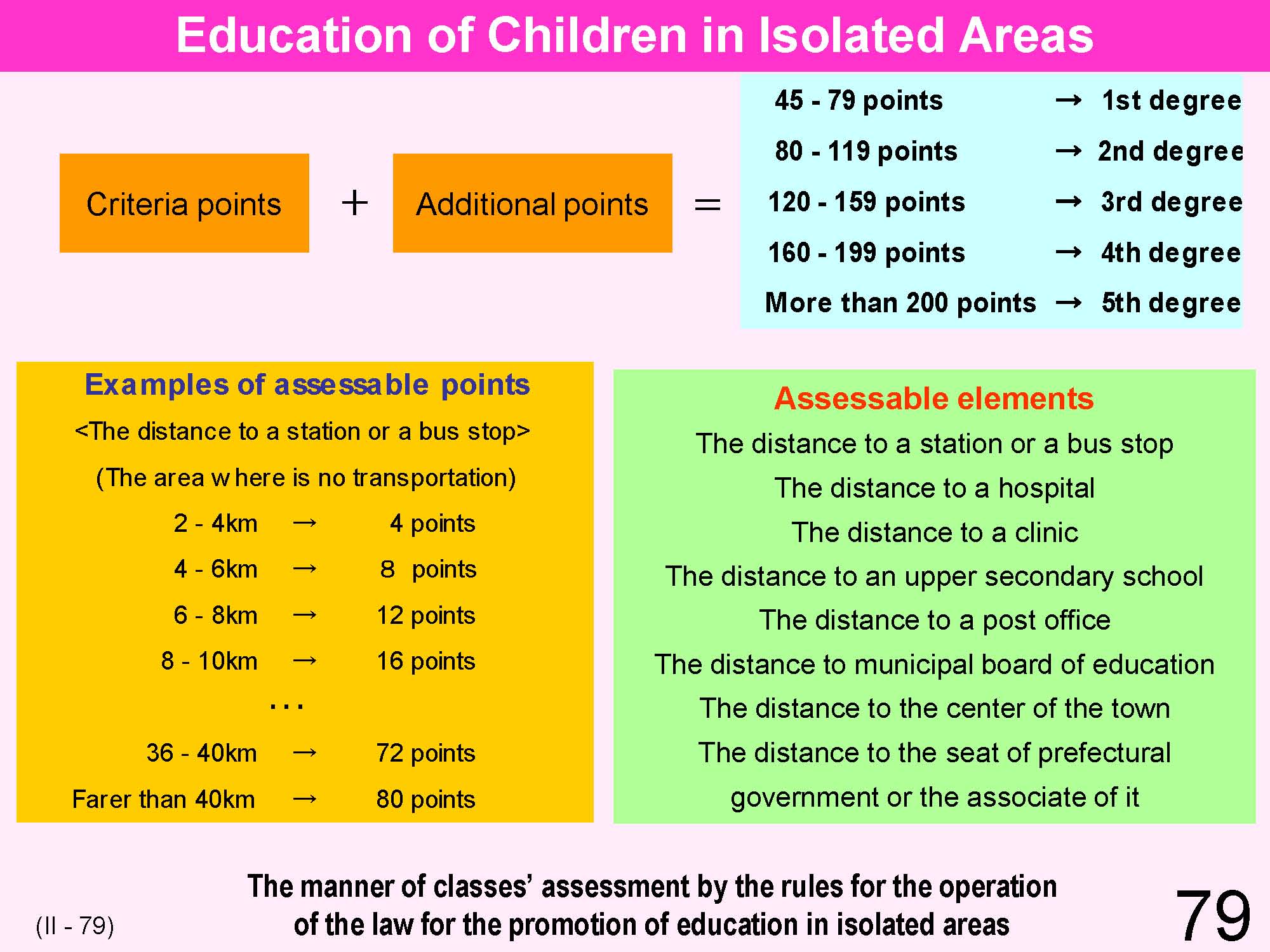 |
To assess a school district’s degree of isolation, the points linked to specific criteria are calculated by totaling up points for each factor. To assess the extent of relative isolation that is difficult to figure out by using only normal criteria, additional points are added when the schools in question have difficulties to administer education due to specific conditions. These include the absence of facilities to draw or to supply water if the district relies on rain or river water as drinking water resources. |
| 80 | 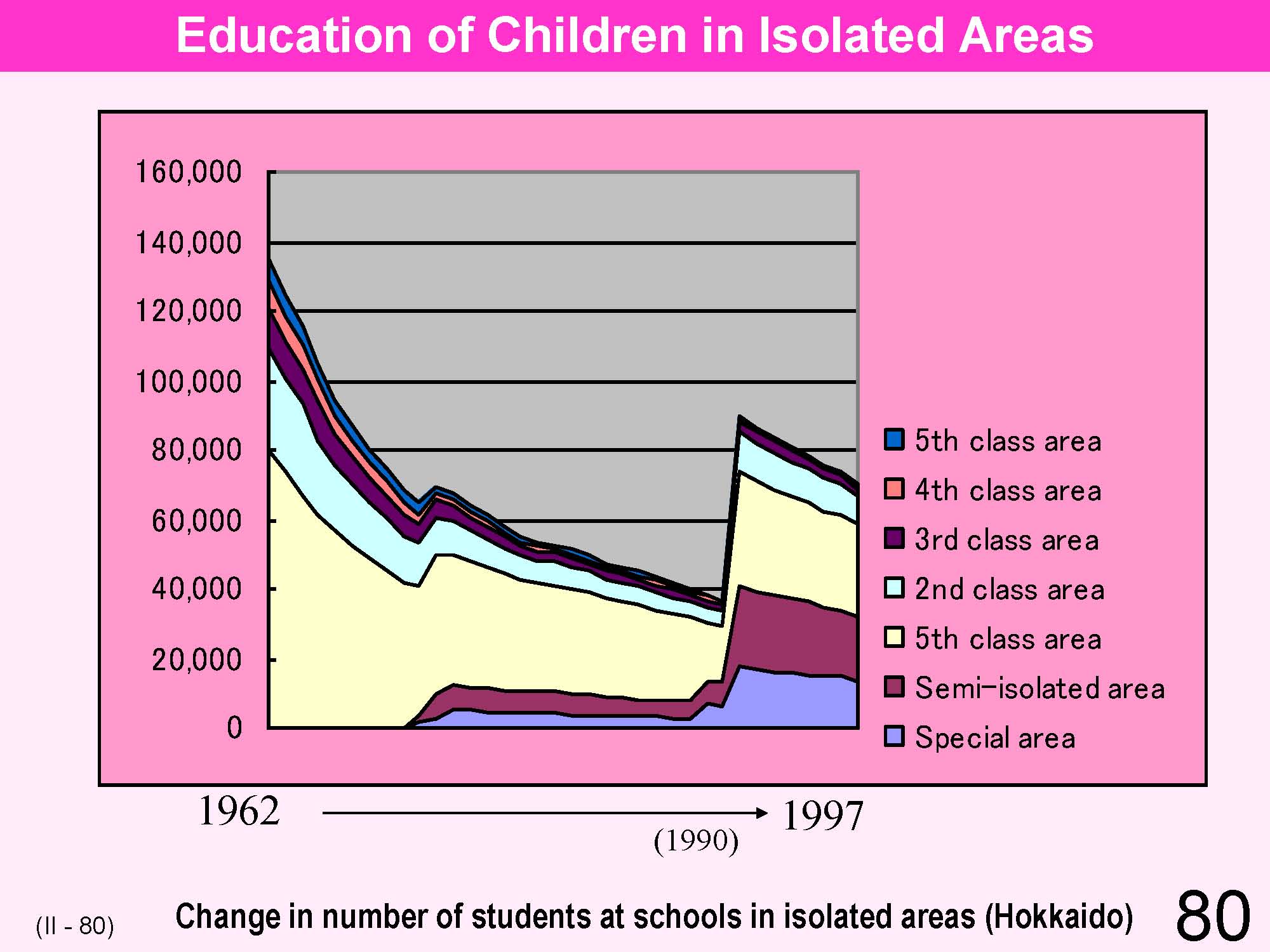 |
Although the number of isolated-area schools increased with the revision of the criteria for designation of local areas in 1990, it is now decreasing gradually. However, in Hokkaido and Kagoshima Prefectures, the percentage of the isolated-area schools is over 40% at both elementary and lower secondary schools. -->Figure: http://www.pref.niigata.jp/sec40/ja/tyouki/20zu.gif |
| 81 | 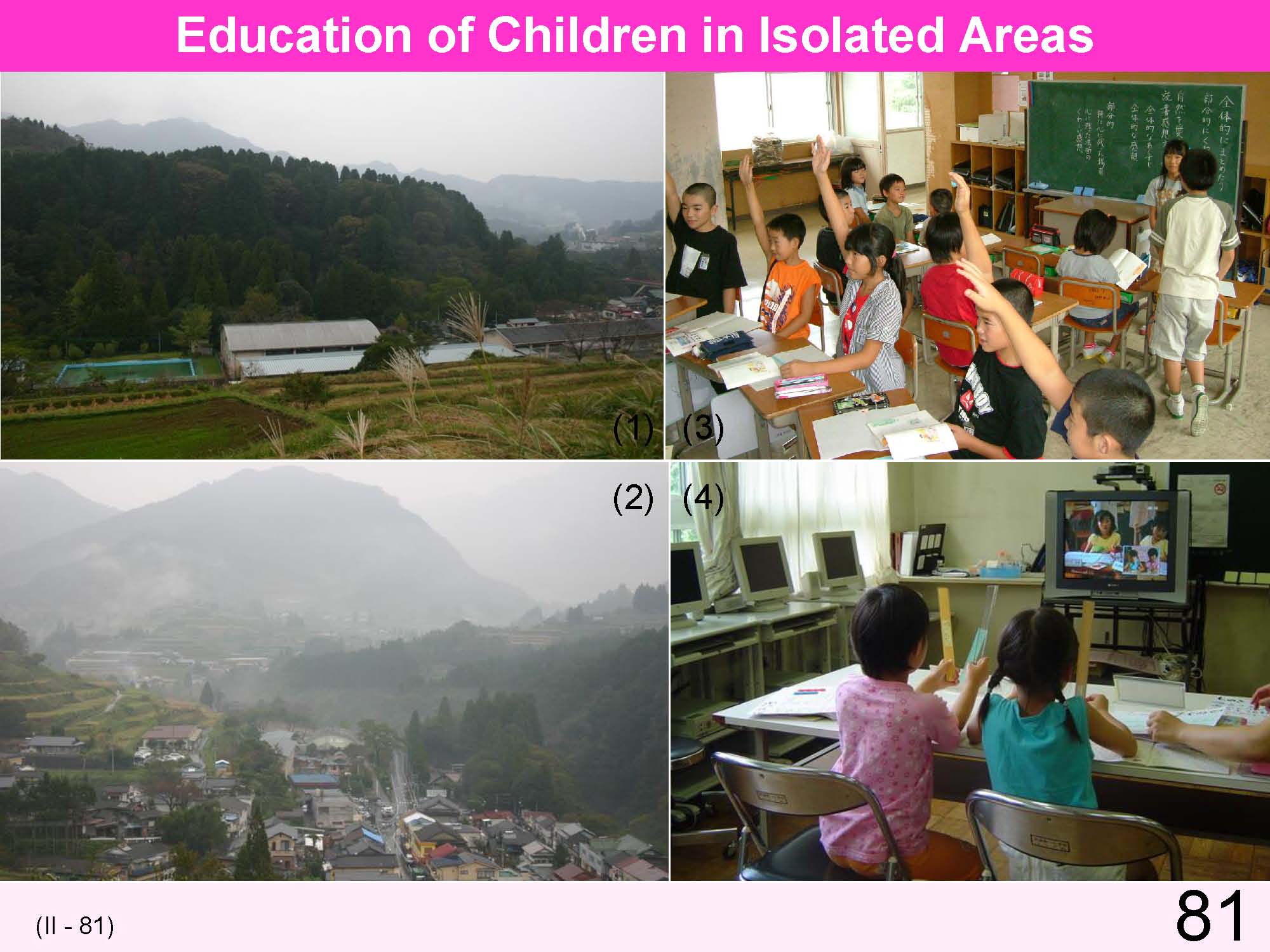 |
In addition to the Law for the Promotion of Education in Isolated Areas there are additional provisions concerning educational development and improvement of isolated areas in Japan in the Law on Promotion of Isolated Islands, the Special Treatment Law on Activation of Isolated Area, and the Special Treatment Law on Measures for Areas of High Snowfalls. Educational Development is regarded as an important element of the Comprehensive Area Development Plans. (1)An elementary school in an isolated area, October 2004 (2) An elementary school in an isolated area with a pool and gymnasium, October 2004 (3) Multi grade class, 2003 (4) Joint lesson by TV among three elementary schools, 2nd grade, Arithmetic, July 2004 |
| 82 | 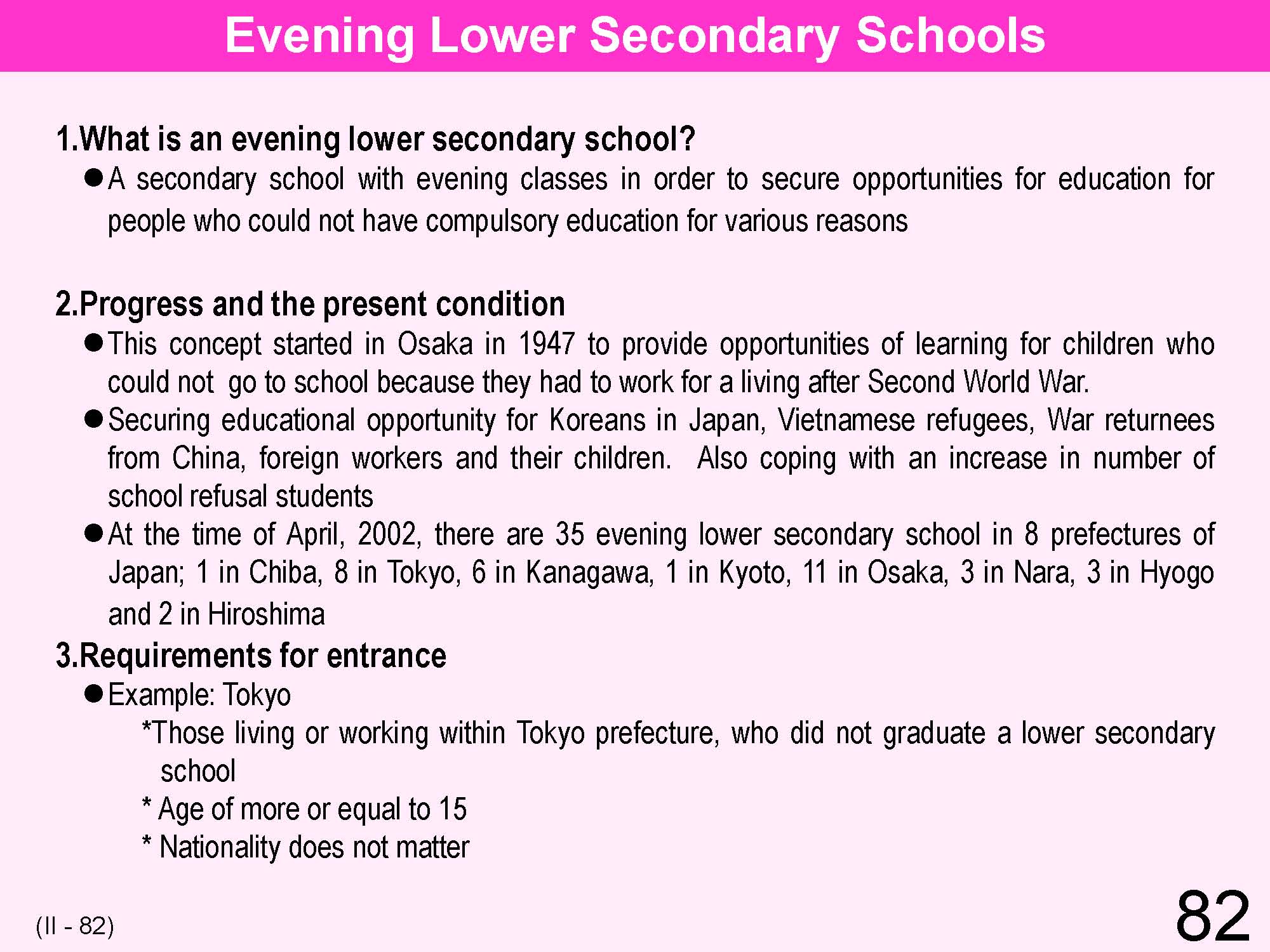 |
Evening lower secondary schools in Japan started amid the confusion after World War II, and were first established in Osaka in 1924 to offer a place to study for children who had to work to live and could not go to school. Then the concept spread throughout Japan. The student age range is wide, varying from teens to people in their eighties, and including people who could not get educated for various reasons, such as Korean Japanese, and recently, repatriates from China, refugees, and increasing numbers of foreigners. Evening lower secondary schools represent an important place for them to study Japanese. |
| 83 | 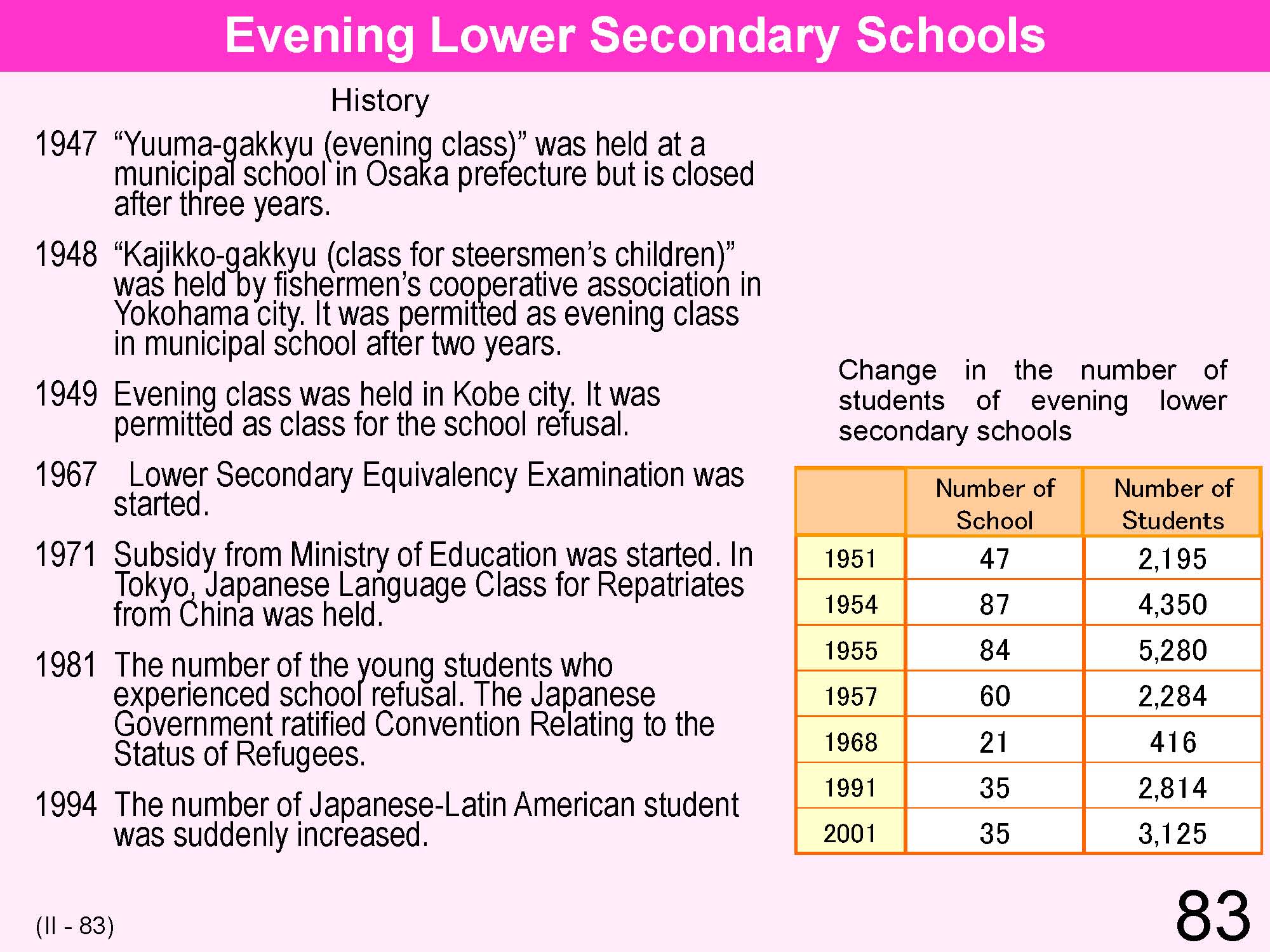 |
In 1955, the number of evening schools in Japan was over 84 and the number of students was over 5,000. By 1968, the number of students had decreased to 400 under a government policy which aimed to stabilize society and make evening lower secondary school students study in the daytime. As of April 2002, however, there are 35 schools attended by around 3,000 students nationwide under the movement to establish evening schools. In 1971, a subsidy from MEXT (Ministry of Education, Culture, Sports, Science and Technology) for evening schools and classes started and Japanese Language Classes were held for repatriated Japanese from China. By 1994, the number of Japanese-Latin American students who studied at evening schools had rapidly increased from previous levels. Since the beginning of 1980s, the number of dropout students attending such schools has been increasing. (Website of evening school: http://wwwsikasenbey.or.jp/~jkobi/yatyu.htm) |
| 84 | 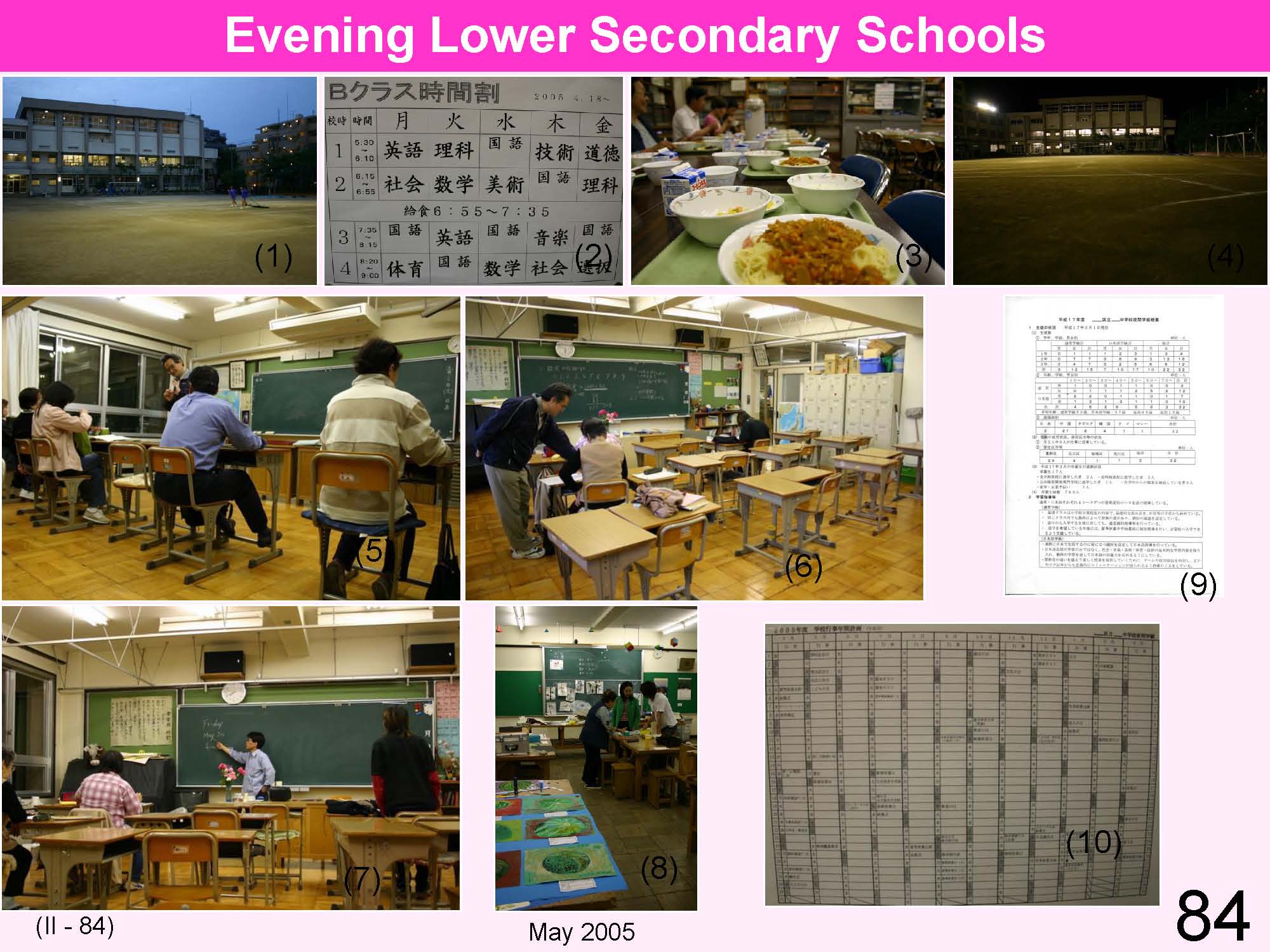 |
It is reported that the proportion of students at evening lower secondary schools is Japanese (22.1%), Korean Japanese (26.7%), repatriates (32.2%), refugees (1.5%), immigrants (0.5%) and other foreigners (16.7%) (as of September, 2002). (1) 6:46 PM. Some full-time course students have almost finished cleaning up the school yard after club activities. (2) School time table. (3) School lunch. (4) 4th lesson hour. (5) Japanese (E class= 1st grade, ordinary class). (6) Arithmetic (D class= 3rd grade, Japanese class). (7) English (D class= 3rd grade, Japanese class). (8) Art class. (9) Outline of classes. (10) School events |
| TOP | ||
Please send your comments and concerns here
kamada@criced.tsukuba.ac.jp
Center for Research on International Cooperation in Educational Development (CRICED) University of Tsukuba
1-1-1, Tennodai, Tsukuba-shi, IBARAKI
305-8572 JAPAN